





JUN 23 // COUNTRYROADSMAG.COM 2



// JUN 23 3 18TH ANNUAL CELEBRATION DINNER FIREWORKS MUSIC TUESDAY, july 4 • 7–10 pm LIMITED SPACE BUY TICKETS TODAY! CELEBRATE & SUPPORT ART! FOOD PROVIDED BY TSUNAMI. 6TH FLOOR | SHAW CENTER FOR THE ARTS | downtown baton rouge, la RAIN OR SHINE EVENT / TICKETS REQUIRED / TICKET SALES FINAL / NON-REFUNDABLE scan qr code or buy at www.lsumoa.org FRIENDS OF THE LSU MUSEUM OF ART
REFLECTIONS
Two cans and a piece of string
by James Fox-Smith
NEWS & NOTEWORTHIES
24
A world record, zero-waste alligator fashion design, frogsongs & the Art-o-Mat 38
Events
11
GOT THE JUNE BUG?
Suss out your summer plans for festival-going, art-viewing, and beyond.
REINTRODUCING THE WHOOPING CRANE
For one of the rarest birds in the world, conservation culminates in epic love stories by Christopher
Staudinger
HOW RANCHING SAVED THE AMERICAN ALLIGATOR
The story of the pre-historic reptile’s resurrection in Louisiana by Kristy
 Christiansen
Christiansen
WHAT HAPPENS INSIDE THE BOX
Behind-the-scenes of the latest study on Wood Ducks and their nesting habits
by John Flores
On the Cover
“THREE LITTLE BIRDS, SHELL GINGER”
Painting by Michael Guidry
When New Orleans artist Michael Guidry was growing up, his parents’ backyard was flush every summer with the cascading sprays of Shell Ginger, its spicy perfume permeating the air.
Today, the flowers arise in Guidry’s paintings whenever he wants to incorporate a sense of “home” in a particular tableau. It is fitting, then, to discover in “Three Little Birds” the blooms framing some of Louisiana’s most iconic birds, Great White Egrets—beauties that survived the Victorian era’s plumage fad (to the detriment of an estimated ninety-five percent of their population) to become one of our home’s most successful and symbolically important bird populations, a testament to the power of concentrated conservation efforts.

In this year’s “Our Natural World” issue, we hone in on the ongoing work of wildlife conservation in Louisiana: from the global success story of the American alligator (page 38), to the avante-garde exploits employed to usher in new generations of the oh-so-rare whooping crane (24), to 900 acres of land in Folsom where herds of the world’s most critically endangered exotic species—Pere David’s deer, giraffes, and bactrian camels—roam free (44). In these stories, we meet scientists and wildlife enthusiasts who are dedicating their lives to ensuring the animals that are so central to our region’s identity endure, often by seeking out new ways to make our world a better home for them.

Cuisine Culture
36
Publisher James Fox-Smith
Associate Publisher
Ashley Fox-Smith
Managing Editor Jordan LaHaye Fontenot
Arts & Entertainment Editor
Alexandra Kennon Creative Director
Kourtney Zimmerman
Contributors:
Kristy Christiansen, Paul Christiansen, Ed Cullen, John Flores, Cheryl Gerber, Paul Kieu, Mimi Greenwood Knight, Sophie Nau, Christopher Staudinger, Chris Turner-Neal Cover Artist Michael Guidry
Advertising
SALES@COUNTRYROADSMAG.COM
Sales Team
Heather Gammill & Heather Gibbons
Advertising Coordinator
Melissa Freeman President Dorcas Woods Brown Country
Escapes
HUNGRY EYES
Mason Hereford does fine dining, with an ‘80s twist by Sophie Nau
38
SEASON TO SEASON, HAND TO HAND 4 Generations of Louisiana Herbalists
by Mimi Greenwood Knight
42
THE RISE OF THE E-BIKE
The ins and outs of the electric cycling trend by Ed Cullen
Perspectives
“THERE’S SO MUCH LIFE”
Michael Guidry’s Louisiana
nature series by Jordan LaHaye Fontenot
44
NEW BEGINNINGS AT THE GLOBAL WILDLIFE CENTER
Revisiting Folsom’s wildlife preserve by Alexandra Kennon
49 THE TOP OF THE TRACE
Heading South, Tupelo-bound by Chris Turner-Neal
50 DA BAYOU EXPERIENCE
A fisherman’s haven on Grandpaw Bayou by Kristy Christiansen
Painting: “Salutation #1” by Michael Guidry.
JUN 23 // COUNTRYROADSMAG.COM
40 // ISSUE 6 JUNE 2023
Contents VOLUME
Saint Charles Street Baton Rouge, LA 70802 Phone (225) 343-3714
(815)
for 12
24
Roads Magazine 758
Fax
550-2272 EDITORIAL@COUNTRYROADSMAG.COM WWW.COUNTRYROADSMAG.COM Subscriptions $21.99
months $39.58 for
months
All rights reserved. No portion of this publication may be reproduced without permission of the publisher. The opinions expressed in Country Roads magazine are those of the authors or columnists and do not necessarily reflect the views of the publisher, nor do they constitute an endorsement of products or services herein. Country Roads magazine retains the right to refuse any advertisement. Country Roads cannot be responsible for delays in subscription deliveries due to U.S. Post Office handling of third-class mail.
ISSN #8756-906X Copyrighted.
8
40
6
Features Introduction 54
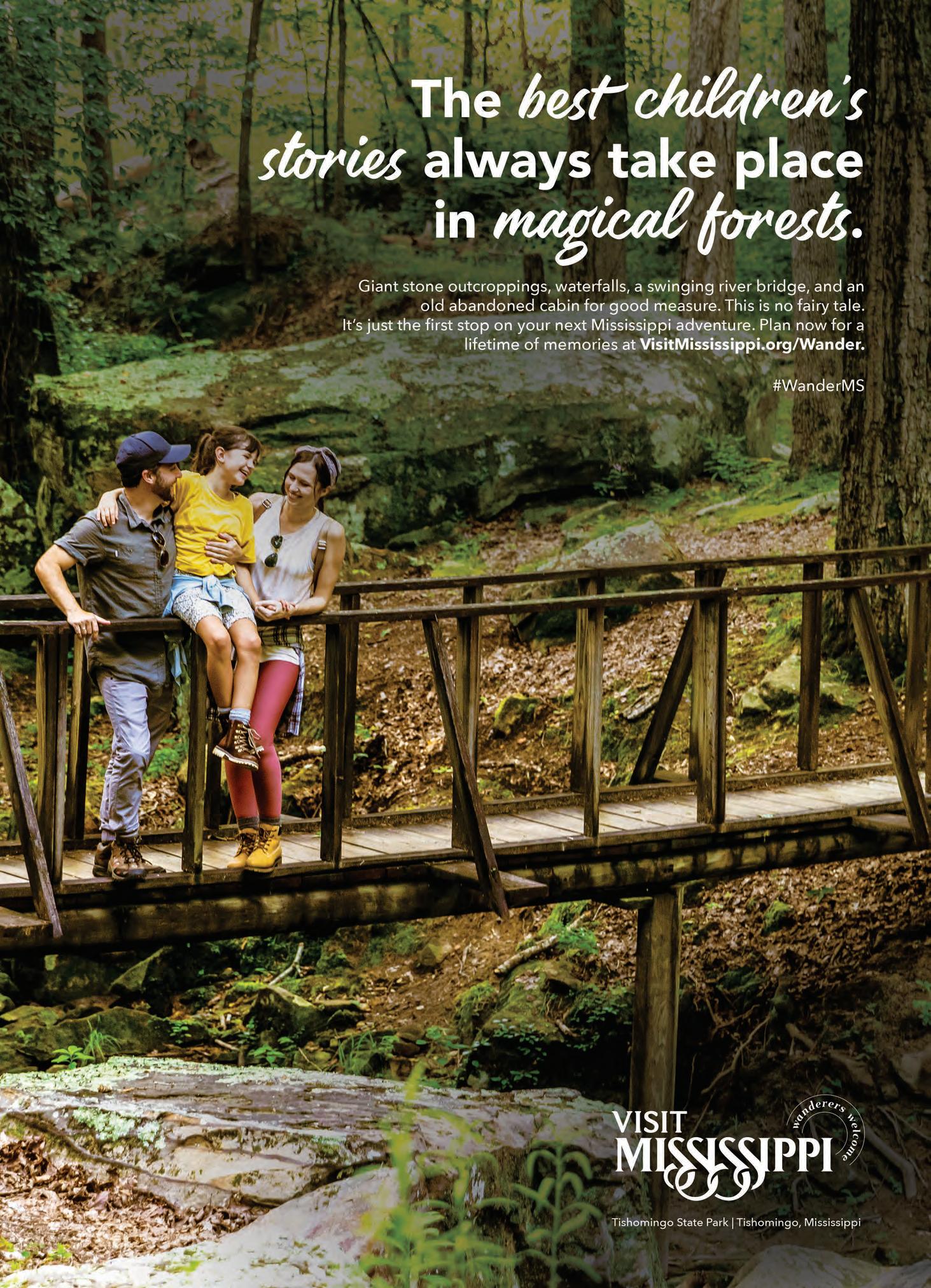
// JUN 23 5
Reflections
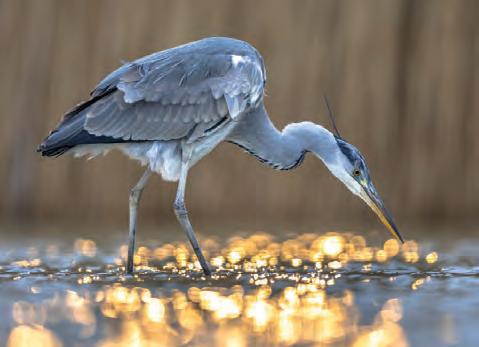
FROM THE PUBLISHER

Last month our internet stopped working. Not for a few minutes or an hour, but for good. One Monday morning we woke up and it was just … gone. Apparently, the cellular provider from whose distant tower came the faint signal upon which our wireless internet depended had made a network change that rendered our system obsolete. I learned this from the rather fly-by-night operator who sold us the system when I finally reached him by cell phone— something I had to drive five miles from the house to do, since the rural corner of West Feliciana parish where we live has yet to come to the attention of America’s cellular providers. “Oh yeah,” said Mr. Fly-By-Night, “I thought something like that might happen,” before explaining that getting service back would require the purchase of new hardware, which in any case, he wouldn’t be available to install for at least a couple of weeks.
Since we live in a place hopelessly beyond the reach of normal broadband,




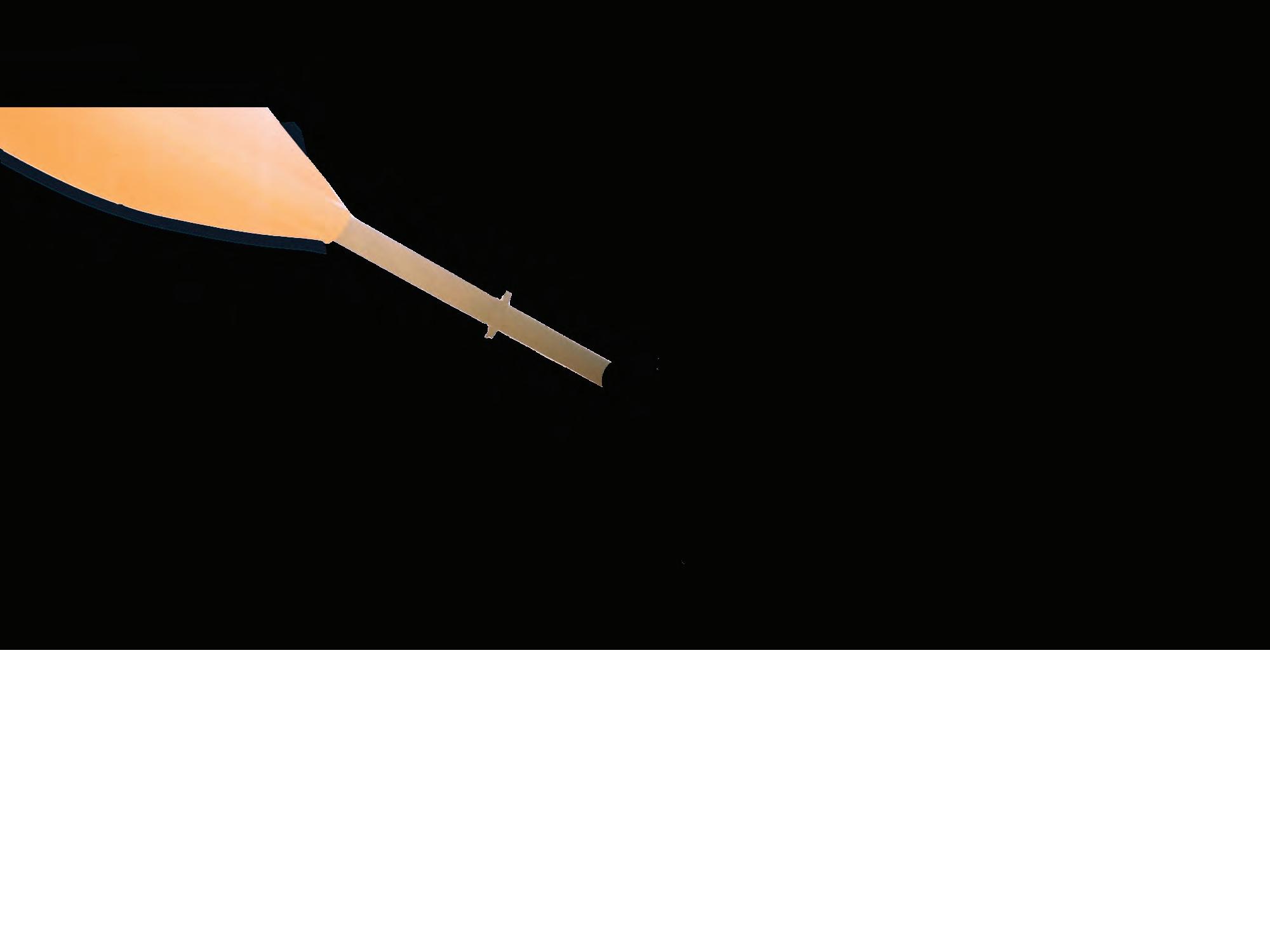

course, but also gone was the ability to make a phone call, send a text, shop online, pay a bill, or have any idea what the weather would do tomorrow. The flaw in our working-remotely-from-home plan was instantly apparent. There wasn’t even broadcast TV, since we’d never gotten around to putting an antenna back on the roof after the original blew down during Hurricane Ida (or was it Laura?) a few years ago. Actually, the only device still receiving signals from the outside world was a twenty-five-year-old clock radio, through which the soothing sounds of National Public Radio continued delivering assurance that modern life persisted, somewhere. The day the internet went down the remaining teenager came home from school, regarded the situation with horror, and decamped to his grandmother’s house, which ironically has excellent internet. After that, things got very quiet indeed.
Like most people in the developed world, I suppose, we’ve been taking the internet for granted for a long time. As the years have gone by and the communication, commerce, and entertainment supply chains have moved online, like the proverbial frog in a kettle we have settled progressively deeper into the warm



watch or music to listen to, with no online articles to read or social media rabbit holes to fall down, we felt a palpable sense of withdrawal that no hard-bound book or deck of cards seemed able to assuage. But then, after a night and a day in this digital deprivation chamber, something interesting started to happen. On the second internet-free morning, up early and unable to answer emails, read news, or do the other things that I imagine important enough to get up before dawn to do, instead I found myself sitting with a cup of tea and a couple of dogs on the back steps, watching a lone firefly dawdle through the dark, when the bird chorus started up. As the first light crept in from the east, the night music of crickets and frogs was gradually replaced by a swelling crescendo of birdsong that increased in vigor and complexity as one species, then another, joined the fray. The volume built with the brightening sky, until there
was enough light that I was able to start putting faces to songs, as it were, spotting summer tanagers, wood pewees, cardinals, a redstart, and an Eastern towhee, amongst others too various and numerous to name. Of course I’ve noticed this morning chorus before, but with ninety percent of my attention focused on all the things modern life tells us are “important,” I’m not sure I’d ever truly stopped to listen.
It couldn’t last of course, since living off-grid is hardly compatible with running a media company in the twenty-first century. So now, borne on the wings of a Starlink satellite receiver, all the conveniences and distractions of the modern world have returned to our remote corner of West Feliciana. Sure, the internet brings the full sum of human knowledge, achievement, and endeavor within easy reach. But in the glare of such abundance, how much of nature’s miracle is eclipsed? While the lesson is still fresh, I’m trying to remember that, for each digital bauble the modern entertainment ecosystem confers, a naturally-occurring,
#Biking
#Golfing
#Fishing
#Birding
A Special Advertising Feature from the Arts Council of Greater Baton Rouge


Where the Wild Things Are
ThroughasummerBugBootCamp,artist/biologistBrandonBallengéeishelpingBatonRougekidsgetinspiredbythebiodiversityallaroundthem
The question elicits a few strange looks, and a whole bunch of giggles.
“Have you ever eaten a dinosaur?” asks artist and conservation biologist Brandon Ballengée. His audience is a group of elementary and middle school kids gathered for the Arts Council of Greater Baton Rouge’s recent Artsplosion camp.
“No!” the campers squeal. “Of course not!”
But Ballengée gently protests.
“I think you have,” he says. “Raise your hand if you’ve ever eaten at Popeye’s.”
Hands, of course, shoot up. The kids wait expectantly to hear exactly how dinosaur might have been slipped into their Popeye’s kids meals.
“You’ve eaten chicken, right?” Ballengée says. “Chickens are birds, and birds are dinosaurs.”
To the children’s delight, Ballengée explains that birds spring from the same evolutionary family tree that includes none other than the most infamous dinosaur of them all, Tyrannosaurus Rex.
It’s an “a-ha” moment the campers won’t forget, and it’s one of many that happen throughout the day as Ballengée and his wife Aurore weave a tapestry of biology, storytelling, and art into their weeklong
session, which is held at the Cary Saurage Community Arts Center in downtown Baton Rouge. Known as Bug Boot Camp, the event focuses on a different class of animals every day, such as mammals, insects, and birds. Using fun and sometimes zany methods, the Ballengées help kids discover and interpret the natural wonders present in their own backyards.
“Our goal is to get people inspired by biodiversity and the ecosystems around us,” said Ballengée, a former New York City-based artist who says he and his wife, a native of France, were drawn to Louisiana for its wild natural wonder and Francophone culture.
programs, which taps notable regional artists to share their talents during camps, in public school classrooms, and through community projects.

“Our education programs bring top-notch arts programming to kids in our region, while also enabling professional artists to work,” said Education Programs Manager Marie Flowers. “We are so excited about the programs Brandon and Aurore are bringing, which connect the arts with science.”
On the day the kids learn about birds, the couple leads them through multi-sensory arts projects that include painting portraits of their own original “dino-birds,” constructing bird masks, and strutting around the room wearing bird-inspired fashion items. Aurore Ballengée also shows them how to make tasty bird food for their backyard friends.
The Ballengées are so devoted to spreading engaging science and arts education that they have established their own nature preserve outside Arnaudville, Louisiana, where they also live and are raising their two young children. Through the Arts Council and with financial support provided by Shell, they’ve taught workshops to children at Park Forest and Ryan Elementary Schools and will soon do the same in Ascension Parish. Brandon also provides professional development training for teachers, demonstrating effective ways of getting kids excited about the urban natural environment.
Soon, Baton Rouge will also be able to enjoy public art created by Brandon. He’ll be installing a 12x15 foot aluminum and metal sculpture of a swallowtail butterfly in the Renoir Arts and Cultural District, with funding through a partnership with East Baton Rouge Housing Authority and Partners Southeast. The sculpture has glow-in-thedark features that will attract native insects at night— just another charming example of Ballengée’s mission to fuse art and nature.
“We live in such a special part of the universe,” he said. “It’s great to be able to teach kids to care about these places and our natural heritage.”
// JUN 23 7
“Kids are naturally drawn to animals, so that’s what we use to help them become more conscious of the world around them.” —Brandon Ballengée
2296 Miles: 17 days, 19 hours, 46 minutes
DOWN THE MISSISSIPPI RIVER
As of Tuesday, May 23, long distance paddlers Scott Miller, Paul Cox, Wally Werderich, and Judson Steinback are furiously tracing their way down the Choctaw Bend on the Arkanasas/MIssissippi border, with over 1700 miles of Mississippi River behind them. This is the thirteenth day they’ve been on the water, taking turns sleeping, fighting fog and storms and ice and heat and the frustratingly unavoidable delays of the River’s locks and dams. So far, they are moving at a pace twenty-five hours faster than the standing Guinness World Record for “Fastest Time to Row the Length of the Mississippi River by a Team”. But they still have a long way to go to the mouth, and about a million things could go wrong.

Miller knows this well, this being his second attempt at beating the record. In 2021, he and his previous team had all but stuck the landing—making it almost all the way to New Orleans, barely 100 miles to the finish line and set to overtake the previous record (set just weeks before by “rival team” MMZero) of 17 days, 19 hours, and 46 minutes, when a violent storm forced the team to abandon ship.
Newly equipped with a souped-up boat with a new rudder, bilge pump, and battery; a Nascar-pit-crew-style Support Team of over twenty following behind in boats and on-land delivering home-made meals, water, batteries, and fresh clothes when needed; and a worldclass paddling team with tens of thousands of miles of experience between them—Miller hopes to finally finish what he started.
“He’s doing everything right,” said Todd Foster, a close friend of Miller’s who has been acting as lead advisor on the operation and sharing frequent updates on the Mississippi Speed Record Facebook Page. “The whole team is. They’re in a good spot right now. I think they have a very, very good shot. But at the end of the day, it’s going to be the river that decides if the record is broken or not.”
To break the Guinness World Record, the Mississippi Speed Record team has to arrive at Mile Marker Zero at Head of Passes near the river’s mouth by May 28. If all goes according to plan, folks in Baton Rouge and New Orleans should be able to cheer them on from the levees sometime between May 25–28. Keep up with the team’s progress on their Facebook Page and Youtube Channel, and track their real-time location and race times on their website mississippispeedrecord.com.
—Jordan LaHaye Fontenot
BTR, Meet Art-o-Mat
Chips, candy, sodas—when most picture traditional vending machines, these are the options awaiting behind the plexiglass. But these days, particularly in airports, vending machines have enjoyed some major upgrades that now include cosmetics, phone chargers, and more.
But how about artwork? As of May 9, when visitors arrive through the Baton Rouge Metropolitan Airport, they’ll be greeted by a new custom Art-o-Mat: a vending machine that dispenses small works of original art.
Created in collaboration with the BRG@BTR Gallery that opened in October 2021, travelers and residents flying into Baton Rouge will encounter
local art instantly upon their arrival— hopefully setting a tone for the rest of their stay.
“The BRG@BTR gallery and Arto-Mat installation are giving travelers the opportunity to enjoy art just minutes after they’ve stepped off a plane,” said Laura Cating, Visit Baton Rouge’s Senior Vice President of Marketing & Communications. “This starts their visit off in an impactful way and leaves a lasting positive impression of our city.”
Started when artist Clark Whittington repurposed a cigarette vending machine for an art exhibition in 1997, today there are hundreds of Art-o-Mats around the country. Now, in addition to the machine inside the Baton Rouge Gallery’s flagship, small pieces of art
The Amphibian Suite
UNIVERSITY STUDENTS LISTEN IN, AS PART OF THE LOUISIANA AMPHIBIAN MONITORING PROGRAM
Growing up in rural Louisiana, whenever we heard a noise at night that didn’t quite sound like anything else—we dubbed it a frog. The clicks, chirps, peeps, and snores of Louisiana’s frog population form a strange and entrancing chorus all its own, but scientists have long feared that the orchestra may be diminishing in volume.

In 1996, the Louisiana Department of Wildlife and Fisheries responded to global concerns about the decline
in amphibian species by forming the Louisiana Amphibian Monitoring Program—a mostly volunteer initiative aimed at collecting data on Louisiana’s frogs, toads, and salamanders.
Since 2005, Nicholls State University in Thibodaux has taken part in the program, giving students of biology and herpetology the opportunity to volunteer as data-collectors, and to learn more about Louisiana’s amphibian populations. This spring, students and faculty conducted surveys in the Choctaw swamp, Montegut, and the Falgout
will be easily available inside BTR.
“Airports are the face of the community to first-time visitors, and we want to make a good impression,” explained Jim Caldwell, Marketing, Public Relations & Air Service Development Manager for the Baton Rouge Metro Airport. “The art exhibits can reflect our region’s unique culture by showcasing the work of local artists for our passengers and guests. The airport is also a great location for artists to display their work to nearly a million people annually, many of whom are art enthusiasts.”
Between BRG@BTR and the new Art-o-Mat, visitors will now encounter elements of Louisiana’s unique culture before even leaving the terminal, according to President/CEO of Baton Rouge Gallery Jason Andreasen. “And we couldn't be more excited to have artists be a big part of the welcoming committee.”
—Alexandra Kennon
Canal with the assistance of biology professors Dr. Tim Clay and Dr. Gary Lafleur. Immersed in the swamp at night, when amphibians tend to be more active, students recorded the frog calls they heard, identified amphibians they could see, and measured the ones they could catch—all contributing vital information towards determining the current state of Louisiana’s amphibian populations. Species they observed included the Northern Cricket Frog, the Spring Peeper, the Green Tree Frog, the Southern Leopard Frog, the Pig Frog, and the Bullfrog.
To learn more about, or get involved in the Louisiana Amphibian Monitoring Program, visit louisianaherps.com.
—Jordan LaHaye Fontenot
JUN 23 // COUNTRYROADSMAG.COM 8 Noteworthy LOOK CLOSER NEWS,
• JUNE 2023
TIMELY TIDBITS, AND OTHER CURIOSITIES
THE RACE TO BEAT THE GUINNESS WORLD RECORD AS THE FASTEST TEAM TO ROW
The Mississippi Speed Record team, from left to right: Paul Cox, Judson Steinback, Wally Werderich, Scott Miller. Courtesy of the Mississippi Speed Record team.
NICHOLLS
































Supported in part by a grant from the Louisiana Division of the Arts, Office of Cultural Development, Department of Culture, Recreation & Tourism, in cooperation with the Louisiana State Arts Council, and the National Endowment for the Arts, Federal agency. FOR TICKETS: MANSHIPTHEATRE.ORG • 225-344-0334 LONG SUMMER NIGHTS AT MANSHIP THEATRE LONG SUMMER NIGHTS AT MANSHIP THEATRE LONG SUMMER NIGHTS AT MANSHIP THEATRE LONG SUMMER NIGHTS AT MANSHIP THEATRE AT MANSHIP THEATRE LONG SUMMER NIGHTS AT MANSHIP THEATRE LONG SUMMER NIGHTS AT MANSHIP THEATRE JUNE 9 JUNE 23 7:30PM WITH SPECIAL GUEST Known for her roles in Disney's The Mandalorian, HBO’s The Righteous Gemstones, Larry David's Curb Your Enthusiasm, and many more! Featuring Lisa McClowry as Cher
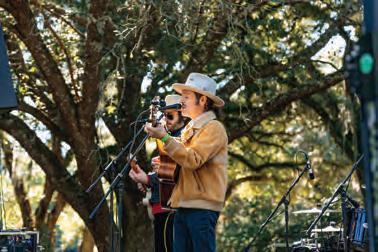


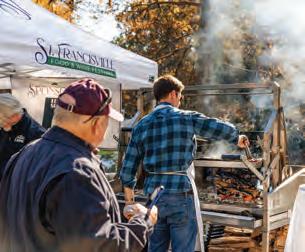
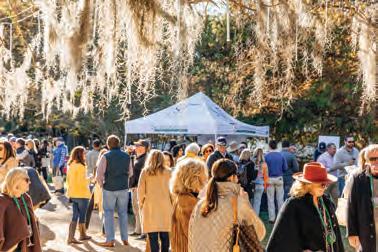

JUNE 23 // COUNTRYROADSMAG.COM 10 at the Myrtles, St. Francisville, LA Sunday, November 12, 2023 Celebrated Chefs • Artisanal Wines • Craft Beers & Ales • Craft Spirits • Live Entertainment NEW: Seated Wine Dinners Friday & Saturday Nights • AND MORE Enter by June 30, 2023 Winners will be drawn Monday, July 3 www.stfrancisvillefoodandwine.com WIN VIP Tickets to the Prize Package Includes • 2 VIP Tickets to the Sunday Food & Wine Festival • Overnight Accommodation for 2 at The Myrtles Package Value: $540*
here! * Terms & Conditions apply. For details, visit the link above
To enter, point your phone
Events


EMBRACE YOUR HERITAGE, READ A GOOD BOOK, CATCH A BIG FISH, OR BITE
JUN 1st - JUN 3rd
BASIN BASH
KROTZ SPRINGS SPORTSMEN'S HERITAGE FESTIVAL

Krotz Springs, Louisiana

Krotz Springs is a little town that has seen some disasters. Flood after flood— in 1927 and in 1973—devastated its citizens, but it only seemed to strengthen their deepening roots. After the flood of '73, many residents took to crawfishing because the floodwaters made them plentiful. After the Mississippi's waters rose once again in 2011, the town found itself evacuated, empty for the first time after such a threat. For whatever reason, many residents decided not to come back. The Krotz Springs Sportsmen's Heritage Festival is the remaining citizens' attempt to call back its former occupants and to reunite their resilient community by paying homage to their shared history, which is intrinsically tied to the Atchafalaya. Explore the heart of the basin in good taste with the Fur,
Feathers, or Fins cookoff and dance the night away to Cajun, Swamp Pop, and Zydeco tunes. Thursday's "Family night" is all rides, for $25 from 5:30 pm–10:30 pm. Friday's festival includes performances by Nik-L-Beer and Foret Tradition from 7 pm–11:30 pm; Saturday brings the 5K in the morning, followed immediately after by the cookoff and the Hammer Time Logan Stelly Memorial Corn Hole Tournament, plus live and silent auctions and performances by Alligator Blue, Chubby Carrier, and Krossfyre until 11:30 pm.


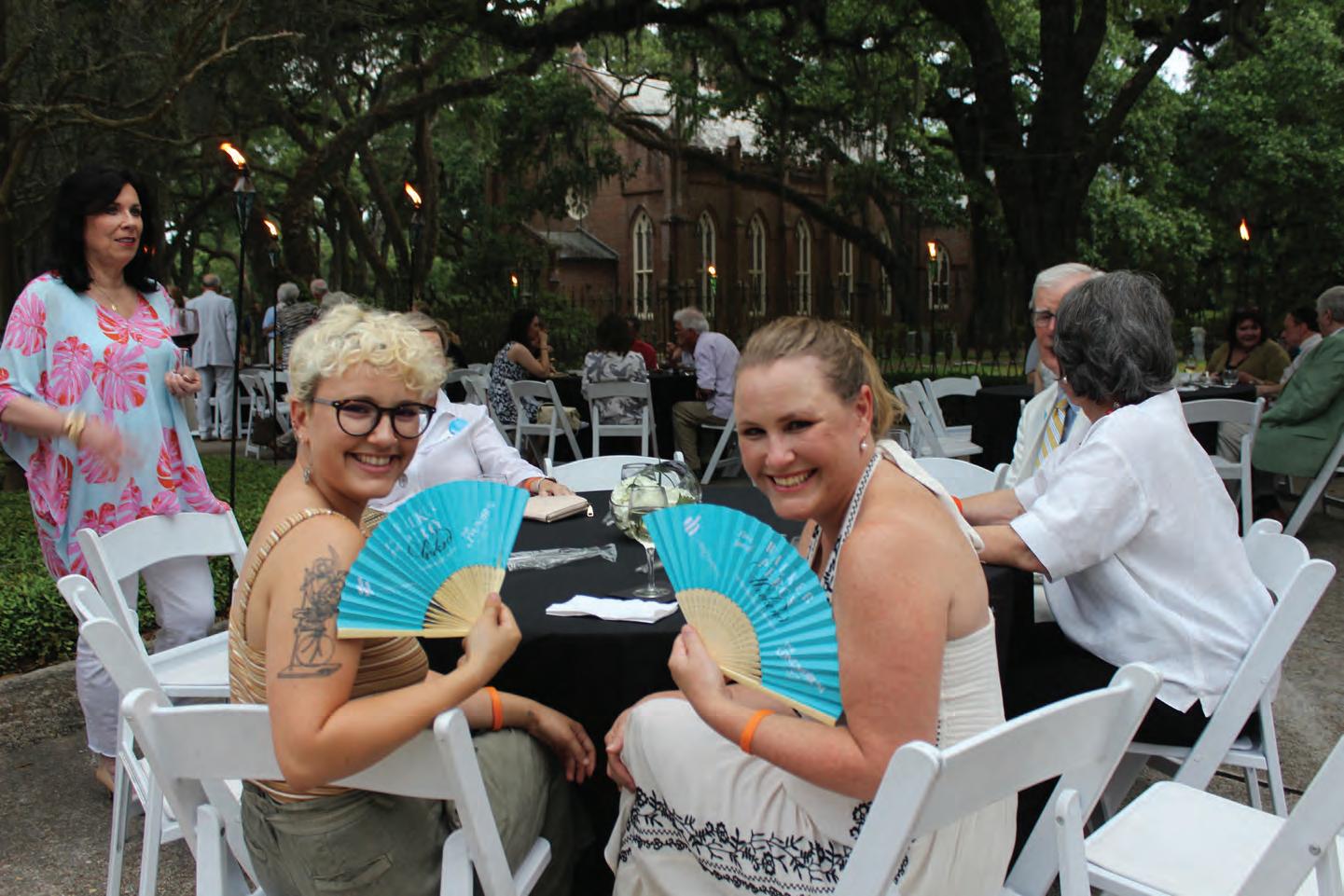
562 Front Street. Free.
kssportsmensheritagefestival.com. •

JUN 1st - AUG 15th
BOOK BONANZA
EAST BATON ROUGE PARISH
LIBRARY SUMMER
READING PROGRAM
Baton Rouge, Louisiana
This summer, the East Baton Rouge Parish Summer Reading Program
presents "All Together Now!" featuring an entire summer of free programs, workshops, storytimes, concerts, and more—designed with every age in mind. Young readers will earn rewards by tracking their reading, and can sign up at their local library location or online at ebrpl.beanstack.org. ebrpl.com.
JUN 2
ACADIAN ACTION CAJUN HERITAGE FESTIVAL Larose, Louisiana
The art and culture of wood carving is this festival's raison d'être, a celebration going on forty-six years now. There'll be a decoy show and auction, carving demos, duck calling, raffles and more. And with a name like Cajun Heritage, rest assured there'll be plenty of jambalaya and other traditional treats on hand. Inside the Larose Civic Center. Free. Details at the Cajun Heritage Festival Facebook page. •
//JUNE 23 11
JUNE IS BUSTIN' OUT
JUNE 2023
inspired Southern supper in the heart of historic downtown St. Francisville. See listing on page 12. Photo by Alexandra Kennon.
Events
Beginning June 2nd - June 3rd

JUN 2nd - JUN 3rd
BOOKS & BOURBON
WALKER PERCY WEEKEND
Saint Francisville, Louisiana
"Bourbon does for me what the piece of cake did for Proust," wrote iconic Southern author Walker Percy in 1975. There won't be any tea and cake served at the eighth annual Walker Percy Weekend, but with delicious Southern savories by the hundredweight and bourbon cocktails served throughout St. Francisville's historic district, no one will be starved for sustenance—literary or otherwise. Beloved for blending spirited literary discussion with spectacular social events, the Walker Percy Weekend fortifies attendees for a series of literary lectures and panel discussions with the finest Louisiana food and beverages. The festival invites fans of Southern literature to explore Percy's thought and writing through presentations by renowned scholars, panel discussions, and social and culinary events inspired by the author's most famous works. Events take place in atmospheric locations around St. Francisville's historic district. This year's featured
presenters include writers and thinkers Randy Boyagoda, Dave Duty, Michael Kobre, Read Mercer Schuchardt, Susan Cushman, Jennifer Davis, Brannon Costello, and Maurice Ruffin. Festival proceeds support the Julius Freyhan Foundation—an organization dedicated to restoring St. Francisville's historic Freyhan School building to serve as a community and cultural center for West Feliciana Parish. walkerpercyweekend.org. $245 for all access ticket at bontempstix.com. •
JUN
2 nd - JUN 4 th
GOOD EATS
BON MANGÉ FESTIVAL
Gheens, Louisiana
Down there in the Lockport neck of the woods, not too far from Lake Salvador, lies the community of Gheens, where the good folks host an annual 'good eats" festival featuring Cajun food, rides, and dancing—and a festival queen, of course. Live music performances by Junior Lacrosse and Sumtin Sneaky, Pah Tu La, Benjamin Bruce and The Acadians, Cully Cressionie, Shorts in December, Gary
T, and Freddie Rodrigue. Held at the Vacherie-Gheens Community Center at 1783 Highway 654 from 8 pm–midnight Friday; 11 am–1 am Saturday; 11 am–6 pm Sunday. Free admission. (985) 532-5740. •
JUN 2nd - JUN 4th RARE BLOOMS NEW ORLEANS ORCHID SOCIETY ANNUAL SHOW
Metairie, Louisiana
The New Orleans Orchid Society invites all enthusiasts of the pretty plants to venture to Lakeside Shopping Center for their annual show and sale, this year with the theme "Orchids, when flowers dream!" Friday and Saturday 10 am–9 pm, Sunday noon–4:30 pm. neworleansorchidsociety.org. •
JUN 2nd - JUN 4th
HOT AIR
BOGALUSA
Bogalusa, Louisiana
BALLOON FEST
A balloon festival that's full of more than just hot air: catch food vendors, live music, a carnival, and more at the George R. Carr Memorial Airfield. 5 pm–10 pm Thursday–Friday; 10 am–10 pm Saturday; 10 am–5 pm Sunday. $5; $7 for two-day pass. Details at the Bogalusa Balloon Festival Facebook Page. •
JUN 3rd FOOD FESTS DONALDSONVILLE WING FEST
Donaldsonville, Louisiana
Fly on over to Crescent Park this weekend for Wing Fest, hosted by the Donaldsonville Area Chamber of Commerce. There will be various competitions, live music by Don Rich & the Don Rich Band, wing tastings, and sauces from classic Buffalo to creative contenders practically flying off the grills into visitors' waiting mouths. Competition begins at 1 pm; music lasts from 6 pm–9 pm. For details call the chamber at (225) 473-4814. •
JUN 3 rd PEACHY KEEN LOUISIANA PEACH FESTIVAL
Ruston, Louisiana
Make a peach pilgrimage to North Louisiana for this annual festival and its cooking contests, live music, juried handmade arts & craft marketplace, parade, antique cars, and more. How many pounds of peaches can you eat in two minutes? Enter the peach eating contest to find out, and fill any leftover space with peachy-keen tarts, pies, salads, preserves, and main dishes. 9 am–5 pm. lapeachfest.com. •
JUNE 23 // COUNTRYROADSMAG.COM 12
CARE THAT IS PERSONAL New Roads • Zachary Baker • Plaquemine GOSOUTHSTAR.COM “My preferred place for urgent care.” ALISHA J.
JUN 3rd
RAINBOW SCREEN

PRIDE ACADIANA:
QUEER FILM FESTIVAL
Lafayette, Louisiana
Kicking off Pride Month, Pride Acadiana is hosting a showcase at Cité des Arts of queer stories from Southern filmmakers. So far the lineup includes shorts with titles like Brunch Before Baptism and Violet Butterfield: Makeup Artist for the Dead, and a ton of Louisiana filmmakers will be featured. 4:30 pm–6:30 pm. acadianaqueercollective.org. •
JUN 3rd - JUL 1st
SECOND LINES
OVERFLOW: ECSTATIC ENCOUNTERS IN THE STREETS OF NEW ORLEANS AT GALLERY 600 JULIA
New Orleans, Louisiana
Stop by Gallery 600 Julia to view new oil paintings by Stephanie Reed exploring the unique street traditions of New Orleans. The exhibition opens with a reception from 6 pm–8 pm. Free. gallery600julia.com. •
JUN 4th - JUN 18th
MUSIC HISTORY
PRESENCE AND PRECARITY: A LOUISIANA FAIRYTALE AT PRESERVATION HALL
New Orleans, Louisiana
The Preservation Hall Foundation is presenting a unique exhibition of Preservation Hall 's historic archival material combined with contemporary photography by Louisiana-based artists Adam Davis and Felicita Felli Maynard. The intent of the exhibition, which is guest-curated by Nic[o] Brierre Aziz, is to document the extensive history of Black performance at Preservation Hall in the French Quarter. It will be on display during select Sundays until June 18, 2023. preservationhall.com. •

JUN 7th - JUN 10th
BITES & SIPS
NEW ORLEANS WINE & FOOD EXPERIENCE

New Orleans, Louisiana
What began as a one-day meeting-of-theminds between winemakers and chefs a couple decades ago has mushroomed into a grand celebration of wine and food that attracts tens of thousands of people to New Orleans to worship before these twin deities. This year's Food & Wine Experience offers Wine Dinners hosted by New Orleans area restaurants; Vinola fine wine tastings, the Tournament of Rosés, and culinary seminars which will fill the days and nights with all things culinary and oenological. Combination packages and full experience tickets available. nowfe.com. •
JUN 8th
CORNY OCCASIONS
LOUISIANA CORN FESTIVAL
Bunkie, Louisiana
Sink your teeth into Avoyelles Parish's most important harvest celebration at this annual festival in downtown Bunkie, where corn shucking, corn eating, corn-cooking contests, street dancing, food booths, parades, pirogue races, music, honors for the farmers who grow the corn—and all the hot buttered corn you can pack away—is what it's all about. And don't miss the city-wide parade, rolling out at 10 am on Saturday. bunkiechamber.net/lacornfest. •
JUN 8th

PRESIDENTS & MOBSTERS
THE FRENCH QUARTER CONNECTION AT CITÉ DES ARTS
Lafayette, Louisiana
In his new play, Mark Leonard pries into a long-mulled-over Louisiana conspiracy theory: Can you trace Kennedy's association back to the Quarter? In a fictional retelling of a "Kennedy-esque" assassination in the 1960s, with familiar characters, the performance delves into the personal and brutal conflicts that arose between a Robert F. Kennedy character and a fictional mob boss from the Quarter. Pulling tension from the real conflicts of the time, such as IrishAmerican culture versus Italian-American culture, Agro-American immigrants versus the Anglo military-industrial complex, and the "best and brightest" of the Vietnam War versus an international crime organization. The play opens at the Cité des Arts this month, with evening performances at 7:30 pm and two "Conspiracy Sunday" matinees at 2 pm, after which LSU professor Alecia P. Long will discuss her book Cruising for Conspirators: How a New Orleans DA Prosecuted the Kennedy Assassination as a Sex Crime. $35; $20 for students. citedesarts.org. •
JUN 8th - JUN 24th
BARD PARTIES
TULANE
SHAKESPEARE FESTIVAL
New Orleans, Louisiana
Founded in 1993 by a handful of Tulane Faculty members, the New Orleans Shakespeare Festival at Tulane has become one of the most significant theatre events in the Gulf South. This season the festival is returning to bring Twelfth Night and Romeo and Juliet to the Lupin Theater stage, as well as performances of The Taming of the Shrew (7:30 pm on June 13) and Richard III (July 19 at 7:30 pm) and the theatre/improv event produced with the NOLA Project "By Any Scenes Necessary" featuring scriptless recreations
//JUNE 23 13
A FREE MUSEUM IN THE FRENCH QUARTER hnoc.org | 520 Royal Street NEW ORLEANS WOMEN AND THE RIGHT TO VOTE, 1878–1970 YET SHE IS ADVANCING ON VIEW THROUGH NOVEMBER 5, 2023 SPONSORED BY
Events
Beginning June 9th - June 10th
of Shakespeare's The Tempest on June 21 at 7:30 pm. For times, tickets, and other details, visit neworleansshakespeare.org. •
JUN 9th
ARTFUL OCCASIONS
THE HILLIARD'S SUMMER EXHIBITION OPENING
Lafayette, Louisiana
The Hilliard University Art Museum welcomes the summer months while celebrating female artists in its galleries, including exhibitions by Luciana Abait, Kalee Appleton, and Yeon Choi—as well as the continuation of Envisioning the South: The Roger Houston Ogden Collection Guests will enjoy hors d'oeuvres and drinks, as well as live music. 6 pm. Free. hilliardmuseum.org. •

JUN 9th
SWINGS & MISSES FAMILY SERVICE GOLF TOURNAMENT
Plaquemine, Louisiana
Family Service of Greater Baton Rouge is inviting the community to show off their swings for their tenth anniversary Golf Tournament. 8 am–2 pm. $125 individual, $500 group. (225) 927-9810 for more information or to enter. •
JUN 9th
ALL THAT JAZZ SUMMER SWING WITH ASHLEY ORLANDO
Baton Rouge, Louisiana
Join jazz vocalist and ukulele artist Ashley Orlando for a journey across the ages, starting with early 20th century jazz and swing and making its way through to the 1960s—featuring hits by Fats Waller, Ella Fitzgerald, Django Reinhart, and Louis Prima. On the Manship stage. 7:30 pm. $25. manshiptheatre.org. •
JUN 9 th - JUN 11 th
LOST LIBRETTOS OPERACRÉOLE PRESENTS A BAYOU LEGEND
New Orleans, Louisiana
OperaCréole makes its return to the Marigny Opera House stage for the New Orleans premiere of A Bayou Legend . The 1941 opera by Mississippiborn African American composer William Grant delves into what happens when Christianity collides with Voodoo practices in a small Creole village in the Mississippi Delta. 7 pm. $25, $15 students and seniors; $50 VIP. eventbrite.com. •
JUN 9th - JUN 11th
PINCH ME
HOLLY BEACH CRAB FESTIVAL
Cameron, Louisiana
This sunny festival on the iconic Cajun Riviera goes all in on the delicacy of Gulf Blue Crabs with crab bingo, crab racing, a crab cook-off, and live music to round it all out—all taking place along the Creole Nature Trail All-American Road at 2412 Heron Street in Cameron. (409) 365-6598. •

JUN 10th
AERIAL EXTRAVAGANZAS
ROCKIN' ON THE RUNWAY
Sunset, Louisiana
Look to the skies for this annual Acadiana aerial event, with stunning acrobatics performed by Younkin Airshows, Kevin Coleman, SRCAirshows, and Robby Grice. For the comedown, Nik-L-Beer and DJ Digital will keep things elevated at Red Oak Landing, where kids can also enjoy airplane rides and other activities, including the car show. $25; children younger than twelve are free. All proceeds go toward supporting St. Mary's Residential Training School, which houses and educates Louisiana children and young adults with developmental disabilities. 4 pm–10 pm. rotr-la.com. •
JUN 10th
BLOCK PARTIES
DUDGEMONA SUMMERFEST
Winnfield, Louisiana
The Dugdemona Summerfest returns to Winnfield's Main Street for an evening of live music, arts and crafts, and summer celebrations. This year's lineup includes Dylan Jones, Josh Love, Deep Water Rehab, and Jonathan Boogie Long. 4 pm–midnight. Free. Details at the Dugdemona Fest Facebook Page or by calling (318) 628-0401. •
JUN 10th
GEAUX FISH BOGUE CHITTO
YOUTH FISHING RODEO

Lacombe, Louisiana
For the thirtieth year, Friends of the Louisiana Wildlife Refuges, Inc. and the Southeast Louisiana National Wildlife Refuges Complex are hosting the annual Bogue Chitto National Wildlife Refuge's Youth Fishing Rodeo at the Refuge's Jim Schmidt Boardwalk and Trailhead (70242 Atlas Road Pearl River). Families are invited, though only pre-registered youth (ages 4–15) are allowed to fish from 7:30 am–11 am, rodeo time. Afterwards,
JUNE 23 // COUNTRYROADSMAG.COM 14

//JUNE 23 15
Events
Beginning June 10th - June 17th
the pond is open to all anglers, even if you don't have a fishing license. Register at flwr.org. •
JUN 10th
MIGHTY MISSISSIPPI
NOLA RIVERFEST
New Orleans, Louisiana
With the Mississippi River just a block away, the New Orleans Jazz Museum/
The Old U.S. Mint is a fitting place for the annual NOLA Riverfest. A celebration of the cultural, economic, environmental, and inspirational impacts and contributions of the Mississippi River to New Orleans, the people who live there, and the entire Gulf South region. The all-day festival will include live music, presentations and panels, walking tours, local food vendors, and more. Free, and also streaming on Facebook. nolariverfest.org. •
JUN 10th - JUN 11th
RIPE & JUICY
CREOLE TOMATO FESTIVAL
New Orleans, Louisiana
It's the thirty-seventh year celebrating
summer's favorite bounty: fresh Creole tomatoes. These juicy fruits take over the French Market every year to mark the official opening of Creole tomato season with live music on three stages, featuring local favorites Sunpie & the LA Sunspots, Lost Bayou Ramblers, and Delfeayo Marsalis & the Uptown Orchestra. Also look forward to the Southern Food & Beverage Museum's Cooking Demonstration Stage, plus a wealth of food booths featuring the star of the show: the Creole Tomato. 10 am–7 pm. Free. frenchmarket.org. •
JUN 10th - JUN 11th
LOCAL & HEALTHY
NORTHSHORE WELLNESS & CRAFT EXPO
Covington, Louisiana
Nothing like a mid-summer outing spent supporting small local businesses. Don't miss this commingling of custom crafts, fine art, locally-made cosmetics and candles, and a selection of gluten-free and vegan snacks—plus free wellness screenings. 9 am–4 pm. Free. Details at Coquille Parks and Recreation on Facebook. •
JUN 11th
PRESERVING TRADITIONS
CREOLE CULTURE DAY AT VERMILIONVILLE
Lafayette, Louisiana
For the twenty-first Annual Creole Culture Day, Vermilionville will celebrate Creole heritage and culture with food, music, history, crafts, dance, and art. Come celebrate the Creole traditions that have influenced the contemporary folklife that permeates through the region, for one day only. 10 am–4 pm. Free. facebook.com/vermilionville. •
JUN 11th
LADIES OF HISTORY
"WOMEN OF OAKLEY" TOUR
St. Francisville, Louisiana
A special tour curated by Audubon Oakley House State Historic Site Interpretive Ranger Michaela Brown traces the lives of five women to live on the property where Audubon once painted his Birds of America —from Silvia Freeman, who was born into slavery in 1855 and remained a cook at Oakley even after she was freed in her youth; to Audubon's pupil Eliza Pirrie. 1:30 pm, 2:30 pm, and 3:30 pm. $10 adults, $8 seniors, $6 students. lastateparks.com. •
JUN 16th - JUN 17th
PRIDE PERFORMANCES
BRSO'S CANDLELIGHT PRIDE: CELEBRATING QUEER MUSICAL ICONS
Baton Rouge, Louisiana
The Baton Rouge Symphony Orchestra is celebrating Pride Month with an intimate candlelight concert of hits by queer musical icons at the Cary Saurage Community Arts Center's John and Virginia Noland Black Box Studio. Performances at 6:30 pm and 8:30 pm. $35–$55 at brso.org. •
JUN 16th - JUN 17th
GOODEATS
FRANKLIN SOUL FOOD FESTIVAL
Franklin, Louisiana
Head down to the bayou (the bayou side of Teche Drive, that is) in Franklin for some delicious soul food, a 5k race, a Juneteenth exhibit, a Children's village, musical performances, and more. Details at the Festival page on Facebook. •
JUN 16th - JUN 18th
BON TEMPS
LET THE GOOD TIMES ROLL FESTIVAL
Shreveport, Louisiana
For the 36th year in a row, Shreveport
Dream without boundaries
Knowing you’ve got the strength of the cross, the protection of the shield and thousands of top doctors to lift you when you need it. The Right Card. The Right Care.

JUNE 23 // COUNTRYROADSMAG.COM 16
01MK7615 09/21
celebrates the abolition of slavery in the South with its Let the Good Times Roll Festival—a rousing testament to the life and freedom of the city's African American communities today. Presented in downtown Shreveport's Festival Plaza, the event will bring non-stop live music, arts and crafts vendors, regional food vendors and more. More information at sbfunguide.com. •
JUN 17th
FREEDOM FESTS
JUNETEENTH FOLKLIFE CELEBRATION
Opelousas, Louisiana
Join the fun folks of Opelousas for this festival that focuses on the folk art, heritage, and traditions of African Americans on the Cajun prairie. Described

as a true celebration of Creole culture, Juneteenth in Opelousas pays tribute to the date in 1865 when Texas slaves first heard news of their emancipation. The event is hosted by Rebecca Henry, artist and owner of the Creole Heritage Folklife Center, and will feature live music and dancing at the Opelousas Farmers Market Pavillion. Free. Noon–5 pm. (337) 945-5064. •
JUN 17th
FREEDOM FESTS
JUNETEENTH MUSIC FESTIVAL
Donaldsonville, Louisiana
For twenty-seven years now Donaldsonville has celebrated freedom as it's meant to be celebrated—with good food, good music, and good company. This year's lineup includes the Royal Essence Show Band, the Michael Foster Project, Red Tape Musiq, and more. 11 am–7:30 pm at Louisiana Square. Free. Details on the Juneteenth Music Festival-Donaldsonville, Louisiana Facebook page. •
JUN 17th
FLOWER POWER
SUNFLOWER TRAIL & FESTIVAL
Gilliam, Louisiana
The Annual Sunflower Trail and Festival brings art and entertainment to the grounds of the Red River Crossroads Museum. That means all sorts of
handmade items by heritage crafters and artists for sale, arts and crafts activities for kids, exhibits of local art, a sunflower photography contest, and more. Food and refreshment vendors will be onsite, or visit one of several local favorites like Main Street Restaurant, James Country Store Restaurant, and D&I Café and Deli. While there, visitors can explore the Sunflower Trail, which takes them by several fields planted with sunflowers, and quite a few wildflower meadows. To drive it, turn right at Old Dixie Gin and Sentell Road, and drive the loop around the levee. Sentell Road circles back to Highway 3049 at Cornerstone Baptist Church, just north of Dixie. Festival from 9 am–3 pm. Free. redrivercrossroadshistorical.org. •
JUN 17th
FREEDOM RINGS
LEGENDS CELEBRATION: A MUSICAL TRIBUTE FOR JUNETEENTH
Natchez, Mississippi
In celebration of Juneteenth, Mayor Dan Gibson and the city of Natchez are hosting a musical performance of R&B, blues, gospel, and jazz at the Natchez City Auditorium. The lineup of performers includes Dorothy Moore, YZ Ealey, Alvin Youngblood Hart, Alvin Shelby and the Legends Celebration Choir, and

//JUNE 23 17
Events
Beginning June 17th - June 22nd
Ora Reed; and a ribute will be made to victims of the Rhythm Night Club fire tragedy of 1940. 6 pm. $15–$50. bontempstix.com. •
JUN 17th
HOPS TO IT
LARRY HARTZONG TWISTED
BEER FEST AND HOMEBREW COMPETITION
Mandeville, Louisiana
Time to get twisted at the tenth annual Larry Hartzog Twisted Beer Fest and Homebrew Competition at the Castine Center. Wander through a Beer Garden with over two hundred beer samplings, from commercial breweries and homebrewers alike—featuring the newest and top selling brews of the year. Attendees will also enjoy local eats, live music, and the chance to weigh in on the People's Choice Award. All proceeds will benefit the Northshore Humane Society, and dogs are welcome. 4 pm–7 pm. $45 ($50 at the door) and gets you access to all of the beer samples; $55 early entry tickets allow entry at 3 pm and the opportunity to meet brewmasters in person; discounted
designated driver tickets available. louisiananorthshore.com. •
JUN 17th
BREW BASH
THIBODAUX ON TAP

Thibodaux, Louisiana
Lafourche Parish is launching a brand new beer festival, savvily dubbed Thibodaux on Tap. Meet the brewers downtown for an evening of good eats, live music, and local beer. 5 pm. $40; $75 VIP; $5 DD; $25 VIP DD. thibodaux-main-street.ticketleap.com. •

JUN 19th
EMANCIPATION CELEBRATIONS
JUNETEENTH FREEDOM
DAY CELEBRATION
Covington, Louisiana
The Future Leaders of Louisiana are hosting a celebration of freedom downtown Covington this Juneteenth Weekend. It all kicks off with a Freedom Parade through historic downtown at 10 am, starting at Peter Atkins Park, followed by a program and resource fair at Fuhrmann Auditorium. The celebration continues with a program
of speakers, spoken word performances, arts and crafts vendors, and a roundtable discussion. Free. Details on the Juneteenth Covington La Facebook Page. •
JUN 21st
RECONSTRUCTING HISTORY MONUMENTAL BOOK TALK
Baton Rouge, Louisiana
Oscar James Dunn was a New Orleanian born into slavery who became the first Black Lieutenant Governor and later Governor. He was also a radical champion of Civil Rights, particularly with the integration of public schools and during the early Reconstruction years after the Civil Way. Brian K. Mitchell, a living relative of Dunn, has joined other authors to write Monumental , a biography of Dunn's fascinating life and accomplishments. Mitchell will be joined by Nick Weldon, editor for the Historic New Orleans Collection, for a discussion of their research as part of the libary's Special Collections Series. 6 pm. Free. ebrpl.com. •
JUN 22nd - JUN 24th
SOMETHIN' FISHY CREOLE CLASSIC FISHING TOURNAMENT
Grand Isle, Louisiana
Three days of fishing for your life—
well, your pride anyway. In some of the country's most bountiful waters, anglers from miles around will gather to compete for the most backbreaking catch, and the titles of "Best All-Around Fisherman/Fisherette". When they're not on the water, participants (and observers) can take part in door prizes, delicious eats, live music, auctions, and a cornhole tournament. $30; $15 for children younger than 12. creoleclassic.com. •
JUN 22 nd - JUN 24 th MELON MANIA BEAUREGARD WATERMELON FESTIVAL DeRidder,
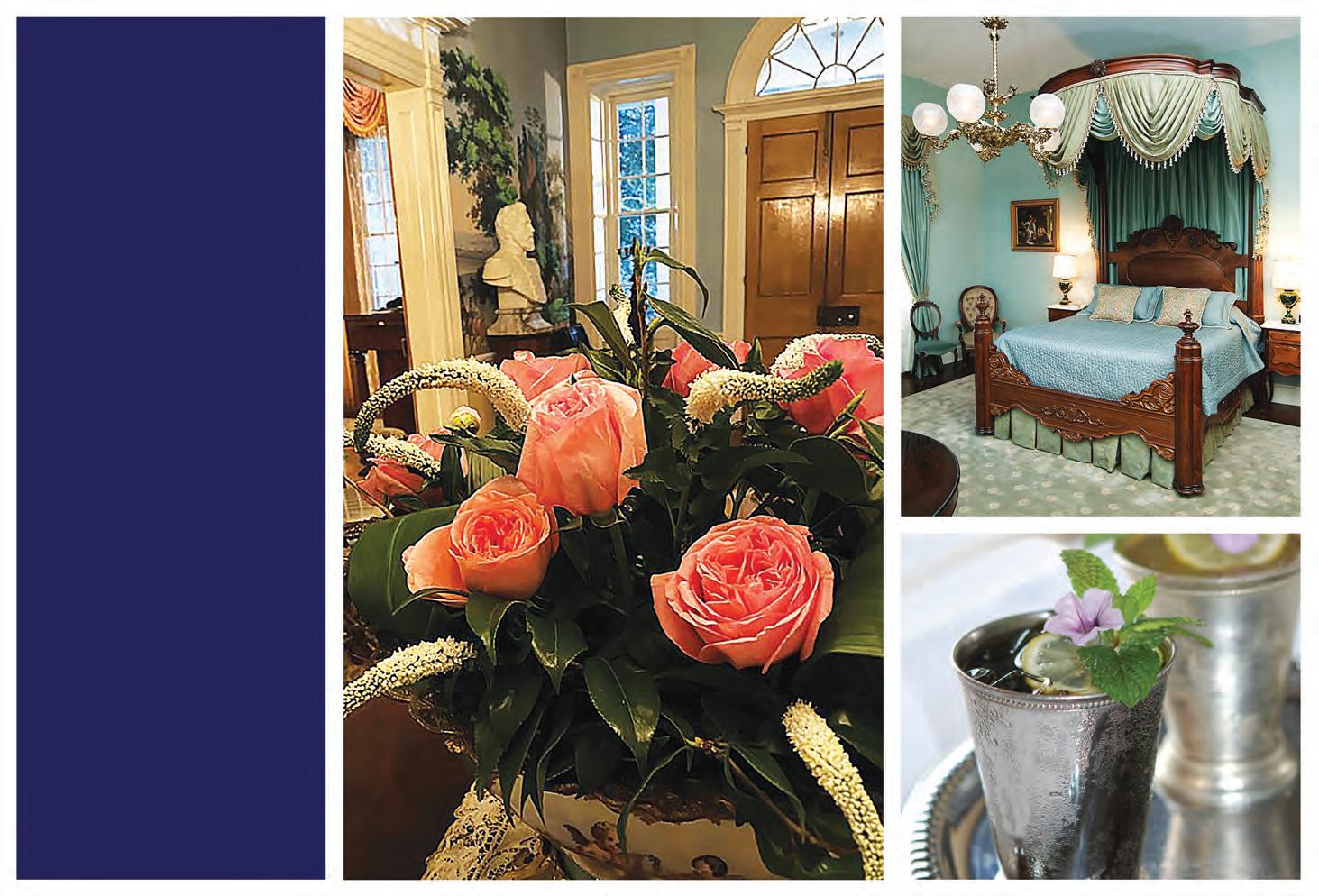
Louisiana
With six percent sugar and ninety percent water, there's no better fruit to pay homage to in June than the juicy, thirst-quenching, life-giving watermelon. DeRidder has figured out that if anything can draw out the crowds this month, it'll be the promise of salted watermelon, watermeloninfused cocktails, watermelon seed spitting, etc.—at least everyone stays hydrated. Held at the Beauregard Parish Fairgrounds, there will be the predictable festival fare: music, kids stuff, food, contests, amusement rides, and much more. All the juicy details can be found at beauregardwatermelonfestival.com. •
JUNE 23 // COUNTRYROADSMAG.COM 18






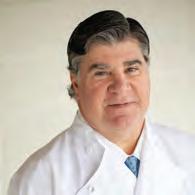

//JUNE 23 19
A Jubilee on Display
THE LOUISIANA ART & ARTISTS' GUILD CELEBRATES 70 YEARS OF BRINGING ARTISTS TOGETHER WITH A NEW EXHIBITION AT THE LOUISIANA ARCHIVES
By Alexandra Kennon
Back in 1953, as Baton Rouge was still developing into the city we recognize today (with far fewer strip malls and many more trees), local artists Barbara Beaucoudray, Dale Hammond, Kathleen Willie, and Mrs. Curtis Barton requested a meeting with Jay Broussard, the original head of the Louisiana Art Commission (the only art commission in the country, back then). At a time when funding and support for the arts was even harder to come by than it is today, they sought Broussard’s help in drafting a charter for something unheard of in Louisiana at that time: an Artists’ Guild.
They presented their charter at the Old State Capitol, which soon enough became the newly-formed Art Guild of Louisiana’s meeting place. Under Beaucoudray’s leadership as the Guild’s original president, the group presented their first exhibition on the fence of the Old State Capitol, thus solidifying their place as a resource for artists and art enthusiasts in Baton Rouge. “Art is a necessary phase of life, fundamental to the cultural growth of our state,” Beaucoudray once said of the Guild’s role in Louisiana.
The group continued to expand both in membership and scope as the years went on. In 1978, it obtained non-profit status, which allowed the Guild to sponsor more exhibitions, workshops, art festivals, scholarships for high schoolers pursuing visual arts, and two LPB art programs. In 2003, a partnership with BREC provided them with a new home in BREC’s Cedarcrest Park Building, better known as The Studio in the Park—where the Guild today hosts workshops, meetings, and open artist studio sessions.

Today, the Art Guild of Louisiana is a vibrant and active community of around 150 local artists. They range from decorated professionals whose work has been shown in galleries across the nation, to beginners picking up paintbrushes for the first time, seeking guidance on where to even begin. Besides connecting art-minded residents, the Guild provides infrastructure and support that can be hard to come by in the arts.
Judi Betts, who at 86 years old is a renowned watercolor painter, retired public school art teacher, and lifetime member of the Guild since she first moved to Baton Rouge in 1956 as well as a former president, says that the group is how she was able to first become part of a community of fellow artists in Baton Rouge; introducing her to many of her lifelong friends. “It was a happy situation for me, and I got to know some of the local people,” Betts said. “Generous, that’s the word I’d use to describe the Art Guild. They’re kind to people that haven’t painted before, and they’re very receptive to people who have painted.”
The Guild marks its jubilee anniversary this year, looking back on seventy years of connecting artists and providing them with opportunities in the Bayou State.
To celebrate, an exhibition of artworks by 31 former Guild members including living artists like Greg Kiger, Stan Routh, and Judi Betts; as well as some who have passed on, like Mary Jane Cox, will be on display through the month of June in the Louisiana Archives. •
To celebrate the group's Jubilee anniversary, an exhibition of influential former Guild members' artwork will be held at the Louisiana State Archives from June 2–29. A closing reception will take place on June 29 from 5 pm–7 pm. Admission is free. artguildlouisiana.org.
JUNE 23 // COUNTRYROADSMAG.COM 20
ARTFUL ORIGINS


//JUNE 23 21
Events

Beginning June 24th - June 29th
JUN 24th
RAINBOW BRIGHT BR PRIDE FEST
Baton Rouge, Louisiana
Established to inspire a sense of community among Baton Rouge's LGBTQ+ community, Baton Rouge Pride Fest centers around a Community Resource Fair, "The Rainbow Bazaar," showcasing the Baton Rouge area's nonprofits and social-services organizations. There will also be the annual Artsfest called the "Queerative Market" in partnership with LEUR magazine—featuring local queer artists. Plus, plenty of entertainment will be provided by local performers and drag queens. It all takes place at the Raising Cane's River Center's Exhibition Halls, River View Room, and Galleria. Noon–7 pm. Free. brpride.org. •
JUN 24th - JUN 25th
NERD OUT SHOWCASE COMIC CON
Slidell, Louisiana
Slidell's resident comic book and gaming shop is bringing back its annual convention of Americana, featuring appearances by creatives the likes of Anime voice actor Lisa Ortiz and artists Angel Medina, Mike DeCarlo, Robby Musso, Tim Lattie, and more. 10 am–5 pm at Slidell's Harbor Center. $15. showcasecomiccon.com. •
JUN 29th - JUL 1st
COMPETITIVE CASTING
GOLDEN MEADOW FOURCHON TARPON RODEO
Port Fourchon, Louisiana
They don't make a great meal and they're not particularly nice to look at, but they sure are fun to fight with. . . but enough about my exes! (I'll be here all week.) Come to the wonderfully named Golden Meadow for the Tarpon Rodeo. There's the prospect of tarpon to catch for the anglers, and plenty of food, music, and seaside fun for those who prefer their seafood pre-scaled. $35 registers an adult for the rodeo and also gives access to the air-conditioned entertainment tent all rodeo long and a boiled shrimp dinner (not to mention the chance to win over $15,000 in rodeo awards and door prizes). Details and schedule at fourchontarpon.com. •
JUN 29th - JUL 2nd
COMPOSING WITH COMMUNITY
SONGBIRD MUSIC SCHOOL
Saint Francisville, Louisiana
Calling all musicians, beginners all the way through seasoned professionals:
BirdMan Coffee is undergoing its seasonal transformation from coffeehouse to music studio for musicians looking to hone their skills, or pick up new ones. The annual Songbird Music School returns as part of Arts for All, offering sessions including a songwriting class with Eric Schmitt and Heather Feierabend, guitar playing for songwriters with Clay Parker, ukelele with Kat Carlson, cabin orchestra for beginners with David Hinson, or the jam camp with Adrian Percy and Michael Holmes. All sessions 8 am–4 pm, includes breakfast and lunch. Find more details and register at bontempstix.com or email Lynn for at birdmancoffeeshop@gmail.com. •
JUN 29th - JUL 3rd
BLACK MAGIC ESSENCE FESTIVAL
New Orleans, Louisiana
Some big acts are headlining Essence Music Festival in New Orleans, the annual showcase of African-American musical talent hosted by Essence Magazine, which brings some star-striking names— including Missy Elliott, Ms. Lauryn Hill, Megan Thee Stallion, just to name a few. In addition to offering superb celebrity and music, the festival—which takes place at the Caesar's Superdome—provides inspirational and business-related seminars as well as arts markets to showcase the work of African-American writers, craftsmen and women, and visual artists. Tickets start at $80 per night. essence.com. •
For our full list of June events, including those we couldn’t fit in print, point your phone camera here.
JUNE 23 // COUNTRYROADSMAG.COM 22
Caring for “The Wood Eternal”
With 30 years’ experience building heirloom-quality furniture, All Wood Furniture’s Doug Duhon shares tips on caring for all solid wood furniture pieces.





Ask any furniture builder or woodworker: the wood of Louisiana’s Bald Cypress tree is special. Featuring a rare combination of durability, stability, strength, workability, and a natural resistance to moisture and pests, cypress is a sought-after material for construction and fine woodworking projects alike. Properly dried cypress resists warping, shrinking, or swelling, while naturally-occurring oils deliver legendary resistance against insects and termites, particularly in old-growth wood. Cypress is also beloved for its handsome grain pattern, with straight, fine lines and multiple knots that enhance the wood’s aesthetic appeal. It is eminently workable, enabling a skilled craftsperson to shape, cut, and join the wood to create durable, beautiful wooden furnishings capable of lasting for generations.
Few people know cypress wood better than David and Doug Duhon of All Wood Furniture. Each year at their workshop in tiny Carencro, Louisiana, the brothers and their team of experienced craftspeople use a couple of hundred thousand board feet of sustainably sourced cypress wood to build handsome, solid wood furniture that has kept their family-run company thriving for thirty years. Look closely at a piece of All Wood furniture and it’s plain to see how the company has endured. In dining tables, sideboards, and case goods, well-proportioned designs evoke the simple beauty of traditional American craftsmanship. Clean, uncluttered lines and solid joinery accentuate the unique qualities of the wood, allowing subtle grain variations, colorings, and saw marks to accentuate the character of each piece. Then there’s the finish—an All Wood hallmark—which is applied in multiple layers then painstakingly hand-sanded
between each layer before a pre-catalyzed lacquer is applied. The result: a durable, luxurious finish that remains resistant to staining and water-intrusion while still allowing the complex character of the wood itself to shine through.
While the stability and durability of cypress imparts unusual longevity to the furniture made with it, any wood product will benefit from the right care. So as All Wood Furniture marks thirty years in the business, co-owner Doug Duhon offers the following tips for caring for high-quality, solid-wood furniture made with cypress, or indeed any other kind of wood.
Not Too Wet, Not Too Dry. Solid wood is constantly moving, breathing, and is happiest when the humidity level is around 40%-50%. If wood gets too dry, cracks or checks can appear. Conversely, warping can occur if a piece of furniture gets wet, then is dried suddenly by heaters or sun. Central air-conditioning helps regulate high humidity in summer months, but in winter, heaters and fireplaces can pull too much moisture out of the air. Duhon recommends using a humidifier to maintain humidity in cold weather, and to avoid placing furniture too close to fireplaces, heaters or A/C vents.
A Place in the Sun. Prolonged exposure to direct sunlight will fade and dull the finish on a piece of furniture and dry the wood out. Avoiding leaving solid wood furniture in direct sunlight for long periods.
Keep it Clean. Dust furniture every few days to keep dirt from building up. Weekly cleaning should be done with a
damp rag; microfiber gives great results. If your table has leaves or company boards, clean them at the same time as the table to keep all components looking the same. Avoid all-purpose cleaners as they can damage the finish. Mild dish detergent works just fine.
To Polish? Or Not? Most solid-wood furniture shouldn’t be polished more than a few times a year, since all polishes leave a buildup if applied too frequently. Common polishes like Pledge contain silicone, which accumulates over time and can break down the finish lacquer. This can also cause a reaction to the refinishing process if your furniture ever needs refinishing or light touch up. Duhon recommends using a silicone-free polish like OZ or Plush sparingly. Apply polish to a soft cloth and rub gently, following the grain of the wood.
Scratch That. Scratches happen! Duhon recommends treating them with a matching-colored wood crayon, or a table finish like Old English Scratch Cover, both of which can be found online. Choose a color close to that of your furniture. Rub gently into the scratch then wipe off the excess.
A Thump in the Night. Avoid dropping heavy or sharp objects on a solid wood piece of furniture. All wood is malleable and will dent or split if hit hard enough. Softwoods like cypress, pine, and cedar are more likely to dent than a hardwood like oak.

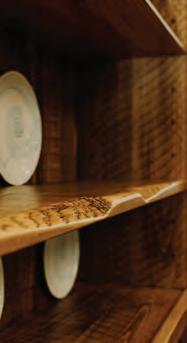
Avoid Direct Heat. Direct heat applied to solid wood tends to draw moisture to the surface between the wood and the finish, creating a white moisture ring or circle. Use a trivet or heat pad to keep
direct heat from serving surfaces.
Ring of Fire. If a moisture ring does develop there are ways to remove it. But take care, since drying the wood quickly can permanently damage the finish. Spreading a towel over the affected area then briefly applying an iron set to the lowest heat setting can dissipate accumulated moisture. You can also use a hair dryer, but take your time and apply heat in small increments. Others recommend applying a small amount of mayonnaise to the affected area, letting it sit for awhile before wiping it off. Duhon explains that mayo’s thick texture binds it to the surface, allowing oil to seep in to help the wood “heal.”
More About Moisture. All Wood furniture pieces are finished with a precatalyzed lacquer, which produces an unusually durable finish that protects against the development of moisture rings. Duhon notes that All Wood has heard from customers whose furniture pieces survived the 2016 floods as a result. However, some wood finishes are more susceptible to developing moisture rings than others, so Duhon says that getting into the habit of using a coaster is never a bad idea.
With a little simple care, your solid wood furniture can and should last for many decades and even be passed along to future generations. This year, All Wood Furniture is marking its 30th anniversary with a sale, offering 25%–60% off selected in-stock furniture. To learn more about the ways All Wood Furniture creates furnishings to last a lifetime, visit allwoodcompany.com
//JUNE 23 23
A special advertising feature from All Wood Furniture All Wood Furniture locations 10269 Airline Highway, Baton Rouge • (225) 293-5118 2842 N.E. Evangeline Thruway, Lafayette • (337) 269-8800 1508 W. Pinhook Road, Lafayette • (337) 262-0059 AllWoodCompany.com
Doug Duhon and Rebecca Duhon (founder David Duhon was unavailable for photo, probably fixing a machine, going through wood, or designing future products). Rebecca hand-draws a stylized crawfish (right) on all handcrafted All Wood cypress tables.
WILDLIFE CONSERVATION
Be Fruitful & Multiply
FOR THE WHOOPING CRANE, CONSERVATION EFFORTS CULMINATE IN EPIC LOVE STORIES
 By Christopher Staudinger
By Christopher Staudinger
Eva Szyszkoski has spent much of her adult life trying to keep one of the rarest birds in the hworld from the brink of extinction. A wildlife technician with the Louisiana Department of Wildlife and Fisheries, her work takes her both below the water table, wading through marshes with juvenile birds, and up in the sky, where she flies in a fixed-wing Cessna over the Chenier Plain, counting whooping crane nests. For over sixty years, these nests—which rise like little islands out of the shallow water—could not be found anywhere in Louisiana. By 1950, all but sixteen of these birds had vanished from their natural habitats across North America, and the world wondered whether the tiny remaining flock would survive. But beginning in 2011, small groups of these five-foot-tall birds have been released each year in Southwest Louisiana, and this brand-new flock might finally be catching on in their bayou habitat.
When I spoke to Szyszkoski in midApril, the Louisiana flock was about halfway through this year’s nesting season. She had just collected a pair of eggs from a failed nest near Gueydan and delivered them to LDWF headquarters in Baton Rouge for examination. By mid-May, she and her colleagues had counted 28
nesting attempts, nine of which still contained viable eggs. Five chicks were still alive, teetering along somewhere behind their parents. The oldest of these is sixty-seven days old, nearing the crucial age when they can spread their wings and fly. Though the season started slow, she said, “We’re happy with any chicks that hatch.” It’s a reminder that only seven years ago, the hatch of a single female whooping crane chick in Louisiana was celebrated the world over as a conservation victory. She was the first wild whooping crane to hatch in the state since 1939, and her survival to independence signaled that this experiment might just actually work.
Generations of scientists and wildlife workers have struggled to understand the finicky reproductive preferences of these cranes. One pioneering ornithologist, Dr. George Archimbault, started living in a pen with a female crane named Tex, “courting” her and dancing with her to convince her to lay eggs. This was in 1976, when only 109 whooping cranes survived in the wild. Every bird and its genetic material was absolutely essential. It took Tex seven years to hatch a successful chick, but she did, and her offspring—named Gee Whiz—sired more than 150 other birds.
As the scientific community got better at producing captive-reared birds, they started releasing them into the wild, but the reproductive difficulties persisted.
Experimental flocks in Idaho and Florida were both discontinued after a combined twenty years because the birds failed to produce enough young in the wild. In a third experimental flock based in Wisconsin, only about sixteen wild-hatched chicks have survived as of 2021, despite the release of about 300 birds in the last two decades.
Louisiana’s flock, started in 2011, is the fourth of these experimental release programs, and it benefits from the experiences of those that came before it. Both Szyszkoski and LDWF biologist Sara Zimorski came to Louisiana after working with the Wisconsin flock. And last year was the best breeding season the initiative has seen yet—marking a milestone for the entire international effort to stabilize the wild whooping crane population.
“We had fifteen chicks hatch, and eight of them made it to independence [separation from parents, usually at about ten months],” said Szyszkoski, noting that this was the most succesful year for fledglings in a half-century of reintroduction efforts. “So, we’re chasing that goal.”
Louisiana possesses 40% of the coastal
wetlands in the country, and the birds evidently enjoy this ecosystem for roaming and its plentiful food sources. “Last year was really a step in the right direction,” said Szyszkoski, “And I think it told us some more about the habitat that the birds are in, that they are able to successfully rear chicks to fledging.”
But she isn’t quite ready to celebrate. “Obviously, we’re not there yet,” she said, because along with the successes come the unexpected frustrations. There is a worrying pattern of recent embryo deaths, which is preventing many more eggs from hatching. The team is currently working with the United States Geological Survey Alaska Science Center to analyze these failed eggs.
There is also the poaching. Of the 175 birds released or fledged in Louisiana since 2011, only around 76 remain in the flock today. The birds have been killed by illness, bobcats, powerlines, and barbed wire fences—all of which are somewhat expected. But in Louisiana, 26% of the dead birds were shot by poachers, double the poaching rate of the Wisconsin flock. After a boost in education programs and the establishment of stiff penalties for individuals charged with the killings (the highest of which was a sentence of forty-five days in jail and a $2,500 fine),

JUN 23 // COUNTRYROADSMAG.COM 24
One of the conservation effort’s most famous cranes, L14-17, photographed on her nest (via game camera) with her first partner, L24-16, in Jefferson County, Texas on May 15, 2021. Courtesy of LDWF.
poaching numbers seem to be decreasing, to the relief of Szyszkoski and her colleagues.
Another explanation for this decline is that more people are learning about the birds. It helps that some of them have become quite famous. As LDWF follows the activities of the flock in superfine detail, they’ve attracted the attention of over 20,000 people across the world, who follow their efforts on the Louisiana Department of Wildlife and Fisheries-Whooping Cranes Facebook page. As Szyszkoski and her colleagues track the birds via transmitters attached to their legs, they keep detailed records of pairings, whereabouts, journeys, disappearances, and about a million other measurements—much of which then gets shared with the public. Because whooping cranes develop intense, territorial bonds for each other, and they often mate for life—the narrative of reintroduction
can often look like a whole lot of complicated love stories.
“I’ve always said it’s sort of like a soap opera,” said Szyszkoski. “If one bird loses their mate, then it can cause a chain reaction of pairs splitting up, and, you know, aggression between birds. It can be pretty crazy.”
Case in point is a now-famous Louisiana crane who veered off and established a bit of a territory near Beaumont. Her scientific name is “L14-17”, and her story has captured the attention of over 26 million viewers on Facebook. Hatched in 2017, L14-17 quickly paired with another young crane, and the duo soon split off from the rest of the Louisiana birds to take seasonal trips to East Texas together. In 2021, they finally started building nests there, and hatched at least one chick.
Sadly, L14-17’s partner died last summer. After the loss, instead of making the
trip back to the wetlands of the Louisiana coast where she could find a new mate, she wandered around her breeding territory in East Texas alone. This left her with almost no chance of pairing again.
So, in early March of this year, Szyszkoski and colleagues from the Louisiana Department of Wildlife and Fisheries’ whooping crane program decided to insert themselves into the drama. To do this, Szyszkoski left her human form behind, putting on a white cotton crane costume and briefly joining the flock. In her hands, she also carried a puppet, featuring a hyper-realistic crane head, sculpted and painted by an artist in Japan.

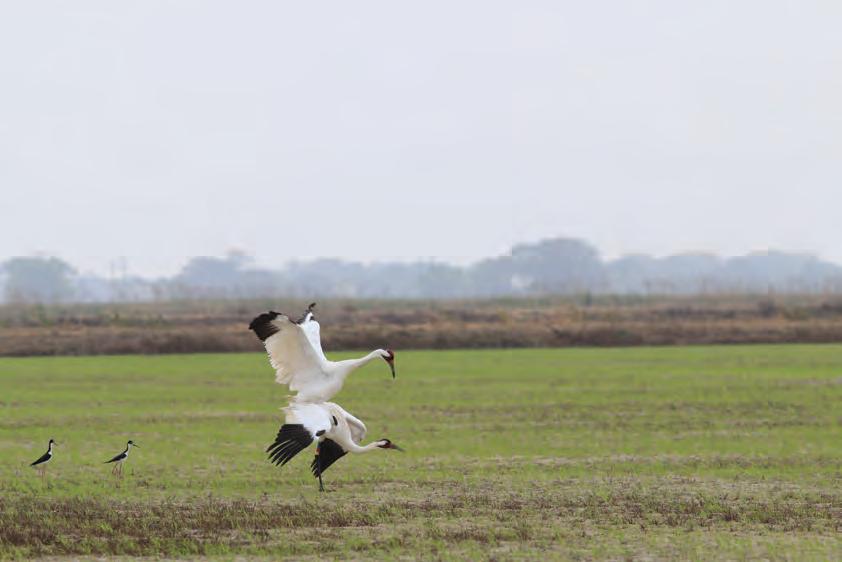
Capturing the five-foot-tall birds can get physical. “I have gotten many
when we do captures,” Szyszkoski said, evidenced by the state of her costume. “Sara’s mom actually made it maybe like twelve years ago. And I really love it, because it’s very lightweight fabric, like really thin cotton. So anytime it gets ripped, like if a crane nail gets caught and tears a big hole, I just patch it. So, it doesn’t look the greatest. But it’s been through a lot.”
Because the cranes were raised in captivity by people wearing these costumes, L14-17 was not driven off by the approach of Szyszkoski in her patched-up robe. “They’re familiar with the costume. They sort of see us as a crane in a way,” she said.
When she approached the bird that day in the East Texas agricultural field, “She was pretty fired up (it being breeding

// JUN 23 25
After losing her partner in Texas, L14-17 was relocated by LDWF to Vermilion Parish in Southwest Louisiana, where she ultimately mated with L3-21, and was seen with a nest in mid April 2023. Courtesy of LDWF.
LW5-21, or as Becky Guillet calls him, Junior (in the front) pictured with his parent L19-16 (in the back) in Acadia Parish in September 2021. Courtesy of LDWF.
season) and actually did briefly solicit me and dance. I think she finally realized I was ‘no good’ and she did threat displays, basically letting me walk up to her and grab her.” The capture was complete when the team placed the bird safely into a cardboard box
They drove her back to the White Lake Conservation area, in the wetlands southwest of Lafayette, and watched as the confused bird walked slowly towards the marshes, quickly distracted by the prospect of eating something in the shallow water.

Only a week after L14-17’s release back in Louisiana, to the delight of her millions of fans online, this single lady had already been spotted mingling with a potential new partner.





Beth Guillet calls this eligible bachelor Junior. “He’s two years old this year,” said the Acadiana birdwatcher, and “from the time he was little, he just had this kind of strut about him.”
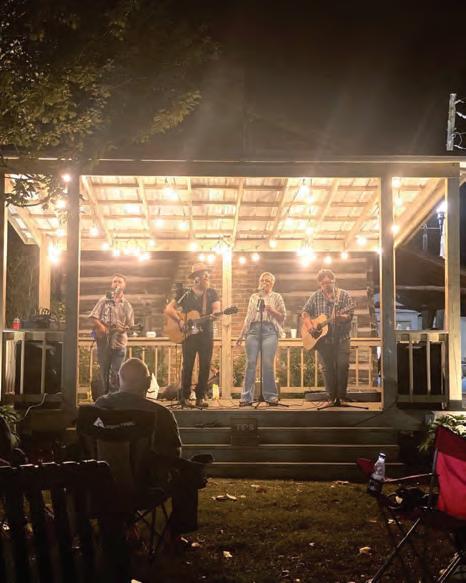

Guillet spends time following whooping cranes, often through quiet crawfish and rice fields west of Lafayette, and keeps an illustrated logbook of her sightings. She has watched Junior’s parents for a few years now as they flirt, nest, and dance. “They seem happy,” she said. “They evoke an emotion. You know, when they dance, they dance with abandon.”
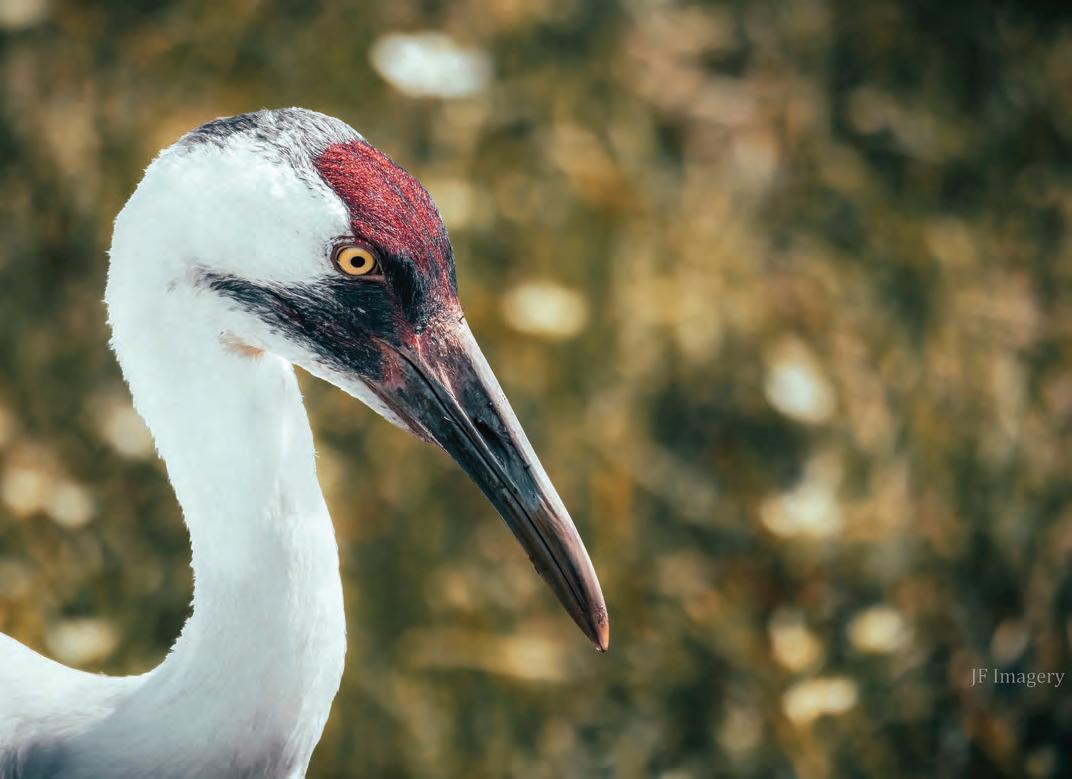
Junior is an important bird for Guillet, because unlike most of his siblings, he has survived. Year after year, she’s watched the slow nesting process of Junior’s parents through her binoculars. And year after year, she’s also watched as these eggs fail and the chicks disappear. Junior’s parents have produced eight chicks and nearly twenty eggs over the years, but he is their only surviving offspring. If the key to the cranes’ success in Louisiana is that they go forth and multiply, few people understand how fragile the young flock is as well as Guillet.
Though Junior managed to survive to independence, the facts of his survival have still been tenuous. When his parents were ready to nest again the following year, they drove him away. Around this time, his transmitter went out. Guillet explained, “For a while they couldn’t find him,” said Guillet. She feared he had been lost, like so many others in her logbook.
But then something unexpected happened. “He came back to his parents,” she said. “And they took him back.” Usually after a young crane is driven from the parents’ territory, he is forced to make a new family elsewhere. But instead they took him back, and Guillet watched from October until January as they bathed and played in the crawfish ponds.
When spring came again, Guillet saw Junior’s parents grabbing at the vegetation with their beaks, over and over, spreading it around, forming the grasses into the ringshaped mounds that would become their cushy island nests. They chased him off again, and the timing coincided perfectly with the LDWF’s release of L14-17 from Texas, setting up a chance encounter at White Lake. “When they brought the crane from Texas, for a while it looked like they were going to pair up. I was so excited! . . . But then she dumped him and went with somebody else!” Guillet said, laughing.
L14-17 ultimately selected another bird, L3-21, as her mate, and was spotted nesting in Vermilion Parish in mid-April.
“I really take an interest in my cranes! I follow them,” Guillet said. “It’s a curiosity. I would love to see them every day. I would like—it might not be in my lifetime— but I would like to think that one day there would be enough in Louisiana that they wouldn’t be such a rare sight.”

JUN 23 // COUNTRYROADSMAG.COM 26
(800)
A whooping crane photographed in Vermilion Parish in 2023 by Joe Fontenot. Courtesy of the International Crane Foundation.
256-2931 | CajunCoast.com | #cajuncoast
TAKE IN THE MESMERIZING BEAUTY ALONG THE SHRIMP TRAIL.
M ystically B eautiful
Drive the Shrimply Delicious Trail in St. Mary Parish and enjoy Louisiana’s favorite seafood along the Cajun Coast. The abundance of restaurants along the many waterways offers visitors the opportunity to sample Louisiana’s Wild Caught Shrimp in a variety of ways. This Shrimply Delicious Trail is your passport to extraordinary culinary delights! CajunCoast.com/ShrimpTrail
Amelia | Morgan City | Berwick | Bayou Vista | Patterson Franklin | Baldwin | Jeanerette Ask for Louisiana Wild Caught Shrimp!
It’s tough to put a finger on where the Louisiana population of whooping cranes stands today, whether it is a flock actively moving towards wild status or simply a precarious, ever-uphill battle against embryo deaths and slow succession. When I posed this question to Richard Dunn, the Assistant Curator at the Audubon Species Survival Center in New Orleans, he didn’t really hesitate. “It could fall apart,” he admitted.
“If we stopped putting chicks out in Louisiana, you know, is there enough to sustain the population? We don’t know that. So yeah. It’s still fragile.” But the risk, he said, doesn’t end with the Louisiana population. It’s a real worry for the main whooping crane population as well, which migrates between South Texas and Alberta, Canada. This is the flock that was hunted and squeezed to less than twenty birds last century, but has now steadily climbed to nearly 600. Dunn explained that the habitat for those birds is actually quite small and at a constant risk from hurricanes, drought, development, and water quality issues. “We can in one fell swoop lose most of the population,” he said, which makes the Louisiana population all the more crucial.




Dunn is part of a rather mind-blowing network of people that extends thousands of miles out from the flock, working full-time to supply the reintroduction efforts with young crane chicks. He runs an impressive operation: seventeen whooping cranes plus a flock of endangered sandhill cranes move around in a series of pens, ponds, and electronics-filled hatching rooms, all tucked in a sprawling wooded reserve that feels a world apart, even though it’s right on the Westbank of Orleans Parish.
I visited the breeding center in 2016, and as we walked between the pens of the captive cranes, we had to keep our voices down to avoid disturbing the nesting birds. It was a wet morning and birdsong was everywhere. “They eat a lot of insects,” he said of the cranes. “They love the wild strawberries that grow here. They go nuts for them.”
Dunn has spent his life admiring animals, volunteering at his hometown zoo in Indiana, banding flamingos in the Bahamas, training and flying over fifty species of birds for a show at SeaWorld, caring for raptors at the Fort Worth Zoo. He recognizes that the whooping crane is but one tall species among many more that are threatened today. According to the most recent State of the World’s Birds report, 160 bird species have been lost in the last 500 years, and those extinctions are accelerating.
Part of the challenge to species reintroduction, and especially raising birds in captivity, is that biologically, there are so many unseen variables at play in an often-stressed environment. “You’re Mother Nature, helping provide enough so that they’re reproducing and doing well,” he said, but “we can’t do better than Mother Nature.”
The challenges will remain so long as these species’ ecosystems remain in peril. “If we ever get our act together and conserve our natural environment, we will have those animals ready to be able to go back out there,” he said of the captive breeding operations.




In the meantime, he is doing his small part and enjoying the victories, like when one of his older cranes, Boudreaux, recently found a mate. The bird has been at Audubon for a decade without a partner, but when a new crane arrived, “It was like love at first sight, you know. They’ve been together and dancing. They haven’t laid yet. So, we’re expecting an egg every day from them. That’s our hope.” •
Learn more about whooping crane reintroduction efforts in Louisiana at wlf.louisiana.gov and audubonnatureinstitute. org/freeport-mcmoran-audubon-species-survival-center; and more about the national efforts at savingcranes.org.
// JUN 23 27
A mother whooping crane pictured with her chick in May 2022 in Acadia Parish. Courtesy of LDWF.




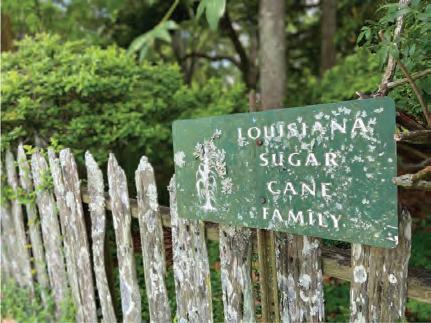



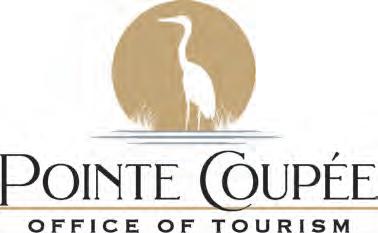



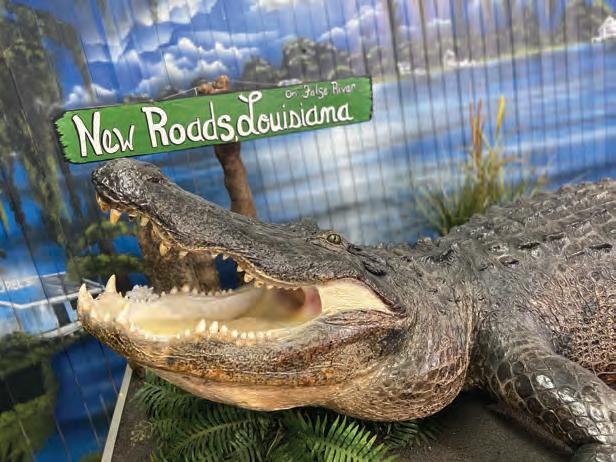
JUN 23 // COUNTRYROADSMAG.COM 28
How Ranching Saved the American Alligator
As a cultural symbol, alligators are as synonymous with Louisiana as gumbo hor Mardi Gras. These cold blooded reptiles thrive in our wetlands, and in nearly every body of water across the region, you can see a pair of eyes watching from the surface’s edge. Covered head-to-toe in body armor, they have existed for 245 million years, even surviving the asteroid responsible for the demise of the dinosaurs. Yet, at one time, humans decimated the population to near extinction.
Today, though, there are around 3.5 million alligators in Louisiana—nearly as many as people—thanks to the Louisiana Department of Wildlife and Fisheries (LDWF) alligator conservation program, which many deem one of the most successful on the planet.
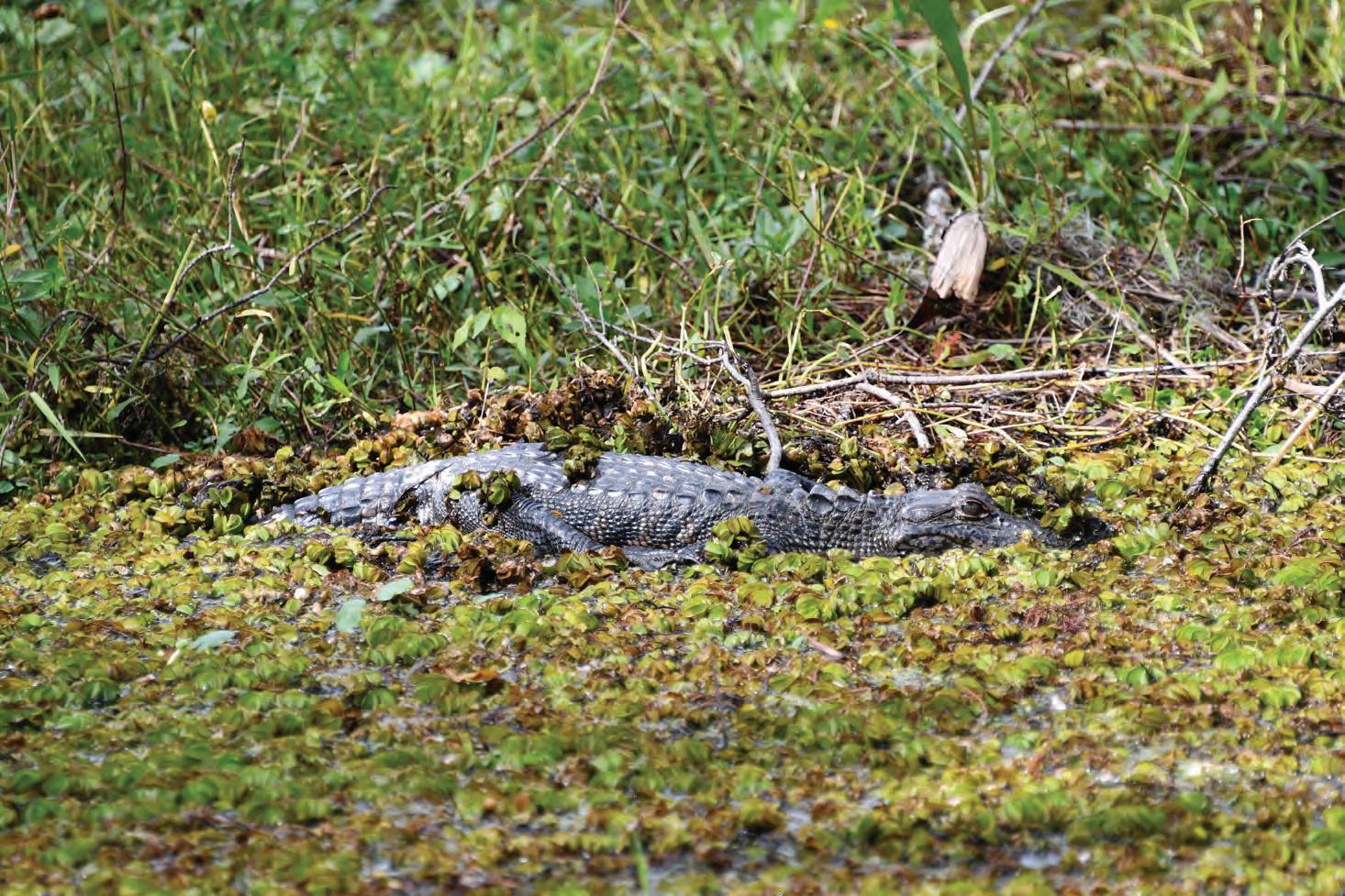
“It’s the quintessential example of a conservation recovery success story,” said Jeb Linscombe, LDWF fur and alligator program manager. “Because hides primarily go out of the country, they are protected under CITES, the Convention on International Trade in Endangered Species of Wild Fauna and Flora. When they meet, they actually use the Louisiana alligator recovery as a conservation success story.”
Louisianans have hunted alligators since the 1800s, both for their hides and their meat. Driven by the overseas mar-
ket, the reptiles were over-harvested in the twentieth century. The main draw was their leather, which was made into high-end luxury items such as shoes, belts, and watch straps. A lucrative business for hunters, it proved devastating to alligators. By the 1950s, only about 100,000 remained in Louisiana.
In 1962, the state made it illegal to hunt them, and even though the population began to rebound, in 1967 alligators were included in the very first list of seventy-five endangered species created under the Endangered Species Preservation Act, the first federal legislation of its kind.
During this time, LDWF began researching the reptiles, studying their habitat and nesting behaviors, and recognizing the importance of the wetlands to their survival. The department developed a plan to work with private landowners, who own eighty percent of coastal wetlands in the state, to harvest alligators sustainably while providing incentives to protect the wetland habitats. Starting in Cameron Parish in 1972, LDWF opened an experimental controlled wild harvest program.
A few years later, in 1979, CITES began requiring every single alligator exported overseas to have a tag. According to Linscombe, this effectively eliminated the black market harvest. In 1981, the alligator was reclassified from
endangered to threatened in Louisiana, and LDWF opened the controlled harvest to the whole state. In 1987, the United States Fish and Wildlife Service officially removed it from the federal list of endangered species. Today, alligator hunters harvest an average of 24,000 alligators each year.
During their research, LDWF discovered part of the population’s challenges could be drawn back to the high mortality rate of baby alligators, which are susceptible to disease and predation. As Royce McMullen, a tour guide at Insta-Gator Ranch in Covington, described, “Everything likes to eat baby alligators. They’re like little hot dogs with legs. Only about six to eight out of a hundred make it in the wild.” In captivity, however, their chances of survival are much higher, around ninety percent.
Armed with this knowledge, in 1986 LDWF supplemented the controlled wild harvest with the state’s first alligator ranching program. Female alligators lay their eggs in late June and early July. After July 4, licensed alligator farmers harvest eggs from the wild, incubate and hatch them, and raise the babies in captivity.
“I would get up at 4 am and take off at 5:30 in an ultralight airplane,” said Insta-Gator Ranch owner John Price, who started taking part in the ranching program in 1989. He still raises alliga-
tors but has recently retired from flying. “I would fly all day, locating nests, throwing out a cane pole from the plane to mark the spot. An airboat would go along behind me and start picking up the eggs.”
For alligators, the temperature determines the sex of the baby. Warmer temperatures of 93.2 degrees Fahrenheit and above produce males, while cooler temperatures below 86 degrees Fahrenheit produce females. Insta-Gator incubates the eggs in between the two extremes to generate a mix, as well as healthier, faster-growing animals. These hatch between August 12 and September 6.
“In the beginning of the program, we had a lot of people with small, experimental operations,” said Linscombe, who explained the program has dropped from 120 to around thirty ranchers. “A small number were more successful, so the numbers dropped. There are a limited number of eggs to collect and a limited market for the hides, but the farming program is the largest it’s ever been right now. We saw a downturn in the market with [the Coronavirus pandemic], and we’re still working through it, but I’d still say it’s as big of an industry now as ever.”
When they hatch, the alligator babies are around nine inches long. Ranchers raise them for a year or two until
// JUN 23 29
WILDLIFE
CONSERVATION
ONE OF THE WORLD’S BIGGEST CONSERVATION SUCCESS STORIES, STRAIGHT OUT OF LOUISIANA Story by Kristy Christiansen • Photos by Paul Christiansen
they reach three to five feet in length, at which point some are re-released into the wild. At this size, their chances of survival are much higher. Farm-raised alligators are tagged, tailnotched, sexed, and measured before they are released into the wild.

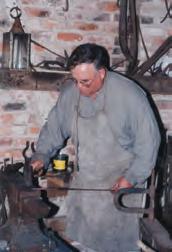
“The research at the time thought seventeen percent was a good number to release back into the wild,” said Linscombe, clarifying that LDWF is not looking for a target population but rather a stable one. “As the population continued to increase, the [release] number decreased.” Now only five percent of alligators hatched in captivity are released back into the wild. The rest are harvested for their hide and meat, just like chickens, pigs, and other farm-raised animals.
“In my opinion, it’s the best program of protection on the planet,” said Price. “There were 100,000 when it first started. Now we have 2.5 million in the wild and another million on farms. Funding [for the program] comes from consumption.”


As the population has rebounded, the alligator has become an effective ambassador of Louisiana's cultural identity. Visitors come from around the world to see the reptiles up close, taking airboat tours in the swamp or visiting places like Insta-Gator, which has shifted its primary focus from ranching to tourism. In the early days of the program, Insta-Gator raised the alligators to grow to a size of three to five feet in length. This not only was the required size to release them in the wild but also an ideal size for harvesting for leather, as the hides of the smaller gators have tighter grain. When they opened the property for tours in 2001, though, visitors started inquiring about seeing larger alligators.
“The breeders are in the wild, so we didn’t need big alligators here,” explained Price, whose business generally ranges between housing 1,000 and 3,500 gators at any given time. “But people came looking for them, so we started raising big alligators. Now we focus on tourism and less on alligator ranching. There are no other ranchers making an effort to educate like we are here.”
Today, visitors to Insta-Gator not only view the alligators up close but hold and feed them as well—all while learning about Louisiana’s conservation program. As part of their educational initiatives, visitors can even assist a baby alligator as it hatches from its egg.
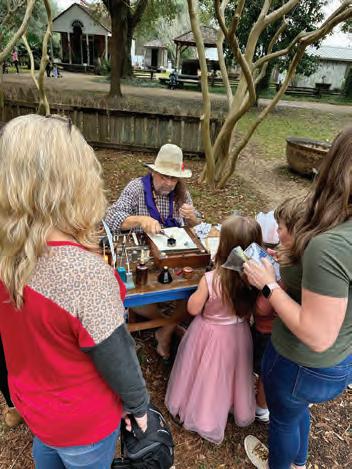
Since launching the alligator management program, LDWF cites an overall harvest of over 1.1 million wild alligators, a collection of over 11 million alligator eggs, and the sale of about 7.3 million farm-raised alligators. It’s a success story talked about across the globe, replicated in countries from Africa to Australia and China, and seen first-hand in the wetlands of Louisiana. •
Learn more about LDWF’s alligator management program at wlf.louisiana.gov. Book an alligator tour or hatching experience at Insta-Gator at insta-gatorranch.com.

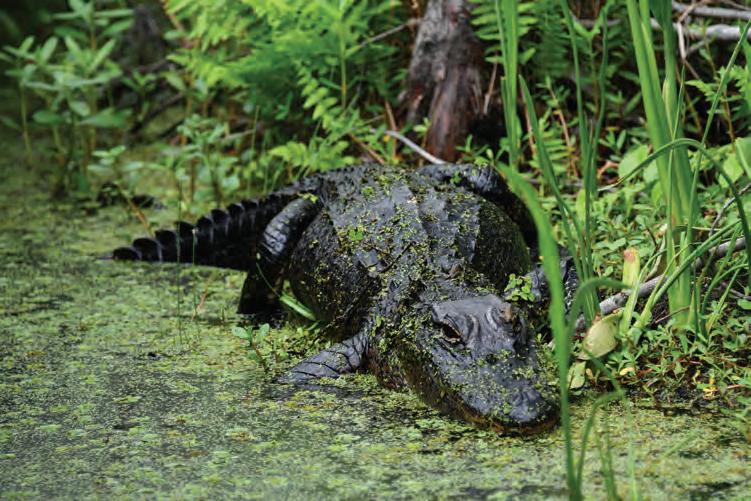
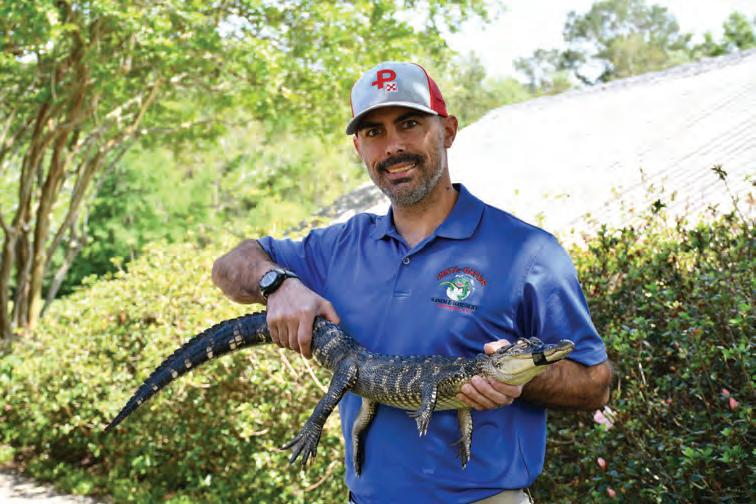
JUN 23 // COUNTRYROADSMAG.COM 30
Royce McMullen, a tour guide at Insta-Gator Ranch, showcasing one of the gators raised there.
Come Celebrate in iberia parish

LIVE MUSIC AT THE ISLE OF IBERIA RV PARK & RESORT!
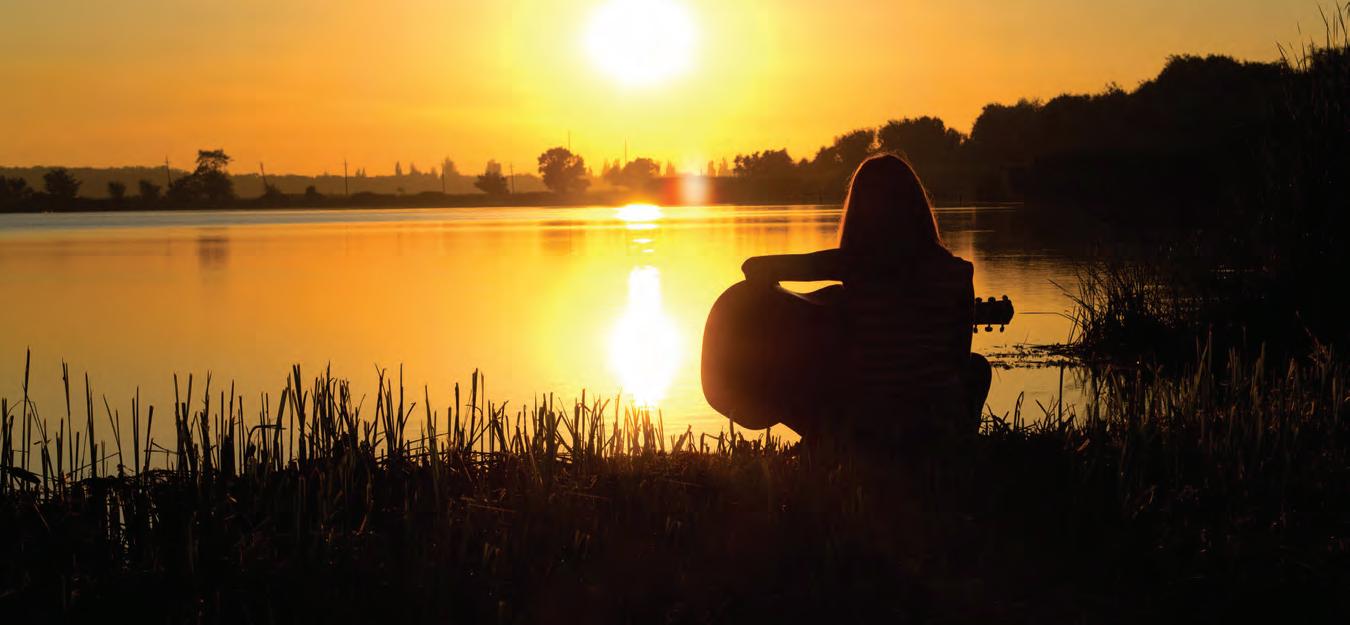
JUNE
June 3 – Cajun Company Band
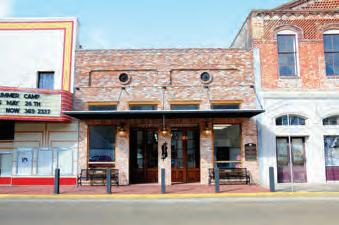

June 10 – Blake Luquette
June 17 – Louisiana Jukebox
June 24 – La Southbound Band
JULY
July 1 – The Cast

July 8 – Ronny Sonnier Yesterday’s Hits
July 15 – Kip Sonnier
July 22 – Matthew Ewing and the All Star Band
July 29 – Straight Whiskey Band
AUGUST
August 5 – The Envies
August 12 – Kip Sonnier
August 19 – The Cast
August 26 – Loose Change Band
SEPTEMBER
Sept 2 – Matthew Ewing and the All Star Band
Sept 3 – Basin Boogey Man
OCTOBER
Oct 28 – Bad Boys Band – 7:00-10:00pm
Plan,
Bands play 6:00-9:00pm, unless otherwise specified.
// JUN 23 31
Visit Tabasco and Jungle Gardens Avery Island, Jefferson Island Rip Van Winkle Gardens, Shadows-on-the-Teche, KONRIKO Rice Mill, Bayou Teche and Jeanerette Museum(s), and stroll the New Iberia Historic District Enjoy dining, history, outdoor beauty, as you Savor the Difference in Iberia Parish.
Iberia Parish Convention & Visitors Bureau 2513 Hwy. 14, New Iberia, LA 70560 888-942-3742 • IberiaTravel.com
pack, prepare for your staycation.
What Happens In the Box . . .
SPENDING A DAY (OR TWO) FOLLOWING IN THE FOOTSTEPS OF A WOOD DUCK BIOLOGIST
In Louisiana’s case, some scientists worry that ducklings hatched in wood duck boxes located in swamp and marsh wetland habitats may simply be feeding the alligators and their eggs feeding snakes.
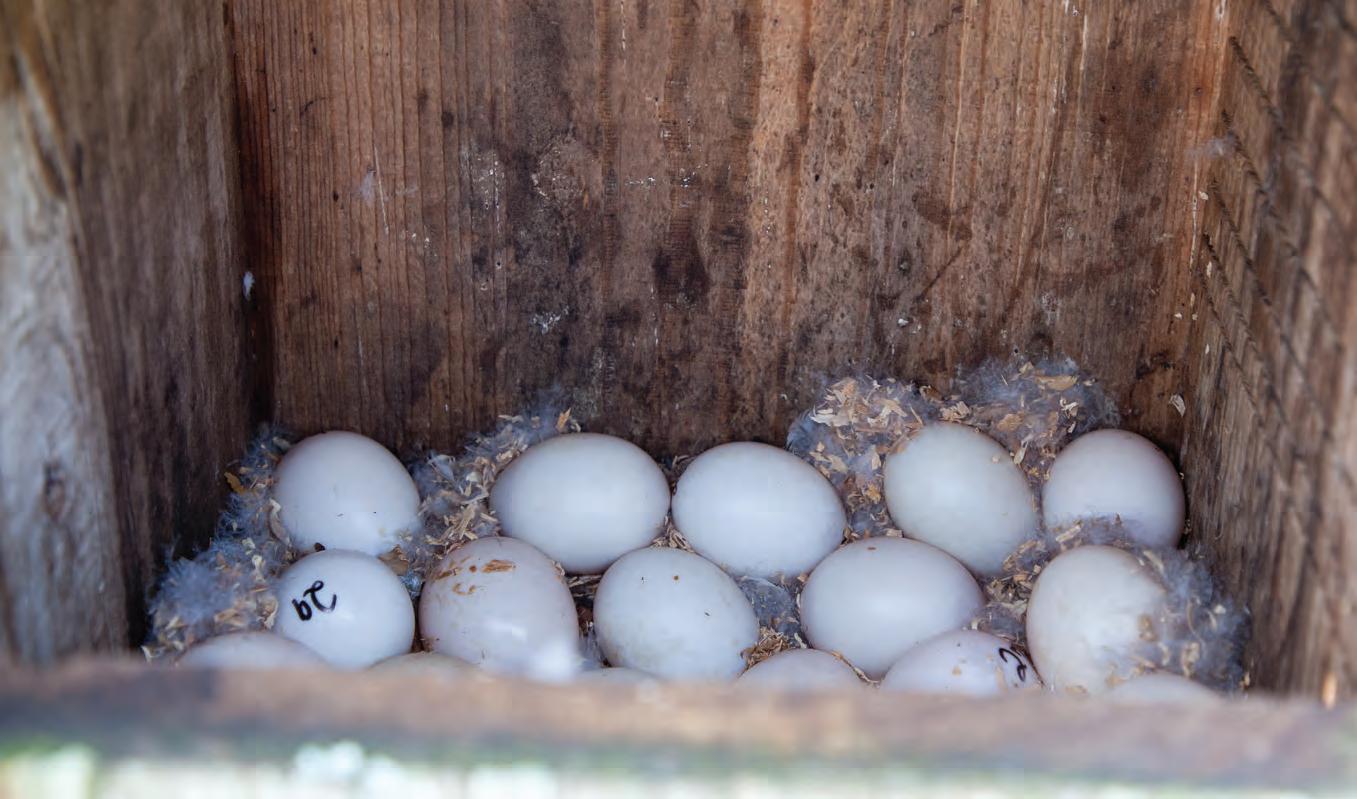
Another objective Reynolds says the department was hoping to learn more about through the study is whether hens nesting in wood duck boxes produce hens that nest in wood duck boxes in future generations.
In 2021, I spent two full days in the field with Dylan Bakner, a PhD student with the LSU AgCenter, learning about the wood duck recruitment study. The first day was during the latter part of April, checking nest boxes. The second took place several months later in early August.
Bakner’s role in the study has been focused on the effects an expanding population of black-bellied whistling ducks have had on the wood duck nest box program, addressing concerns that these birds might be competing with wood ducks for habitat—which could lead to parasitism, where poor wood duck duckling survival could be a concern.
The wood duck is an iconic bird widely known for its beauty, which has long inspired artists, birders, and wildlife photographers.
The stunning birds have also long been favored by hunters across the country, and today make up approximately 10% of the national duck harvest annually. To waterfowl hunters, the gaudy bird is considered excellent table fare and is often a treasured prize to drop off to the taxidermist.
During the late 1800s and early 1900s, this esteem—combined with deforestation and habitat loss, as well as the plumage market of the time—nearly drove the wood duck population to extinction. The 1918 Migratory Bird Treaty Act prohibited the hunting of wood ducks, and populations started to rebound during the 1920s.
The United States Fish & Wildlife Service’s first wood duck nest box programs began in the 1930s in the Chautauqua National Wildlife Refuge in Illinois, fueling the steady national increase in the population, even allowing for hunting seasons to be re-opened in 1941. Today, Ducks Unlimited estimates some 300,000 nest boxes exist in North America, producing 100,000 ducklings annually.
In the late 1980s, though, studies indicated reduced populations in the Southeast region, largely due to habitat loss. As a result, the Louisiana Department of Wildlife and Fisheries launched their own wood duck nesting box program in 1990, placing boxes in wildlife management areas, state parks, and properties managed by the U.S. Army Corps of Engineers—as well as some private wetlands. Former Louisiana Department of Wildlife and Fisheries Waterfowl Program Manager Larry Reynolds said that as of 2022 the department currently maintains an estimated 1,750 nest boxes, with a goal of reaching two thousand.
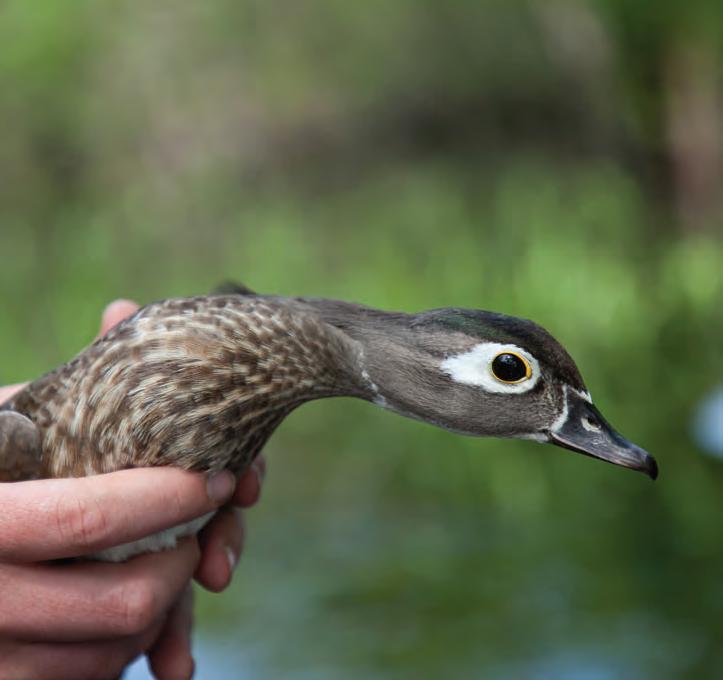
Over the years, these initiatives have allowed scientists to study things like duckling production and survival, box placement and maintenance, use, and brood parasitism (the frequency at which wood ducks lay their eggs in other birds’ nests, so that the other bird ends up raising their young). However, few studies attempted to extensively measure actual recruitment (the number of mother ducks and ducklings that survive subsequent
breeding seasons) of this species until now.
The Nemours Wildlife Foundation study, which involves eight southeastern states including Louisiana, was born out of a 2018 meeting hosted by the Nemours Wildlife Foundation located in Yemassee, South Carolina, then followed by a pilot study in 2019 on the Santee Wildlife Refuge near Summerton, South Carolina. The multi-year research project, which is titled “Regional Examination of the Contribution of Nest Boxes to Wood Duck Recruitment in Southeast and Mid-Atlantic States,” looks to provide new information that will enhance management decision-making. Moreover, it will help states evaluate the effectiveness of existing nest box programs, and determine whether to continue, terminate, alter, or even initiate altogether new programs.
Reynolds said the LDWF jumped at the chance to participate in the Nemours study—for reasons even beyond the Foundation’s primary initiative to study recruitment.
A structured nest box evaluation program had been on the department’s long-term priority list, he explained, but up to this point one had never been conducted. One major question is whether or not the boxes “contribute positively to [wood duck] populations in areas with sufficient nest cavities, or are they just a population sink?” He pointed out that biologists use the term “sink” to describe situations where birds are attracted to habitats where they cannot be successful.
An example he used is a sea of farmland with an over-abundant predator population.
For the past twenty to thirty years, the black-bellied whistling duck has been expanding its range further and further north from Mexico and south Texas, where now they appear to be firmly established as year-round residents in Louisiana. During the winter, large flocks of these whistling ducks hang out in the greater New Orleans area in places like Lafreniere and Audubon Parks, as well as across the Mississippi River in Westwego, where there is a ready-made food source and safe refuge around grain elevators. In the spring they leave their urban settings and disperse across the Louisiana landscape to nest, potentially in direct competition with wood ducks.
One of the wood duck nest box study’s “Anticipated Outcomes” is to gain new information on the nesting ecology of black-bellied whistling ducks, which may open avenues of applied scientific inquiry relevant to the management of cavity-nesting species in Louisiana. Of the estimated 1750 wood duck nest boxes the LDWF
JUN 23 // COUNTRYROADSMAG.COM 32
WILDLIFE
CONSERVATION
Story and photos by John Flores
A wood duck nest box, filled with marked eggs.
A wood duck hen, captured and documented during Bakner’s research study.
manages in its Wildlife Management Areas, Bakner’s research involves around three hundred.

Bakner said of the black-bellied whistling ducks, “We don’t know anything about these guys. [Until very recently] there has not been a single study done in the southeastern United States focusing on black-bellied whistling ducks. All of the studies that have been done regarding breeding whistling ducks took place on the northern end of their breeding range in the ‘60s and ‘70s, which was southern Texas.”
The boxes we checked were all located on Sherburne Wildlife Management Area, which rests inside the boundaries of the vast Atchafalaya Basin, the largest contiguous hardwood swamp in the United States. We spent our time on the complex’s North and South farms, where LDWF manages large freshwater impoundments, which are drawn down in mid-summer to enhance the growth of wetland plants as forage for wintering waterfowl. During the drawdown period, the shallow water and RTV, or while walking up to them.) After the hole was plugged, Bakner set up a ladder to lift the lid to see if the box was occupied. If a bird was present, Bakner would capture it.
mudflats act as a magnet to wading birds such as egrets, ibises, roseate spoonbills, and herons, as well as shorebirds.
Bakner loaded up an RTV we’d be using to traverse the impoundment levees, where the LDWF placed wood duck nest boxes. At the first box, I watched him creep quietly up to it, so as not to alert the bird that might be sitting on eggs inside, then quickly plug the entrance hole using a Nerf football. (The process doesn’t always work. We had several skittish birds flush out of the entrance hole just as we approached the box in the
The nest boxes in Bakner’s study areas are monitored on a weekly basis, and most of the birds captured during our trip had already been banded and tagged. In those cases, their information was simply recorded and the bird was released. Whenever they hadn’t been previously banded and tagged, he swiftly did so.

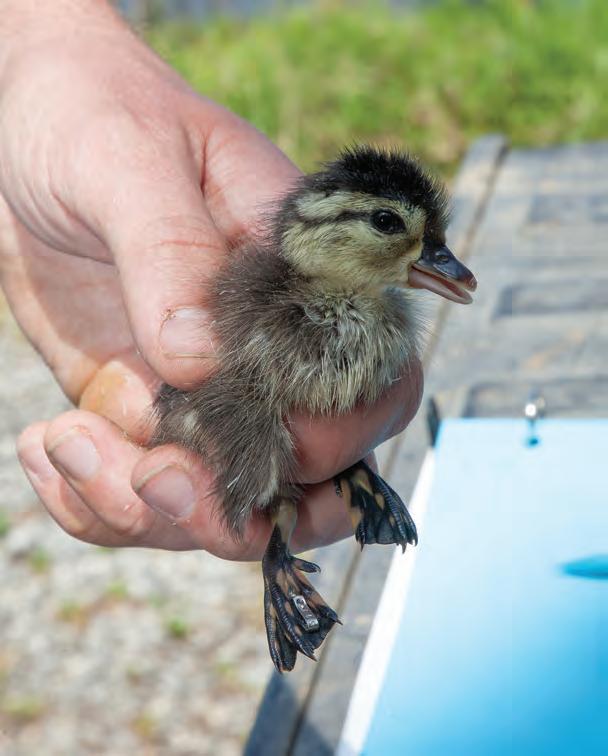
After processing the adult birds’ information, Bak-

ner moved on to each nest’s eggs, for which he took and recorded morphological measurements consisting of length, width, and mass as well the quantity of eggs in each nest. Each egg was then inscribed with a felt marker and given a specific number to identify it on subsequent visits.
While Bakner handled eggs from one of the nest boxes, he explained how the incubation data collected each week was critical in trying to predict when the nests would hatch. “Once it approaches within three days of its expected hatch date, we’ll go visit that nest each day
// JUN 23 33
Left: A black-bellied whistling duck takes an incubation break during the hot month of August.
Right: A web-tagged wood duck duckling.
with hopes of opening a box and having it full of ducklings, which we’ll PIT and web tag,” said Bakner.
PIT (Passive Integrated Transponders) tags are essentially the same type of microchip used in family pets such as dogs and cats. By scanning the chip, pets can be identified and returned to their owner. Likewise, when biologists encounter a PIT-tagged wood duck, a handheld scanner can be passed over the bird, which will display an identifying number.
PIT tags are believed to be more accurate than traditional web tags, because of the fragility of the web on a duck’s foot. For ducklings, it’s worse, and many of their web tags end up lost.
For the study, half of each brood are web tagged, and the other half PIT tagged. By dividing the tagging methods into two groups, biologists hope to compare and learn more about their respective recovery rates. When Bakner discovered black-bellied whistling ducks in a nest, though, all of those ducklings received PIT tags.
“Our number one objective is to study wood duck recruitment,” said Backner. “So, capturing these ducklings and tagging them, and then seeing how many of those females survive until next year to breeding age, accomplishes some of that.”
As of July 2022, Bakner and his team had marked and recorded 743 adult wood duck hens and 3,749 wood duck
ducklings, as well as 258 adult black-bellied whistling ducks, and 1,213 whistling duck ducklings.
At the end of each field day, participating researchers like Bakner enter their data into an app, which is then synchronized and uploaded to the main database that Nemours is managing.

One of the major findings at study sites across all of the participating states was that wood duck eggs frequently go missing, though the nests are still hatching out. Bakner said, “It was like some predator was showing up, picking off one egg and doing that X number of times throughout the nest’s life. The nests were still hatching and doing fine, but we weren’t sure how the eggs were going missing.”
By installing game trail cameras inside some of the nest boxes and adapting a fisheye lens made for iPhones to them, Bakner was able to quickly solve the mystery. He learned eggs become damaged from a variety of reasons, including altercations. One video he captured showed two wood duck hens physically fighting with one another as they both tried to lay their eggs in the same nest box. In another video, he recorded a hen wood duck leaving her nest box for an incubation break. Soon after, a red-bellied woodpecker came in and started pecking and feeding on an egg.
What Bakner discovered is when wood duck hens return to the nest box,
the first thing they do is assess the nest, inspecting nearly every egg. If one is found broken, they’ll take their upper and lower mandible and shove it in the egg, pick it up, and fly out of the box with it.
Through his research, Bakner has been especially focused on determining just how much overlap there is in the wood duck and black-bellied whistling duck breeding season. Essentially, he said, when it comes to nest initiation dates (meaning the first day that a wood duck lays an egg and the first day a black-bellied whistling duck lays an egg), there is a ninety-three-day period of overlap, where both species are nesting.
As a result, there are some mixed clutches. Bakner has documented wood ducks hatching out black-bellied whistling duck eggs, as well as their own, and black-bellied whistling ducks hatching out wood duck eggs, as well as their own.
Based on the data Bakner compiled through 2020, of all of the wood duck eggs observed that hatched, 13% of them came from mixed clutches. And of all the black-bellied whistling duck eggs observed that hatched, 32% of them hatched from mixed clutches.
So the question becomes: is the overlap in nesting periods influencing or helping wood duck productivity? Another question might be, are the two species influencing or helping each other? In the case of black-bellied whistling ducks, it may
not be such a bad idea to try and target a nest with eggs from both species, Bakner said.
“We just don’t know anything about black-bellied whistling ducks. There’s a single paper—one paper that notes two wood duck nests, where somebody observed whistling duck eggs being incubated by the wood duck,” said Bakner.
Another unique observation Bakner has made is that despite the many mixed clutches he has observed, he has never seen a mixed brood outside of the box. “It’s like they jump from the box, and then I see whistling duck ducklings with whistling duck mom and dads. And, I see wood duck ducklings with wood duck mom and dads. I never see a mixed brood, and yet I have evidence of them surviving.”
All in all, Bakner is plowing a lot of new ground as he studies the ecology of black-bellied whistling ducks as part of the regional wood duck nest box recruitment project. Bakner’s field work was completed during the spring of 2022 and will be published in July 2023. •
Learn more about the Nemours Wildlife Foundation at nemourswildlifefoundaton. org and about LDWF’s Wood Duck Nesting Box Program at wlf.louisiana.gov.
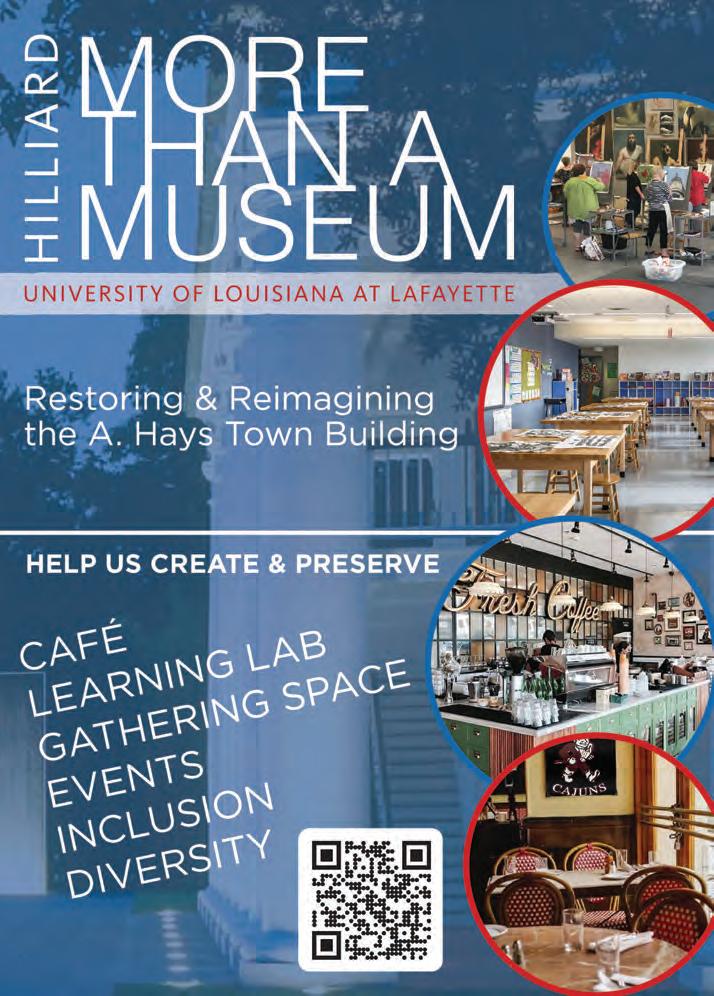
JUN 23 // COUNTRYROADSMAG.COM 34

// JUN 23 35 VisitLakeCharles.org LET YOUR HAIR DOWN. Explore, discover and … exhale. SOAK it
up
FOOD FOR DRINKING
Hungry Eyes
compliment a martini buzz, the food is anything but an afterthought. Drawing from Mediterranean, Asian, and other global influences, the dishes are layered with technique. The eggplant dip, with a blend of olives, mushrooms, and Calabrian pepper is a prime example of flavors working together to make a whole greater than its parts. Flavor forward, yes, but nu-
The joy of Hereford’s restaurants is that they are decidedly unstuffy while committing to service and flavor, and in this spirit the Hungry Eyes menu seems to wink at its diners: artichoke hearts are served “on the half shell” in a tray of ceramic oyster shells, and the hanger steak comes skewered with melted bleu cheese on top. You can get a choice of “carbs on the side,” including crab-boiled potatoes or fries with garlicky toum. The sense of humor works well because the food is so thoughtfully prepared. Dishes seem to be plated to encourage diner interaction: the aromatic seafood curry comes with a trio of rice, cilantro, and crisp, buttery roti that you can mix and match. The skewer of grilled pastrami is served with lettuce leaves and lightly pickled carrot and daikon for a do-it-yourself lettuce wrap. Dessert is where nostalgia comes out to have some fun, and Hungry Eyes’ option is a twist on the classic Viennetta frozen dessert cake, complete with a B52 ref-
With a dinner-only menu, Hungry Eyes allows its chefs to work with those seasonal and hard-to-find ingredients in ways they could not before.
When it comes to starting a new restaurant, New Orleans chef and restaurateur Mason Hereford always comes up with the name first. Turkey and the Wolf and Molly’s Rise and Shine are local and even national favorites, beloved for elevating creative menus in thematically playful spaces.

Hereford's newest concept, the eighties-inspired Hungry Eyes, opened on Magazine Street in early April. He and his wife Lauren Agudo partnered with Turkey and the Wolf Co-Chef Phil Cenac for the project, with a drinks program run by Lahzie Takada (wine) and Carlos Quinonez (cocktails), and help from Kate Mirante, the Director of Op-
erations of the entire company.
With any decade-based concept, the risk of nostalgia translating to gimmick lurks. How much fuel does riffing on a time period still have in its tank? Hereford and his team aimed to use the eighties mostly as a “vibe guide”. They didn’t want the restaurant to be a “theme park that looks like Saved by the Bell or something,” Hereford joked. “We found so much stuff we wanted to buy, but it didn't quite perfectly hit the vibe.” With the help of Paul Octavious, a creative director from Chicago, the result is an atmosphere of curated prints, neon pastels, and whimsical geometrics.
It’s a restaurant for a night out, Vesper martini in hand. The cocktail list
is rounded out with colorful concoctions, often infused with Pacific-tinged flavors like pandan, ube, and sparkling sake. The Robert (named for Hereford’s father), a refreshing sipper with mushroom and sherry and sage, dances along the line between savory and sweet. Frankly, the drinks seem like they are having their own good time
The decidedly un-eighties, and perhaps the best, thing about Hungry Eyes, is the food itself. As lively as the atmosphere, the dishes are “medium-size” plates designed for sharing and snacking. Composed as “food that pairs really well with drinking,” these dishes are “flavor forward, not a lot of subtlety,” Hereford said. And though they are meant to
“After seven years of working in Turkey and Wolf and five years of Molly’s," Hereford said, “[we thought], why don't we take what we've now learned doing casual food and see if we can apply that playfulness to these higher price point ingredients?”
This is where the design and menu come together: the ambient lighting assists in creating a distinction from the daytime fare of Turkey and the Wolf or Molly’s. As Hereford explained, diners “have to be in a different atmosphere to really be in the mood for “fine-dining”-esque ingredients.

The kitchen layout also helped determine what kinds of dishes Cenac and Hereford brought to the menu.
“We want to cook the food that we can best accomplish with our skill set and the tools we have at our disposal,”
JUN 23 // COUNTRYROADSMAG.COM 36 SIP & SAVOR 36 NEW ORLEANS' MOST PLAYFUL RESTAURATEUR OPENS UP MAGAZINE STREET'S NEWEST HOTSPOT • JUNE 2023
Cuisine
MASON HEREFORD DOES FINE DINING, WITH AN EIGHTIES TWIST Story by Sophie Nau • Photos by Alexandra Kennon
(Left to right) Lauren Agudo, Mason Hereford, Kate Mirante, Carlos Quinonez, and Phil Cenac are the masterminds behind the new martini-fueled dinner restaurant Hungry Eyes.
have a certain amount of room for tools, which helps us figure out what we're going to cook. The skill sets of the people that join the team, the flow of service, all those things sort of decide the food. So we try not to put ourselves in a situation where any rules exist.”
When I visited, it was the day after opening night. They had nearly doubled their one hundred cover goal and were already making tweaks to the menu and flow of service.



trons can put their names down and wait for a text while they have a drink near by, like at Second Vine Wine next door. Whether Hungry Eyes stirs personal memories or not, it’s a welcome addition to a bustling block of Uptown’s Magazine Street. Come for the fun of saying where you’re going, and stay for elegant flavors in a lighthearted environment. •
hungryeyesnola.com
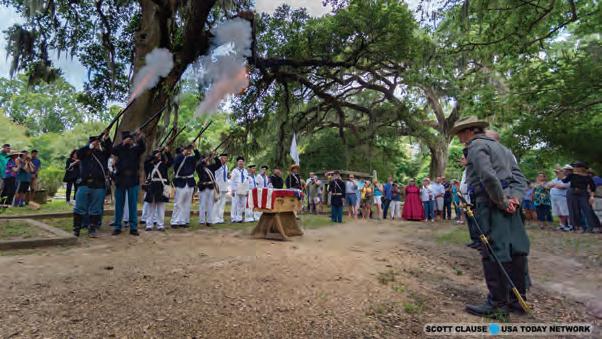




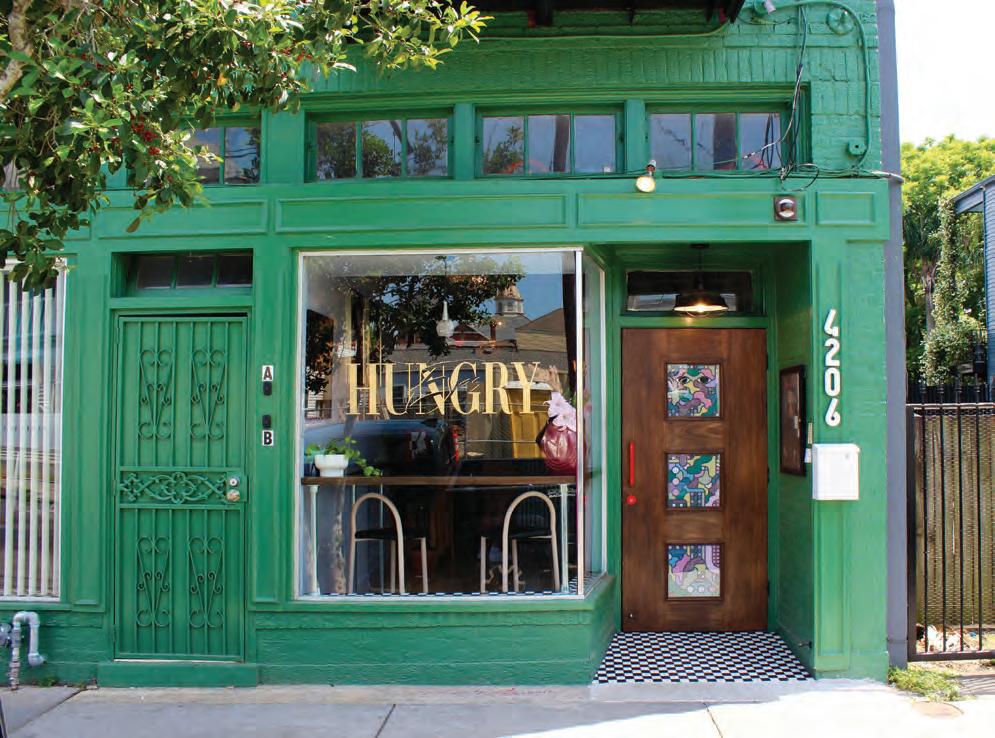
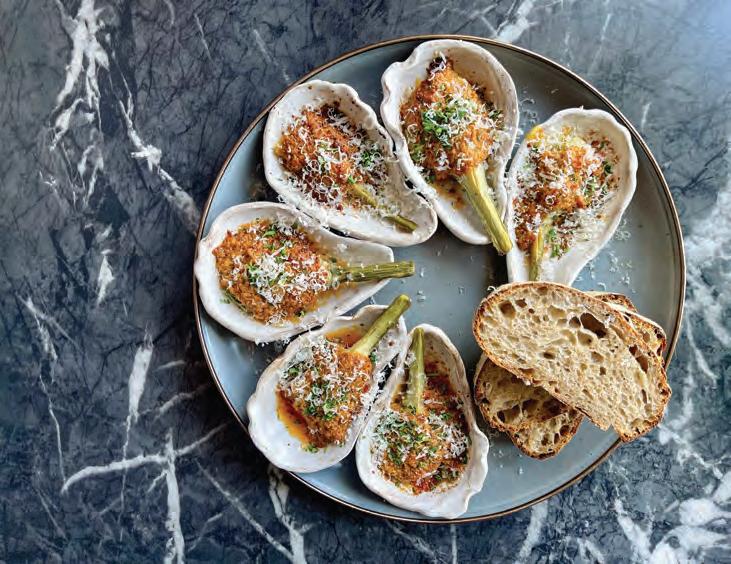
//JUN 23 37
Culture
HEALING TRADITIONS

Traditions Rooted in the Future
Botanical Legacy
At seventy-eight, Louisiana legend Dr. Charles Allen is more active than many twenty-somethings, up before sunrise to trek across his sprawling Allen Acres property and photograph moths on farflung observation stations. (He’s currently photographed 1003 unique species.) Then depending on the day, he may be leading an edible plants class on his twenty-six-acre outdoor classroom, heading off to speak before a master gardener’s club, or holed up in his home office working on his next book. He could be flying out of state to headline at a conference or accepting yet another botanical or ecological award.

Allen’s childhood spent working on the family dairy farm set the tone for such a productive life. “Everybody on my mother’s side had fifteen or twenty cows,” he said. “We woke before daybreak to milk them, so the milk could be taken into the
co-op.” When Allen arrived at Louisiana State University to work toward his bachelor’s in forestry, he easily landed a job at the on-campus dairy.
When he graduated, the country was still embroiled in the Vietnam War, so he enlisted in the army. “I had a lot of time to think while I was in Vietnam,” he said. “I realized what I’d enjoyed most at LSU were my plant ID classes. I decided when I got back, I’d learn all I could about plant identification.”
Allen’s grandmother was part Native American and schooled in herbal remedies. “I learned from watching her and became interested in finding the things that grew near me that were edible or medicinal,” said Allen. He went on to complete a master’s in botany and a PhD in biology. Over the years, he’s shared his passion for all things botanical with thousands of college students as a
professor at several colleges around the state. Since his re tirement from the state univer sity system, Allen hosts about one hundred plant ID, foraging, and edi ble plants classes a year at his home, Allen Acres, where he and his wife, Susan, also run a homey bed and breakfast.
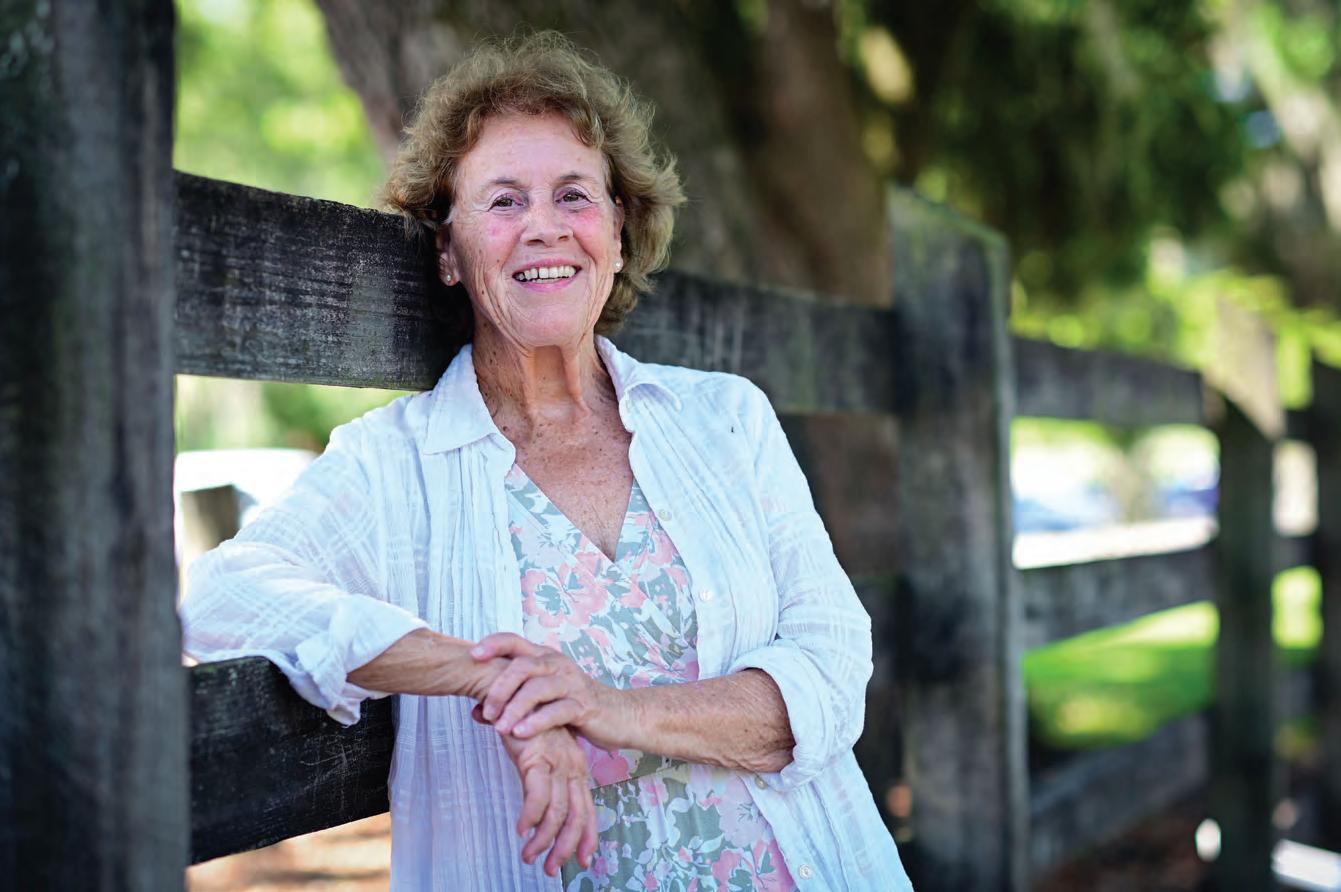

Each class concludes with a tea tasting from plants foraged on the property that day and the offer of a shovel for students to take home any plants that caught their fancy. He’s written five books on Louisiana flora, his most popular being Edible Plants of the Gulf South, and contributed to many books and botanical articles. Over the years, he’s served on countless boards, held directorships, and spoken to botanical and environmental groups across the US. Today, people flock to Allen Acres from around the world to study at the feet of this true Louisiana icon.
“I highly recommend that anyone interested in learning about plants begins in their own backyard,” said Allen. “Make a list of the plants there, then in your neighborhood, then in your town. You’ll be surprised at how much you already know. That’s how I started. I rode up and down the road. When I saw a plant I didn’t know, I’d go home and look in my plant books to see what I could learn about it. Today, there’s AI and plant-ID apps, but nothing beats first-hand experience and a few good plant-ID books.”
JUN 23 // COUNTRYROADSMAG.COM 38 HERBS & ELECTRICITY JUNE 2023
ACROSS GENERATIONS, LOUISIANA HERBALISTS TURN TO NATURE FOR HEALING
Story by Mimi Greenwood Knight • Photos by Paul Kieu and Cheryl Gerber
Photos by Paul Kieu
Roots, Unburied
For seven generations, Corinne Martin’s family has lived in Hahnville—a place where summers sent the children out of the house at first light, dashing back for lunch, then back out, not to be seen again until dark. “We lived a block from the intercoastal canal and spent our days swimming and exploring in the woods,” she said. “It was wonderful.” Now at seventy-six, nature is still where Martin can best “find herself”. But it wasn’t until her young daughter developed a debilitating case of asthma that she began to view the natural world around her as a source of healing.



“I’d never really heard of herbalism,” she said. “When a friend suggested I try treating my daughter with medicinal herbs, there was a huge learning curve for me.”

Martin bought her first herbal book, Dr. John Christopher’s The School of
Natural Healing. The 700-page tome was $40—a fortune at the time for a single mother. But for Martin it was worth every penny. “I started to use the medicinal plants I was learning about to help my daughter,” she said. “It allowed her to have some power over her condition. She’d say, ‘I feel really congested and I need a breathing tea.’ We could harvest the plants together and she could help me prepare the tea. As a kid, healing was suddenly something she had in her own hands.”
Continuing her studies, Martin was amazed to one day realize that within a three-mile radius of her home, she could identify 150 different healing plants. “Everywhere I walked, I started looking to see what was growing around me,” Martin said. "It was exciting to orient my life that way and I’ve done it ever since.”
That was over forty years ago. Martin went on to earn her clinical herbalist certification at The Institute for Traditional Medicine in Santa Fe, and to teach holistic and integrative health studies at the University of Southern Maine School of Nursing for almost twenty years. She’s written two celebrated books on medicinal herbs and is working on a third.
Her latest offering, Louisiana Herb Journal , is a love letter to her home state. Not only does it contain a wealth of information about native Louisiana herbs and their healing power, but with each herb the reader is invited into Martin’s world as she strolls the levee with her dog, Bodi, in search of boneset plants or foraging fleabane flowers at the ferry landing with a boisterous clutch of cousins. Her engaging prose is followed by each herb’s botanical name, common names, habitat, identifying features, harvesting guidelines, any associated folklore, herbal recipes, and a photo. It’s part science and part enchanting storytelling.
Even as Martin embraces herbal alternatives, she warns against getting stuck in the mindset that medicine has to be 100% alternative or 100% conventional. “We’re lucky in this country to have access to a spectrum of intervention,” she said. “We have options. Healing doesn’t always have to be something a medical expert does for you. You can be an active participant in your own healing and herbs can help you do that. But when we need conventional intervention, we’re fortunate to have access to that as well.”
//JUN 23 39
Photo by Cheryl Gerber
Empowered by Nature
"Here I was, climbing the corporate ladder and successful in my career, but I wasn’t enjoying my life. I had no time with my daughter. She was being raised by babysitters. I thought, ‘I’m not doing this anymore.’”


Santini reconsidered the things that brought her joy, reaching back into her childhood. Growing up in Pascagoula, Mississippi, she would spend every second she could with her grandfather, a botanist who owned a plant store, and her grandmother, who she said “could grow anything”. But her eureka moment came the day when she walked into the home of a friend and saw a jar of calendula-infused oil.

“It was so beautiful sitting on that windowsill in the sunlight,” Santini said. “I was hooked.” So, even as she continued working her corporate job, she began growing herbs and experimenting with making herbal infusions, decoctions, tinctures, and elixirs. She started tentatively selling her recipes at street fairs and festivals and eventu ally convinced her husband to sell everything, downsize, and move back to his home town of Hattiesburg, Mississippi.
From that day forward, Santini sunk any money she made selling her herbal rem edies back into her fledgling business and any free moments into teaching herself about the healing power of herbs. They were lean years. When her marriage came to an end, Santini called her dad, a longtime resident of Olde Towne Slidell. “I told him I had to get out,” she remembers. “His exact words were, ‘I’ve got your back.’” Santini and her daughter relocated to Olde Towne. Her fa ther loaned her some money and told her to get what she needed to start the business she wanted.
That initial output was under $5,000. But the real investment, San tini said, was the time she spent educating her customers and build ing their trust, teaching about the benefits of using products that are all-natural, plant-based, not tested on animals, and ethically sourced. “Once people connected with me they were willing to lis ten and learn,” she said.

Santini’s business crept along from occasional street fairs and festivals to a tiny storefront with a handful of customers, and eventually, to the rambling, historic building that now houses her Green Oaks Apothecary, a hub of Olde Towne and a godsend to those seeking herbal alternatives. But even as her apothecary prof fers room after room of herbal teas, vitamins, supplements, essential oils, candles, plant-based body-care products, local art and jewelry, fair-trade goods, crystals, CBD products, and an absolute cache of dried medicinal herbs, the real value is still in the education Santini and her staff provide. She’s hand-selected credentialed young people who are just as passionate about herbalism as she. “Education is the foundation of everything we do,” she said. She installed an educational herb garden in the side yard and invites customers on walks around the neighborhood pointing out medicinal plants growing through cracks in the sidewalk.
At forty-seven, Santini’s goal is to inspire the next generation of herbalists. “I still learn something new about herbs every day,” she said. “I hope I can say that when I’m ninety-seven.”

JUN 23 // COUNTRYROADSMAG.COM 40
Photo by Cheryl Gerber
Looking to the Future
The first time Alexis Badon saw a passionflower growing wild, it blew her mind. An avid camper, she’d spent a lot of time in the wilderness growing up. But the sight of that single Seussian blossom when she was sixteen stopped her in her tracks. She dashed home and started researching the plant online. Her search revealed that in addition to being fun and funky-looking, passionflower blooms, leaves, and stems have been used to treat anxiety, insomnia, seizures, stomach problems, burns, heartrhythm problems, hemorrhoids, pain, menopause symptoms, and attention-deficit hyperactivity disorder (ADHD). And that was just one plant.
Eager to learn more, Badon began spending all of her free time researching and educating herself about herbal medicines. She especially connected with Stephen Harrod Buhner’s Herbal Antibiotics and Herbal Antivirals series of books. She signed up for a Rosemary Gladstar’s Science and Art of Herbalism course and completed her herbal certification. She ordered small amounts of one hundred different herbs and began experimenting with flavors and flavor combinations.
It was an engrossing hobby. But it became more than that when her three-yearold daughter developed a swollen gland. “It was the size of a grapefruit on the side of her neck,” Badon said. “It was a terrifying thing to see on your child. I started giving her cleavers I’d foraged, and the gland was back to normal in three days.”

Now at twenty-eight, instead of studying and experimenting with herbs as a hobby, Badon has made them her main focus. She chose the name Magnolia Moon Herbals for her business as an homage to her Southern heritage, starting off small in her hometown of Lafayette. She began selling medicinal teas, frozen lemonades, and herbal coffees at festivals around the country from Florida to Ohio, from Arkansas to Texas, and at stores and cafés in Lafayette.

She established a presence at the farmers market where her regulars line up for concoctions such as strawberry jasmine green tea, dragon fruit and satsuma lemonade, lemongrass mint limeade, frozen watermelon hibiscus lemonade, lavender lemonade, and other surprising combinations.



On her website, Badon sells dry tea blends, tinctures, herbal elixirs, balms, and salves. “I started my business with $300 and just grew as I was able,” she said. Like Santini, Badon says the most important part of her job is education. “It’s thrilling to see how eager people are to learn about herbs,” she said. “I’m passionate about balancing traditional and herbal medicine. My best friend from childhood is a



//JUN 23 41
allenacresnbandb.com • corrinemartinauthor.com greenoaksapothecary.square.site • magnoliamoonherbals.com
Sip into Summer! Sip into Summer! May 1 - July 31, 2023 May 1 - July 31, 2023 Sponsored by Ascension Parish Tourism Commission PURCHASE 8 LOUISIANA’S SWEET SPOT COCKTAILS & YOU’LL BE ENTERED INTO A GRAND PRIZE VALUED AT $600! LEARN MORE & DOWNLOAD YOUR PASSPORT HERE: visitlasweetspot.com Passports are available at the participating businesses above & the Ascension Parish Visitor Center at 6967 Hwy 22, Sorrento, LA 70778
Photo by Paul Kieu
Going Electric
By Ed Cullen
Flying down the street on my son’s electric bicycle, the exhilaration I felt was tempered by a long-ago disaster.
I was eight. My cousin Bobby, who was in high school, had decided it was time I learned to ride the massive Columbia bicycle I’d gotten the previous Christmas. The seconds before I hit a concrete street marker in the shape of the Washington monument I was yelling over my shoulder, “Brakes! How do you put on the brakes?”
That memory loomed large as the bicycle’s electric motor boosted my pedaling to fifteen miles an hour, then eighteen, then twenty. It occurred to me that, maybe, bicycles shouldn’t go this fast. I had another thought: I don’t need an electric bicycle, but I want one.
E-bikes make good sense on Tacoma and Seattle’s roller-coaster hills, where I was first introduced to motor-assisted cycling. When I was staying in Tacoma, there was a bicycle shop near the bed and breakfast. I wandered in and spent the next hour learning about these electric bicycles from a young owner, a disciple of the boosted bike movement.
The Benefits of an E-Bike
The ease of pedaling assisted by an electric motor appeals to folks who haven’t ridden a bicycle in a long time, or generally people who want to get more ground for their output. If you have old knees, ride a lot, and grocery shop or run errands on a bicycle, an e-bike is something you might consider. If you live in Baton Rouge and have the confidence to ride a bicycle over the Perkins Road Overpass or, better, the North Boulevard or Valley Street overpasses—both of which have bicycle lanes—you will appreciate the help an e-bike affords.
Baton Rouge resident Donna Mitchell first test rode a Pedego e-bike at a bicycle festival one weekend, then bought the very same bicycle a few days later, her husband Ray following soon after “to keep up with me,” she said.
“I’d gotten to where I couldn’t ride a bicycle anymore because of my knees,” she said.
Ray, a mountain biker, still rides a traditional bicycle off-road, but uses his e-bike to grocery shop near the Perkins Road Overpass or pickup prescriptions at a drugstore on Government Street.
“Older riders are riding longer distances with e-bikes,” said Chris Carson, owner of eBike Baton Rouge and eBike NOLA. “You decide how much assisted pedaling you want. E-bikes make it easier for husbands and wives to ride together. I ride faster when I ride by myself, but my wife and I ride e-bikes together and do 15 mph,” he said.
In the right environment, e-bikes can even replace a traditional vehicle. When one of Amanda and Nick Lanata’s cars started needing repairs, they decided to sell it and buy an e-bike.
“I challenged myself,” said Nick, who works from his Zachary home, “to see if I could make an investment in an e-bike instead of a second car.” In the end, Zachary’s lack of bicycle infrastructure hindered those plans, but Nick still rides for exercise in his neighborhood.
E-Bikes in Baton Rouge
E-bikes are fun to ride. They are easy to maintain assuming you buy from a local shop that services what it sells. Buying locally usually means getting a warranty through the manufacturer.
Baton Rouge’s traditional bicycle
shops, like Capital Cyclery on Essen Lane, will order an e-bike for a customer from dealers like Specialized, Cannondale, Electra, and Haro, with prices starting around $1,700.
But in recent years, the city’s gained two e-bike-only retailers: Pedego on Jefferson Highway and eBike Baton Rouge on Perkins Road. Pedego has been around nationally since 2008 with two hundred locally-owned stores in the U.S. Owner Steve Harvin opened the Baton Rouge location in 2021. Pedego bikes go for between $1,500 and $5,500. Addons can push the price much higher. The store’s website says the average price tag is $2,000 to $2,500.
Chris and Jeanelle Carson opened eBike Baton Rouge last September. Their New Orleans shop, eBike Nola, is almost eight years old. They sell Aventon and Qualisports e-bikes (which are folding bicycles), with prices ranging from $1,000 to a little over $2,000.
“At least sixty percent of our customers are over fifty,” Chris said. “E-bikes are used more for transportation in New Orleans than Baton Rouge. A lot of our customers buy e-bikes to carry on their RVs or to ride at second homes.”

Safety Concerns
It turns out that my initial trepidation about the danger of going so fast on a bicycle was not totally unfounded. The U.S. Consumer Product Safety Commission findings show a higher risk of serious injury among electric scooter and e-bike riders.
Injury, though, comes down to speed, braking, and obeying the rules of the road. To paraphrase the gun lobby, electric bicycles don’t injure people, people on electric bicycles injure people—themselves and hapless pedestrians walking dogs on leashes, pushing strollers, walking or running on our crowded hike/bike paths.
Know Before You Go
Before you shop for e-bikes, do some research to better understand the salesman’s spiel about size of motor, volts, amperes, gears vs. no gears, throttle advance, battery life, charging time, top speed, and cruising range.
Classes of e-bikes include options of pedal-assisted only and options in which you could get somewhere without pedaling at all (pedaling increases cruising range and speed), each of these going up to 20 mph. The highest class of e-bikes goes 20 mph on full electric and up to 28 mph pedal-assisted. For someone with bad knees who wants to exercise on a bicycle, an assisted speed of 15 miles an hour is plenty fast. If you have hills or overpasses to negotiate, then more power makes sense. Keep in mind that narrow, crumbling, pothole-laced bike paths crowded with walkers and runners is not where you want to be doing 25 mph on a bicycle. •
JUN 23 // COUNTRYROADSMAG.COM 42
CYCLING
E-BIKE
THE INS AND OUTS OF THE
FAD
Scaling New Heights
At Pennington Biomedical Research Center, Dr. Claire Berryman is uncovering the connections between altitude and weight loss

In the field of weight loss research, traditional approaches like diet and exercise have long taken center stage. But what if there were a hidden factor that could hold the key to unlocking the body’s calorie-burning potential? Meet Dr. Claire Berryman, Ph.D., RD, an enthusiastic dietitian and visionary researcher at Pennington Biomedical Research Center, who is on a quest to shed light on the intriguing connections between altitude and weight loss.
Dr. Berryman has an extensive academic background in nutrition science and metabolism studies, and she has dedicated her career to investigating the little-understood role that time spent at high elevations plays in achieving healthy weight. Her passion for the field took root at Penn State University, where she earned an undergraduate degree in Nutritional Sciences, and then a Ph.D. in Nutritional Sciences, which ignited a desire to delve deeper into human metabolism and the effects consuming whole foods, like almonds and walnuts, have on cardiovascular health.
After completing her doctoral studies, Dr. Berryman embarked on a nine-month Dietetic Internship at the James A. Haley Veterans’ Hospital in Tampa, Florida—a clinical hospital setting in which she observed first-hand how nutritional interventions can complement medical treatments. Dr. Berryman credits the experience with helping her develop a more holistic appreciation of the nutrition and dietetics field.
Dr. Berryman’s dedication to her subject matter led to a postdoctoral fellowship at the U.S. Army Research Institute of Environmental Medicine (USARIEM) in Natick, Massachusetts, during which she contributed to a study at USARIEM’s Altitude Research Laboratory on Colorado’s Pikes

Peak—at an elevation of 14,115 feet above sea level. This rarified environment offered a unique platform from which to explore the effects of high altitude on human performance factors, including energy expenditure and appetite regulation. Dr. Berryman’s work confirmed that time spent at high elevations leads to dramatic body mass loss in young, healthy individuals military population, but potentially helpful for people with obesity.

In August 2022, Dr. Berryman joined the team at Baton Rouge’s Pennington Biomedical Research Center average elevation, 43 feet. Funded by a $2.3 million grant award from the National Institute of Diabetes and Digestive and Kidney Disease, a division of the National Institutes of Health, Dr. Berryman is testing this hypothesis with a comprehensive research study titled the Low Oxygen and Weight Status, or LOWS. Subjects follow a calorie-restricted, controlled diet while spending time at a simulated high elevation to investigate the intricate mechanisms by which altitude influences weight loss.
“We have designed a study that includes a two-week weight maintenance phase, followed by an 8-week period where randomized participants will either sleep in altitude simulation tents or in placebo tents,” Dr. Berryman explains of the LOWS study. “We will carefully monitor [the participants’] weight and metabolic changes throughout the study to gain deeper insights into the effects of altitude, the hypothesis being that the group that sleeps in the hypoxic tent will have more weight loss, due to greater energy expenditure, and improved glucose regulation and insulin sensitivity.”
Driven by her passion for improving health outcomes by exploring how altitude affects body mass, Dr. Berryman’s work at Pennington Biomedical is paving the way for personalized interventions that have the potential to transform the landscape of weight management. If the study proves successful, Dr. Berryman and her colleagues plan to explore strategies for implementing LOWS on a larger scale. Their goal would be to apply LOWS to the cornerstones of obesity management, which remain rooted in exercise and dietary changes.
“Pennington Biomedical has one of the best nutrition and obesity research programs in the world. I learn so much every day from my colleagues, mentors, and visiting scientists. We have access to state-of-the-art research equipment and facilities. I’m glad we have ways to simulate high altitude, so that I was able to join Pennington, in the sea level state of Louisiana, and benefit from its many resources and opportunities.”
//JUN 23 43
A special advertising feature from Pennington Biomedical Research Center For more information about Pennington Biomedical Research Center, visit www.pbrc.edu. Scan here for more information.
Return to Paradise
A NEW ERA AT FOLSOM'S GLOBAL WILDLIFE CENTER


photos
Driving through the gates of Folsom’s Global Wildlife Center, the sprawling open landscape stretched beyond as I slowed my car to a stop, allowing a group of fallow deer and a lone rhea to leisurely cross the gravel drive in front of me. Maybe it was simply my inner child of the ‘90s projecting some cinematic drama onto my Northshore safari adventure, but entering the 900-acre park containing thousands of rare animals, I started to hear John Williams’s “Theme from Jurassic Park” playing in my head. No clones of dinosaurs live here, thankfully—but much like Spielberg’s prehistoric theme park, Global Wildlife Center is home to a wide range of creatures one would never expect to find on that particular plot of land in Tangipahoa Parish. And while the animals here aren’t de-extinct, some species are severely endangered, or have even been brought back from the very brink of extinction.
Among these are reticulated giraffes, Grant’s zebras, Bactrian camels, American bison, various rare species of deer and antelope, and many more—largely roaming free. This model allows the animals to form herds, similarly to the way they would in the wild—except at Global, there are no predators. And each animal enjoys the world-class care of an exotic animal veterinarian, along with a team of local vets on call. Not to mention the admiration of wagon-loads of visitors—there to gain an up-close appreciation and understanding of each species along the way.
When I pulled up at the Visitor's Center, I was greeted by Global Wildlife Center’s Executive Director Christina Cooper, owner/CEO Maci Matherne, and Tours Manager Casey Cousins. We said “hi” to a large male peacock surveying the picnic
tables before we hopped into an open-air Pinz.
As the Pinz ambled along the gravel drive and off of it, Cousins’s cheerful voice regaled us with fun facts over the rumbling motor, periodically interrupted by our giggles and coos of delight as various creatures confidently approached, sticking their heads into the open vehicle to greet us and solicit treats from the large feed bag we carried.
One of the first things that struck me during the tour was the wide variety of personalities we encountered across each species, and how unhesitant the animals were to show off for visitors. From Dali (a llama), to Winston (a 2,000-pound Holstein cow), to the alpaca Lil’ Red and her mom Farmer Red (known to frequently dangle a piece of straw from her mouth), to Lucy the Watusi (a type of cow originating from East Africa), and on and on—the range of wild residents at the Center (a large percentage of whom have names) is enough to make one’s head spin.
Beyond meeting the individual animals themselves, on our tour I also gained a trove of new knowledge about these exotic species. I now know, for instance, that llamas have incredibly short tongues, which is why their mouths are cleft in the middle to allow them to pick up food. I learned that the darker an Indian blackbuck’s coat is, the more testosterone the animal produces; that no two zebras have the same coat markings, and that they’re also the only animals at the Center too aggressive to be fed on tours. I learned that lore explains the cross markings on Sicilian donkeys’ backs as remnants from their Biblical role of carrying pregnant Mary to Bethlehem. Giraffes’ tongues, it turns out, are purple for a reason: to act as a natural sunblock as they graze from the tops of trees.
JUN 23 // COUNTRYROADSMAG.COM 44 INTO THE WILD 44 OH GIVE ME A HOME WHERE THE BUFFALO ROAM, WHERE THE DEER AND THE ANTELOPE PLAY // 49 ROADTRIPPING ON THE TRACE // 50 PARADISE ON DA
JUNE 2023
HERD MENTALITY
GRANDPAW BAYOU
Escapes
Story and
by Alexandra Kennon
When we pulled up to the giraffe barn, half a dozen female giraffes laid relaxing in the shade, watching us from afar, unbothered. “This is pretty cool,” said Cousins. “You’ll see the giraffes laying down in the grass, relaxing. This is not something that you would typically see them do in the wild. They’re only doing this right here, right now, because we have no predators.” In the wild, giraffes are always on alert for the constant threat of their many predators, and do almost everything standing, including sleeping.
This particular enclave of giraffes seemed to be enjoying the lower stakes, certainly. We dub them “the girls’ club,” laughing. Cooper, Matherne, and Cousins are clearly still not over the wonder that comes with seeing such animals at arms’ length. And as a first-timer to the Center who had only previously

encountered such exotic creatures on the other side of zoo enclosures, I found myself overwhelmed with child-like excitement the entire afternoon.
“We have Kya, Maci, Keisha, Sara, and little Magnolia,” Cousins gushed, introducing the giraffes before us. Since my visit, another baby giraffe, Amari, was born at the Center in March 2023. “Magnolia is getting pretty big already—she’s about to make two years. They’re born about six feet tall, though.”
At this point, one of the female giraffes, Maci, leisurely stood up and approached the vehicle, her long neck snaking inside to greet us. “She must know Maci’s here,” Cousins laughed, pointing out that the giraffe’s namesake is Global Wildlife’s owner Maci Matherne. “I didn’t name her after myself,” Matherne clarified with a dry laugh. “That was my dad’s doing.”
A New Era

Matherne’s father Ken founded Global Wildlife Center in 1991, when she was a year old. Even having grown up around the Center, she’s quick to say that the proximity to its exotic residents still holds its magic.
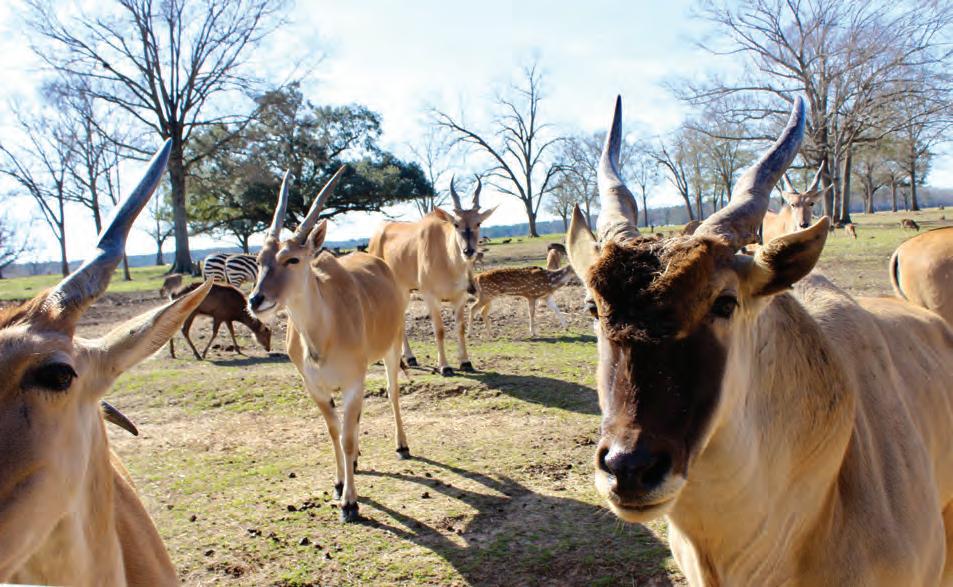
Since her father’s passing in the fall of 2021, Matherne’s transition into ownership of Global Wildlife Center has been far from easy. During the last decade under his leadership, the Center had come under serious scrutiny for how it managed the animals’ medical care, among other allegations including racially-exclusive hiring practices and misappropriation of nonprofit funds. Since Matherne has taken over, she and the current administration have gone to enormous lengths to address these issues and ensure Global Wildlife Center is a place she, and the Northshore as a whole, can be proud of.
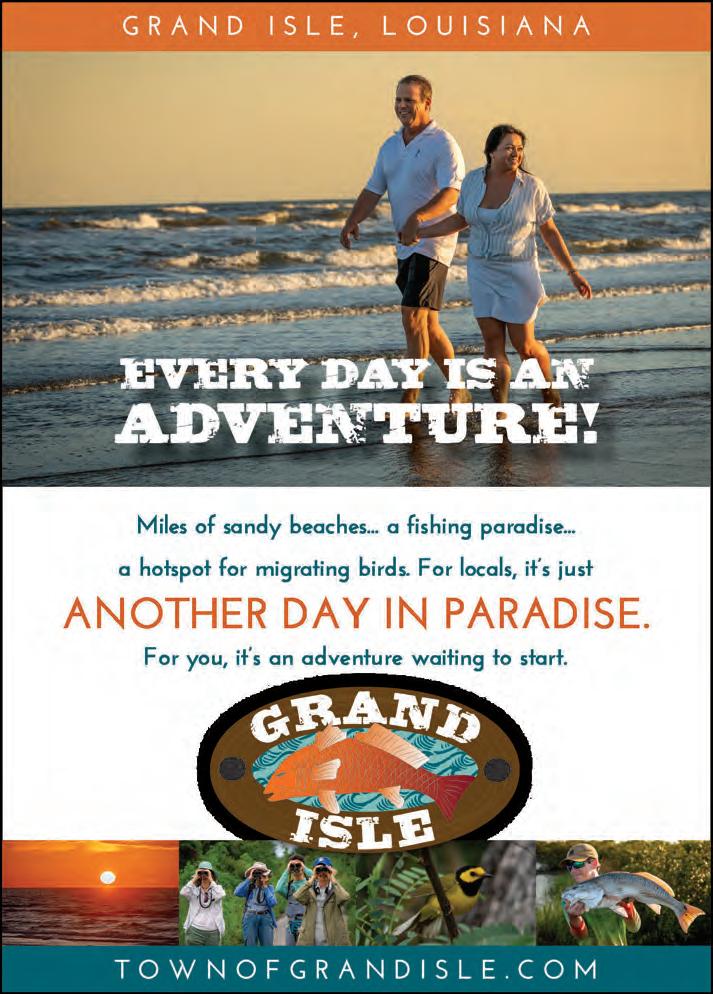
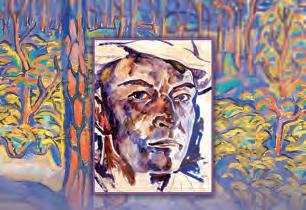
“The past year and a half has been full of personal challenges because of the passing of my father and our complicated relationship. But the core of Global Wildlife Center’s story is that he created something more than thirty years ago that has brought such joy to me and also to hundreds of thousands of people,” Matherne said. “I am humbled to be able to put my own mark on the Center and take it in a direction that aligns with my personal and professional values.”
Matherne’s first step as owner was to bring Christina Cooper back on as Global’s Executive Director. Cooper started as a tour guide at Global back in 1996 after taking a safari tour—and since then, working at the Center has remained her "dream job”. “I was finishing up my senior year at LSU with a degree in animal science and I commuted an hour each way to earn minimum wage because I loved it so,” Cooper said.
//JUN 23 45
www.lpb.org FINAL SEASON PREMIERE Sunday, June 18 at 8PM Wednesday, June 7 at 8:30PM Thursday June 8 at 7PM WALTER ANDERSON The Extraordinary Life and Art of the Islander
Mining the Surfaces
GEORGE DUNBAR
Cape Eland antelope at Global Wildlife Center.
After graduating from college, she went to South Africa to assist with a reproductive studies research project overseen by the Henry Doorly Zoo in Omaha—which made her realize working in a laboratory was not her calling. “For the next fourteen years, I worked nearly every position at Global Wildlife Center and gave my heart and soul to the organization, working tirelessly to help it grow and flourish," Cooper said. "No matter what position I was working, the opportunities to connect with people and children and share a love and respect for wildlife always brought me such joy.”
In 2010, Cooper left the Center to pursue invaluable opportunities in the fields of wildlife rehabilitation and public relations: volunteering at a wildlife rehabilitation center and game preserve in South Africa and serving as education manager at The Elephant Sanctuary in Tennessee, before returning to St. Tammany Parish, where she spent a decade working for the Tourist Commission.
“The life and career experiences I was blessed to have upon my departure from Global Wildlife Center in 2010 have prepared me for this opportunity to return as Executive Director and continue to elevate the organization,” Cooper said with confidence. “I feel incredibly blessed to return to Global Wildlife Center and be supported by Maci, the staff, and the community as a whole to help the Center realize the dreams I established for it from my very first days here. It’s exciting to see projects and initiatives I dreamed of years ago being put into place now.”
The Foundation’s Board of Directors and Matherne clearly recognize the value of Cooper’s vision. “I mean this wholeheartedly when I say there is no one on this planet besides myself who is more passionate about Global Wildlife Center,” Matherne told me, describing Cooper. “She is an incredibly empathetic and effective leader who has brought our team together in a way I believe is unique to her personality and talents. There is no one I would trust more to continue to make Global Wildlife Center the best version it can possibly be.”
Together, Matherne and Cooper are in lock-step as they usher in a more ethical and intentional future for Global
Wildlife Center. “Maci is not only brilliant, but she is also socially conscious, possesses a high moral compass, is built of strong character and is a very compassionate leader,” said Cooper of their partnership. “We are committed to investing in excellence for animal care, organization best practices, team development, and supporting local and worldwide wildlife conservation and education.”
Led by this vision, the administration at Global Wildlife is currently making its way through a strategic planning process designed to ensure the Center continues to thrive and realize its fullest potential, while having a positive impact on the next generation of conservation enthusiasts.

While Matherne believes in a “people first” approach to ensuring a positive work environment for employees and first-class experiences for guests is paramount, running parallel to these priorities is a firm commitment to animal welfare. “Of course, we’re a bit unique in that we also have the great responsibility of housing some of the most amazing animals from all over the world at our facility, and the most comprehensive care for our animals will always remain top priority for me in running the center,” she said. “So, you might say that I have both a ‘animals-first' approach and an ‘people-first’ approach. Both philosophies are incredibly important to me personally, and to the success of this organization.”
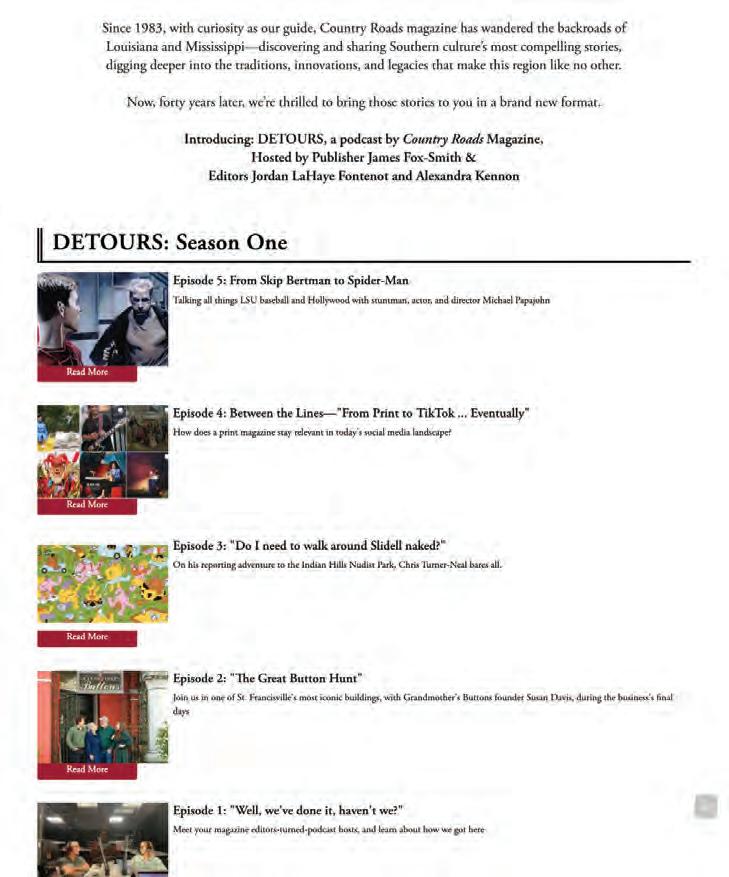
Reflecting these ideals, some of the tangible changes made under Global Wildlife’s new administration include actions designed to prevent misuse of funds and increase transparency. As of earlier this year, Matherne and the Global Wildlife Foundation’s Board of Directors officially agreed to separate the Foundation from the Center's operations— recentering the Foundation’s focus to deal solely with philanthropic efforts supporting animal conservation initiatives including wildlife reintroduction, conservation in the wild, conservation education, local animal and educational charities, and minimizing human-wildlife contact.
Matherne has also committed to contributing a portion of proceeds from the Center’s operations back to the Foun-
JUN 23 // COUNTRYROADSMAG.COM 46
At Global Wildlife Center, wagon tours and private Pinz tours allow guests to interact with exotic wildlife up-close. Image courtesy of the Global Wildlife Center.
dation’s efforts. “That means that in addition to learning and having fun, each guest who comes to Global Wildlife Center will know that they’ve made their own impact on the future of animals, both locally and around the world,” she said. One such example was a $15,000 donation the Foundation made this year toward the Giraffe Conservation Foundation’s efforts in Namibia, with plans for many more such contributions in the future.
Matherne and Cooper have also implemented pay increases across the board for staff, including added bonuses, paid time off, and health care for eligible team members. “I’m committed to fostering a work culture that promotes a healthy work-life balance so our team can enjoy their time at work, but most importantly their full lives outside of work,” Matherne told me, also emphasizing inclusivity as a priority within Global Wildlife’s workplace. “We want our guests to be able to identify with our team,” she said, noting that many of the staff are students of biology, ecology, and other related fields at the nearby Southeastern University in Hammond. All managers at Global Wildlife now receive diversity and inclusion training.
Other investments that have been made by the new leadership involve extensive improvements to the Center’s facilities. Road work, new vehicle aquisitions, landscaping, updates to the wagons and their PA systems, a new boardwalk, a new kangaroo shelter, renovations to the Visitor Center, and improvements to the giraffe barn are just the beginning, according to Matherne.
But on this extensive list of projects and changes, she cites improved veterinary care at the very top—especially the decision to bring on “rockstar” exotic animal veterinarian Dr. Jonathan Bergmann as the Center’s attending veterinarian.

Growing up at the animal sanctuary his father founded, Popcorn Park Refuge in New Jersey, Bergmann discovered his passion for exotic animal care early on
and now operates his practice as a mobile veterinarian, serving exotic animal refuges and zoos across the country. “I could speak all day about how amazing Dr. Bergmann is, but he truly is one of the most respected experts in exotics medicine and has been an absolute pleasure to work with,” Matherne said. “He is constantly providing training and mentorship to our excellent animal care team and they all continue to impress me with the level of knowledge, care, and expertise they bring to the organization.”
In addition to bringing Bergmann on at the end of 2021, Cooper told me Global has consulted with a nutritionist to analyze the herbivore diet animals are fed from the safari wagons, placed two of their oldest giraffes (Kameel and Zira) on birth control, and begun construction on a chute for the Center’s giraffe barn to facilitate safe veterinary procedures without necessitating anesthesia. Bergmann has also connected the Center with researchers and academics who can benefit from studying the behaviors of the animals, whose massive free-range habitat allows them to be observed in an environment that is very similar to what they would experience in the wild—as opposed to traditional zoos and most other, more-limited, wildlife habitats.
The Center is also working with Bergmann on eventually attaining accreditation from the Zoological Association of America, which would set it apart as an example to other institutions for animal care and welfare.

Though Matherne and Cooper have enacted measures like adding metal fencing around the safari wagon tires to prevent animal injuries (a major concern during the previous ownership), Bergmann is immediately consulted if an animal becomes sick or incapacitated in any way. The Center’s onsite animal care team monitors and assesses each animal's health throughout the day, and tour educators also participate in "Animal Care Helper" training, which allows them to quickly identify compromised animals, as well. When this happens, Bergmann
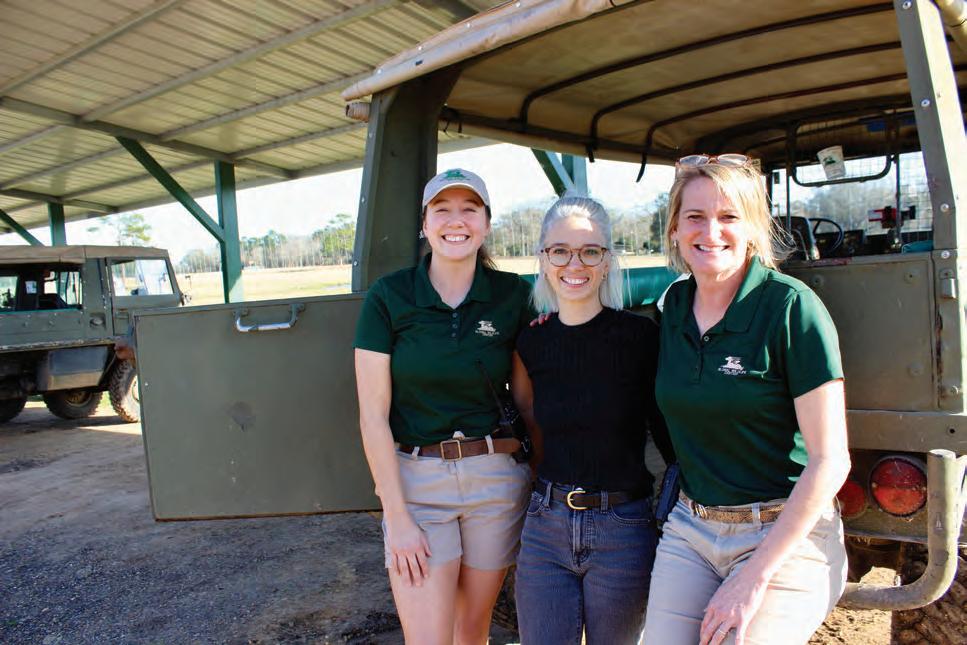
//JUN 23 47
(Left to right) Global Wildlife Center Tours Manager Casey Cousins, owner/CEO Maci Matherne, and Executive Director Chrisina Cooper freshly returned from a Pinz tour of Global Wildlife Center.
is consulted via video and phone. Often for minor cases, Bergmann can prescribe treatment remotely, which can then be administered by dart by the animal care team.

If an animal requires emergency care, the Center will call in one of the on-call local veterinarians who consult with Bergmann—who visits the Center himself several days a month to perform routine procedures.
“Working with the staff, the energy, and the passion the staff has, it sparks me. When I’m teaching them something, they are just so ready to learn and eager to be there,” Bergmann effused. “Every animal, they all get looked at every day. If they have a limp, they get treated right away. And for the staff and management to know that and address that right away—that’s important, because you don't want an animal in pain or limping or having a problem that needs to be treated right away. And the staff are so good about that. With our communications and treatments, I know and I'm comfortable saying all those animals are taken care of so well there, and looked over so well.”
Caring for thousands of animals across hundreds of acres is no small task, but according to Bergmann, the effort is incredibly worthwhile in terms of animal research and conservation. “It’s so valuable there to have that large scale footprint. It's different than any other zoo,”
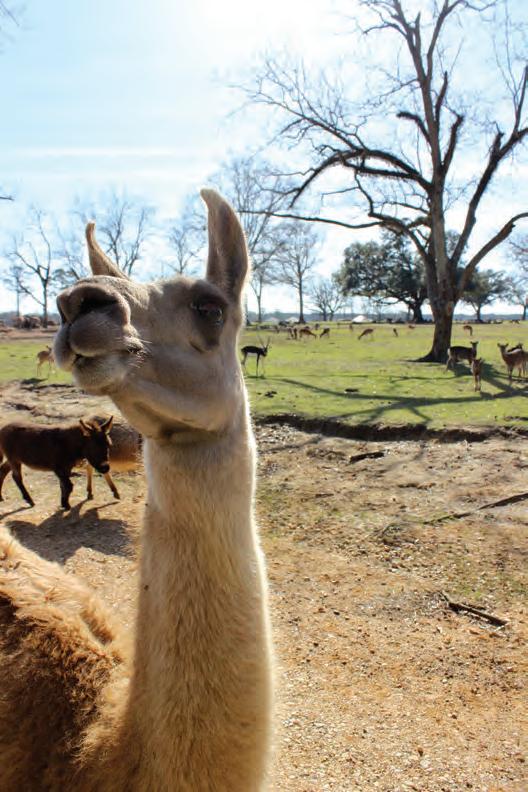
Bergmann marveled, citing the San Diego Zoo and The Wilds in Columbus as the only other facilities in the country that can even compare in scale. “There’s other large places like that, but this is huge. It's really amazing to see those animals act the way they do out there, in a large herd size.”
One population at Global that is particularly valuable for researchers to study is the Pere David’s deer—the rarest of all the animals at the Center, technically extinct in the wild. A herd of over six hundred—possibly one of the largest herds of them left in the world—thrives at Global today. “You don't see those anywhere, really. And there's several hundred there, that's amazing,” Bergmann said. “And then my kind of favorite is the giraffes, I mean, to have a large herd to work with like that.”
In addition to the data such herds can provide to the fields of animal science, they also offer a vital education about different species and the importance of their conservation to visitors and families who visit Global. Guests leave with ample information about giraffes and zebras and rare deer—and they also might get to experience the surge of serotonin that comes from being face-to-face with a giraffe, feeling the rare sense of connection as the remarkable animal snakes her long, purple tongue into a cup of food held in their hand. The animals provide entertainment, but also an awareness
about endangered species that’s especially powerful for hands-on learners.
“The conservation level!” Bergmann effused. “All of these children and kids— when I’m working there two or three days in a row, and the tour bus loads go through, there's children learning about these animals and conservation and the environment. I mean, that's so valuable; it's providing something for the community, tourism, they're bringing a lot to the area, and everybody's learning. The level of education they can put out, on this massive footprint of ground, everybody can see the animals naturally … People need to know about the place, because it is amazing. It’s like Jurassic Park, I like to joke. I can drive around on my little four-wheeler ATV, I travel in there and it's like, you can drive forever looking at animals.”
While the new administration’s overhaul of Global Wildlife Center’s facility and operations has been a massive undertaking, Matherne and Cooper agree the rewards far outweigh the challenges. “Some of the most rewarding things for me have been the simple interactions I have with visitors as they return from their tour, or chatting with our staff and hearing how much they appreciate some of the changes we’re making, or getting to snuggle with one of our new baby llamas in the nursery and knowing that its future is bright,” Matherne said. “I am surrounded by the best possible
team and have had huge support from the Board, friends, and family members. I could never have made it this far had it not been for my community lifting me up. I couldn’t be more proud of the strides we’ve made in just a year and I am genuinely excited as I look toward the future.” •
globalwildlife.com

JUN 23 // COUNTRYROADSMAG.COM 48
The Top of the Trace
By
Some years ago, one of the first travel pieces I wrote for Counhtry Roads was about most of the Natchez Trace—I had time to go on a portion of it, from Tupelo on down. My father’s sister had always wanted to go on the Natchez Trace, and over the past few months my father, my cousin, me, and my aunt—mayor of her town—went through the grinding comparison of calendars that would allow four adults to travel together. This March, we made it work and spent three days doing the whole thing: toe to tip, stem to stern, soup to nuts, except for a short section under repair. Here, therefore, is my make-good to Country Roads readers: the Top of the Trace.

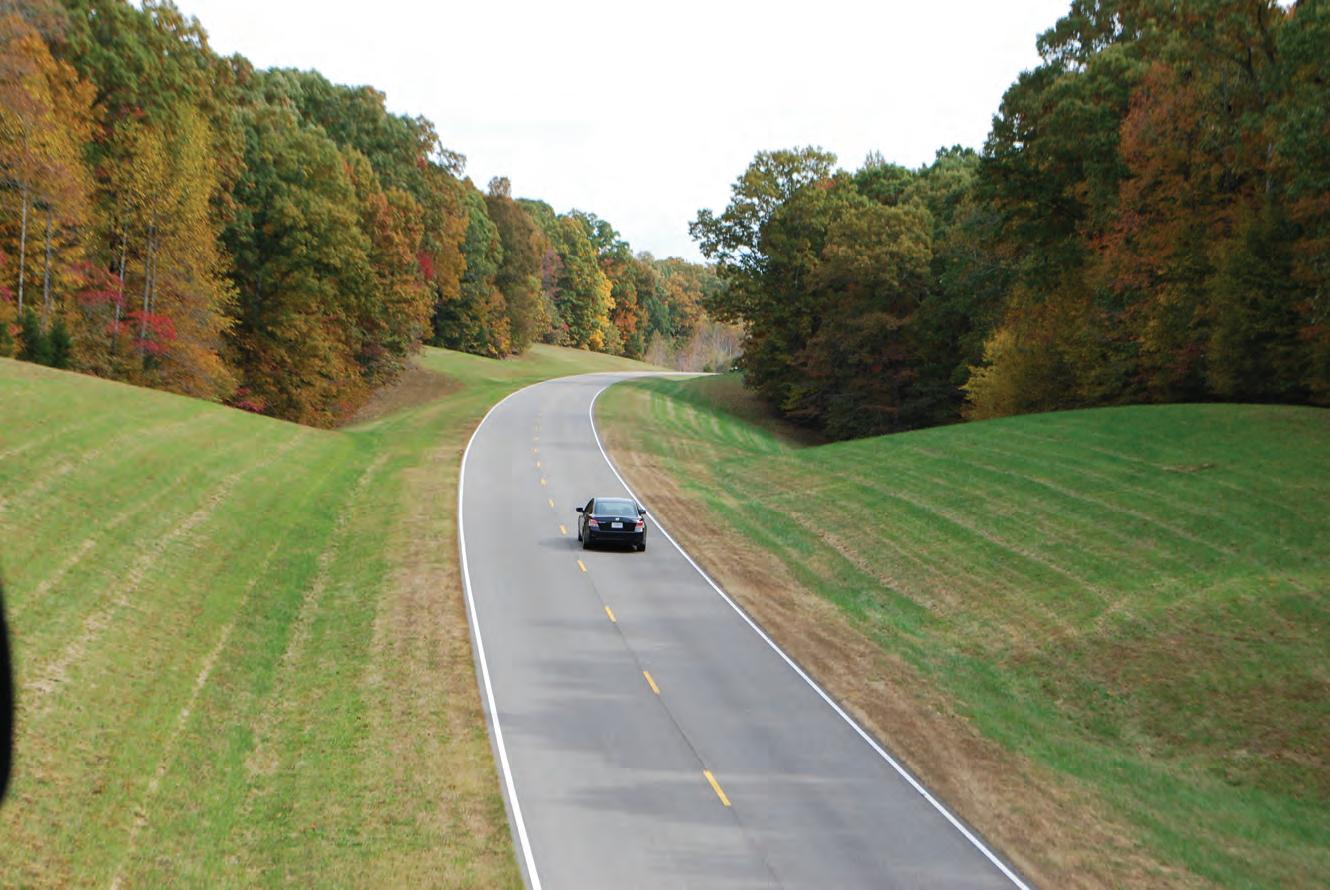
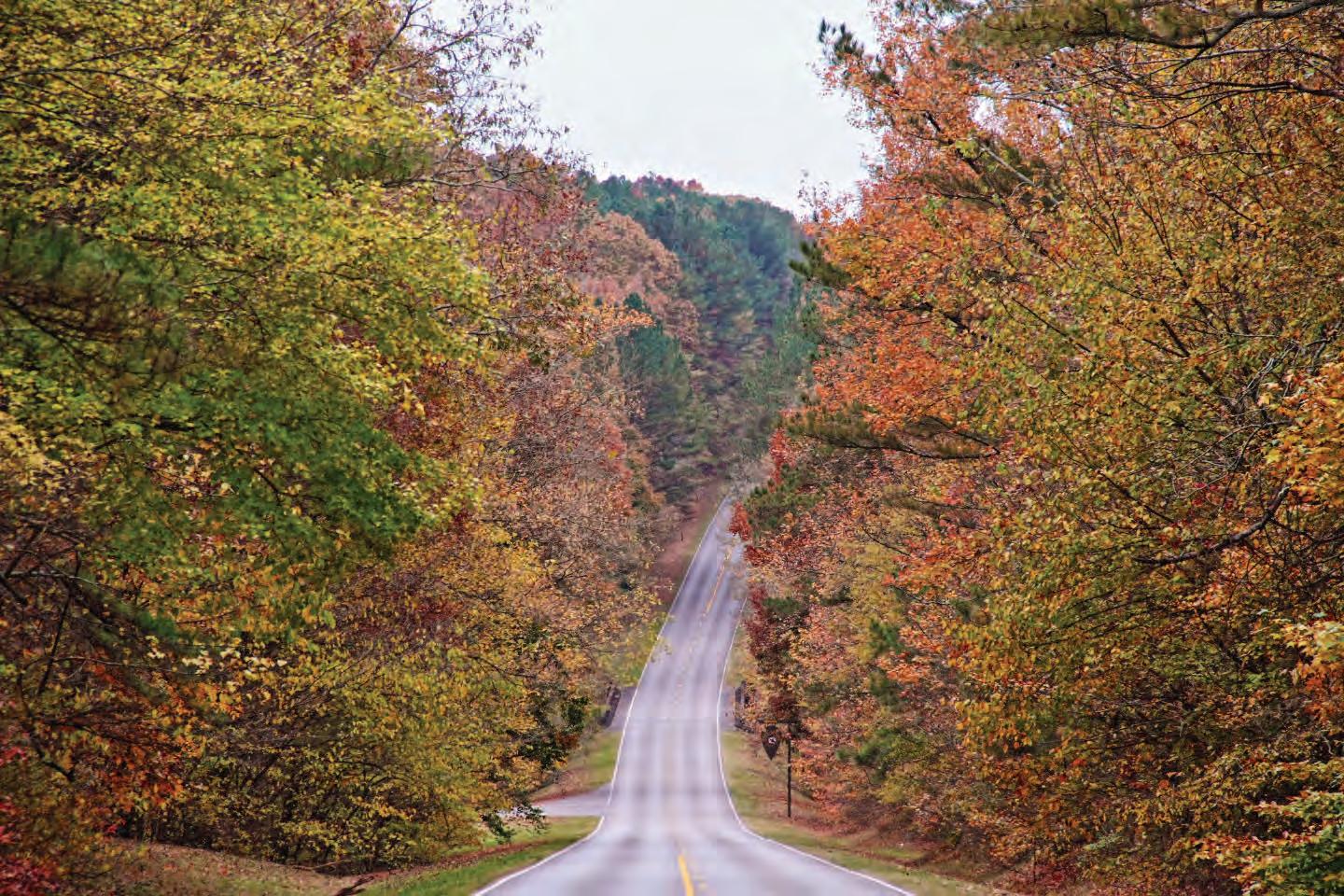
As you’ll know if you’ve spent any time on it, the Natchez Trace draws much of its charm from its leisurely pace, and we spent the first day doing a lot of pulling over to read signs and look at plants. We were early enough to catch dogwoods and redwoods flourishing, with some sections of the Trace showing more lavender and white than green. The wisteria was out too, languid and fragrant, and I ultimately traced the other “good smell” to the black locust tree, which doesn’t sound like it would smell particularly nice, but whose balls of dainty white blossoms perfumed much of the road.
Allman slept there.” Founder Rick Hall’s widow Linda still keeps the books and captivated a small group in the lobby with some family tales. She prefaced the story with the phrase, “now, I don’t want that guy who’s writing the book to include this, but…” so in good conscience I must draw a veil over it, but if you go to the studio and she seems chatty, chat back.
My family flew into Nashville, and I drove up to collect them; we assembled at a hotel in Brentwood, a suburb home to many of Nashville’s glitzier musicians, so that we could be ready to roll first thing. Fortunately, the Natchez Trace’s first attraction is a breakfast restaurant. At Mile Zero—I
guess Mile Negative One—sits
The Loveless Cafe, a name which deserves a country song. (We couldn’t do better with rhymes than “went away” or “that day,” so the field is very much open if you have an idea.) I am the most decisive member of the family, so I ordered a slice of steeplechase pie—pecan pie fortified with chocolate chips and Jack Daniel’s—for us to pick at as we looked over the menu. Our second breakfast appetizer, a plate of hot biscuits paired with homemade strawberry and peach jams, arrived shortly thereafter, followed by country ham in red eye gravy, fried chicken, and the true fuel of a Southern road trip: grits. The line between “fueling up for the road” and “eating so much breakfast you get sleepy in the car” is thin, so we took the leftover biscuits with us in case we needed a wake-up snack.
We arrived in Florence, in the northwest corner of Alabama, having had only one argument about the map. (“I promise you, the dog cemetery is for tomorrow.”) My aunt, a champion small-talker, had gotten a recommendation from the lady at the hotel—which lady and which hotel are known only to her and to God—for dinner and live music at the FloBama, a restaurant and venue downtown. An appetizer sampler of onion petals, fried pickles, and potato skins allowed my cousin to discover the many virtues of Alabama white sauce, the better-than-it-looks all-purpose condiment popular in the northern and central parts of the Yellowhammer State. The server offered to ask about the recipe, then returned, sheepish, to inform us that she hadn’t realized it was a secret. We stayed for a set by a band called The Michaels, who brought the house down with a whistled rendition of “King of the Road.”
A section of the Trace from about the Tennessee River to Tishomingo State Park in Mississippi was under repair, so we spent the morning on a Northwest Alabama detour. We toured Fame Studios, expensive but thrilling for the music buff—“and wherever you stand in this room, you can be confident that Duane
We proceeded to Ivy Green, birthplace and family home of Helen Keller. I had expected to have to Be a Good Sport, since on paper I wasn’t very interested, but a vibrant and expressive docent and the well-kept site surprised me. It’s worth the time to take the short tour, and head to the grounds to look at the odd collection of memorabilia Lions Clubs from around the world have sent to the site. (New Zealand’s offering, a large carved wooden gate in the Maori style with abalone inlay, is the one to beat.)
We picked up lunch at Superhero Chefs, which offers superhero-themed salads, sandwiches, and quesadillas in a cozy spot in downtown Tuscumbia—I can’t say I’ve ever given enormous thought to Wolverine’s diet (berries and small mammals?), but we thoroughly enjoyed our meal. We then hit the road for the Coon Dog Cemetery, a resting ground for coonhounds and only coonhounds that sits up a winding road in the Freedom Hills Wilderness. All of us dog lovers, we separated to wander around the stones, reading the names—Bean Blossom, Squeek, Tennessee Bawling Barney—varyingly joined by championship titles and words of friendship. My own best dog friend, no coonhound but an avid botherer of squirrels, had recently died, and it was good to remember Phoebe among these memorials to her rowdier cousins.
We pointed ourselves back toward
Tupelo only for me to force upon us all a stop at the Tammy Wynette Legacy Center in Tremont, Mississippi. The small museum (with a restaurant in the back) is choc-a-block with Wynettiana, including the front gate to her house, a seat from her private aircraft, and some combs and curlers from her beauty school days. The gift shop sells on-theme coffee, with D-I-V-O-R-C-E, Stand By Your Man, and Till I Can Make It On My Own blends. Back at the car, my aunt casually announced that she had never liked Tammy Wynette “or all that tears-in-my-beer music,” but that she’d gotten complimentary tickets for the Elvis birthplace in Tupelo—closing in fifty minutes and twenty-seven miles away. Reader, I hauled it, and we made it there in time to see the two-room house in which Elvis was born, as well as his childhood church and a reconstruction of his childhood outhouse. (Elvis slept, among other things, here.)
Our goal for the night was Kosciusko, named for the globetrotting Polish soldier and patriot Tadeusz Kosciusko, and birthplace of Oprah Winfrey, whose easy-to-spell name may come to grace more monuments. We cozied up in the Hammond-Routt House, a gorgeous bed and breakfast a couple of blocks south of the town square, venturing out only for dinner at Jason’s Southern Table. The food was excellent—butter with blackberries whipped in!—and came in truly startling portions: we successfully picnicked on my aunt’s chicken strips for lunch the next day.
In the morning, we admired a nearby pocket park that had taken over the shell of a derelict building and with cheery paint and scrap-metal sculpture made it a little jewel. Then we were off—down the road on the last day of a successful family adventure. •
//JUN 23 49
ROAD TRIPS
THE WHOLE THING, TOE TO TIP, STERN TO STERN, SOUP TO NUTS
Chris Turner-Neal
Views from the Natchez Trace Parkway.
Left and right photos by Randy Fought. Middle photo by Mary Carton. All courtesy of NatchezTraceTravel.com.
Da Bayou Experience
A FISHERMAN'S HAVEN ON GRANDPAW BAYOU
Story by Kristy Christiansen • Photo by Paul Christiansen
Shwas the case on a perfect Saturday afternoon in April, when we abandoned our car in a lot at the end of the bumpy Grand Bayou Village Road in Port Sulphur and boarded a crab boat.
From there, Captain Watson Perrin steered us along Grand Bayou, past stilted homes balancing in the water like storks, before turning onto Grandpaw Bayou towards a grouping of homes interconnected by an enormous dock.
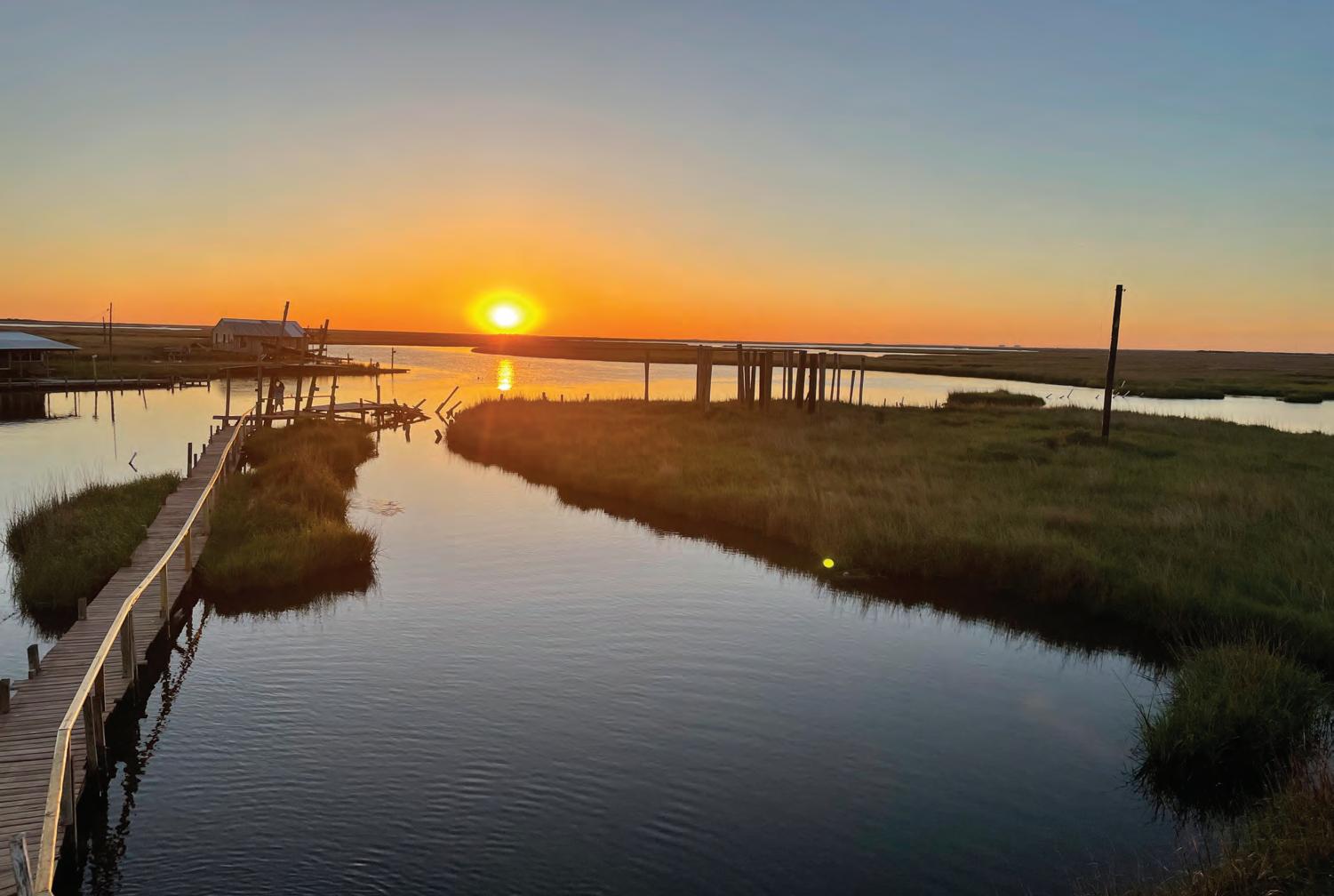
It’s here where Perrin and his chocolate lab host Da Bayou Experience, a right-on-the-water accommodation offering air-conditioned rooms, three gourmet meals a day, and round-theclock fishing. With enough room to sleep eight to ten people comfortably, Perrin hosts a wide variety of groups. The Cedar and Poplar Rooms each offer bunk beds, with their namesakes lining the walls, and both the indoor and outdoor dining areas can seat a crowd. The main attraction here, though, is the water’s edge access to unbeatable fishing.
Perrin’s parents drove the first pilings on this property into the Grandpaw Bayou in 1969, and the original camp
seventies and early eighties, they went through the process of raising it back up.
“We were weekenders back then,” said Perrin, who grew up on the Mississippi River’s West Bank but spent much of his childhood exploring the bayous around his parent’s camp. “I used to swim all day, and I burned five gallons of gas a day in a little boat I drove around.”
The house is just across the bayou from the Grand Bayou Indian Village, an unincorporated community historically occupied by the Atakapa-Ishak and Chawasha tribes, and the only continuous Indigenous community in the country that is only accessible by boat.
Perrin’s cook, Carmalita Sylas, lives in the village with her grandson, Monk. A former cook at Woodlands Plantation, Sylas’s culinary skills are legendary. She whips up three meals a day for Perrin’s guests, including a five-course dinner featuring a menu of local dishes like redfish couvillion, gumbo, a seafood platter, and shrimp and oyster croquettes—not to mention her decadent chocolate a la mode brownies and coconut pies.
Monk serves as Perrin’s deckhand
for his day job as a commercial crabber. Before Hurricane Ida, Perrin had seven hundred crab traps but now only maintains about three hundred. He checks them all twice a week and harvests around two thousand pounds per week. He sells exclusively to Lapalco Seafood in Gretna, except for the soft shells, which he offers to passing boats for $60 per dozen.


Perrin’s lived here full-time since 2014 but started up Da Bayou Experience in 2021. In addition to lodging, meals, and dock fishing, he also sets up charter fishing trips, commercial crab boat excursions, and shrimp harvesting experiences—and will even on occasion bring in a local band for his guests. Business has picked up in early 2023, and he’s hoping for a busy summer. But it wasn’t easy getting here. After only hosting four or five groups in his newly opened Airbnb, Hurricane Ida hit in August 2021.

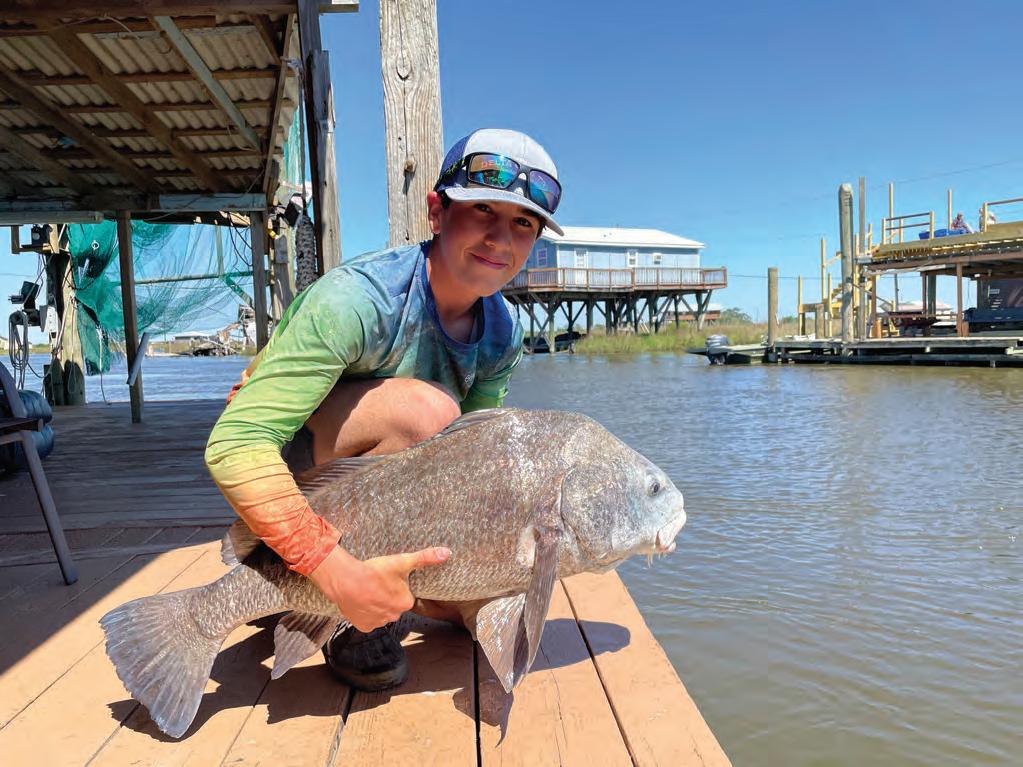
“It was heartbreaking to come out here after working for months to get it ready,” said Perrin. “I lost a whole roof section from the wind, and then there was a tenfoot tidal surge. Marsh grass was everywhere. I had to cut it up in squares with a chainsaw and pull it off with a boat. It
took me almost eight solid months to re build.”
Perrin couldn’t even visit the property until late September. There was no power or water, and the mud stuck like paste to everything on the property.
“It’s the only real enemy we have out here,” explained Perrin, who is no stranger to hurricanes. During Katrina, his home on the backside of Biloxi Bay filled with twelve feet of water, while Perrin was trapped in his attic with his parents. “It was a humbling, scary, pray-to-God experience. I’ve learned if a hurricane is coming and it’s named after a woman, you leave.”
We were only staying for the day, so in no time my oldest son Charles had four poles rigged up, ready to go. Showing us around the camp, Perrin walked past an alligator gar mounted on the wall, stretched and flattened like a throw rug, and brought us to a long sink already full of softshell crabs. A divider rigged down the middle separated out the molting crabs. Using tongs, he lifted a crab from the left bin and pointed to a thin red line on the back fin.
“The red-liners are close to shedding,” Perrin explained, moving the crab into
JUN 23 // COUNTRYROADSMAG.COM 50 OVERNIGHTER
shells, they grow a half to one full size larger. Within twenty minutes of shedding, they start to get papery. We have to check them every two hours to make sure they don’t harden. They’re very hungry during this stage, so we also have to watch them because they’ll eat every other soft-shell crab around them. Once they shed, we wrap them in cellophane and freeze them.”
He chose a crab from the left bin and laid it on a table. “Murder, she wrote,” he joked, as he chopped it in half and handed it over to Charles to use as bait. Within minutes, one of his lines went taut, and he quickly set the hook and began the laborious process of reeling in the hefty catch. Perrin and his two friends gathered around to watch the battle unfold. Finally, Charles hoisted his twenty-four-pound black drum onto the dock. Only minutes after the fish was released, he reeled in a thirty-three pounder.

“When the fish are here, we catch them,” said Perrin. “There’s a huge oyster reef here, so that’s why the fish come. I just had a group—they caught 417 pounds of drum in two days."


It’s all catch-and-release off the deck— though there is one exception to this rule.


At the annual Wounded War Heroes Fishing Rodeo every summer, Perrin allows his black drum “pets” to be taken. For the last eleven years, the first, second, and third place winning fish were caught off his dock.


Perrin explained that Grandpaw Bayou is a “natural flow” bayou, with the tide turning in under twenty minutes. As we examined the shallow water on the backside of his dock, we saw five crabs scurrying through the mud with a school of minnows darting in between their sharp claws. In the fall, the water is filled with trout.

“This area is a fertile incubator for all seafood,” said Perrin. “They are all born and raised in these estuaries before they travel to the Gulf.”
We bided our time until sunset, walking the pier and swinging in the breeze while watching a towering cruise ship leave out the Mississippi. It was an overwhelming feeling of time slowing down at this watery home on the edge of civilization. As Perrin drove us back to shore, he commented that the worst part of coming here, was having to leave. •

//JUN 23 51
680 Jefferson Highway, BR, LA 70806 • 225-924-6437 • Elizabethangallery.com Elizabethan Gallery More Than Just A Frame Shop ONE DAY FRAMING AVAILABLE Dad’s Favorite
Prints DAD’S FAVORITE PASTIMES Music, Sports, Hunting... Artwork Any Dad Is Sure To Love. Jazz Fest 2023, signed and unsigned Frame that special family photo! EUROPEAN RESTAURANT A BATON ROUGE TRADITION SINCE 1962 3056 Perkins Road 225-387-9134 Open Monday-Saturday Call for Hours dabayouexperience.com
Hobby

JUN 23 // COUNTRYROADSMAG.COM 52
Merchants Baton Rouge, LA Allwood Furniture 23 Arts Council of Greater Baton Rouge 7 Becky Parrish Advance Skincare 41 Blue Cross Blue Shield Louisiana 16 Calandro’s/ Select Cellars 11 East Baton Rouge Parish Librar y 56 Elizabethan Gallery 51 Louisiana Public Broadcasting 45 LSU Museum of Art 3 LSU Rural Life Museum 30 Manship Theatre 9 Opera Louisiane 30 Pennington Biomedical Research Ctr. 43 Pinetta’s European Restaurant 51 WRKF 89.3 FM 40 Belle Chasse, LA Plaquemines Parish Economic Development 40 Brookhaven, MS Brookhaven Tourism Council 26 Donaldsonville, LA River Road African American Museum 21 Ferriday, LA Brakenridge Furniture 27 Grand Isle, LA Grand Isle Tourism Department 45 Hammond, LA Tangipahoa Parish CVB 55 Houma, LA Explore Houma 14 Jackson, MS Visit Mississippi 5 Lake Charles, LA Visit Lake Charles 35 Louisiana Food and Wine Festival 25 Lafayette, LA Allwood Furniture 23 J & J Exterminating 33 SouthStar Urgent Care 12 The Hilliard University Art Museum at the University of Louisiana at Lafayette 34 Livingston, LA Livingston Parish Library 51 Mandeville, LA St. Tammany Parish CVB 17 Mansura, LA Avoyelles Arts Council 47 Avoyelles Tourism Commission 20 Morgan City, L A Cajun Coast CVB 26 Natchez, MS Katie’s Ladies Apparel 51 Monmouth Historic Inn 18 Natchez Chamber of Commerce 19 Visit Natchez 27 New Iberia, LA Iberia Parish CVB 31 New Orleans, LA Historic New Orleans Collection 13, 53 New Orleans Public Library 15 New Roads, LA City of New Roads 39 Pointe Coupee Parish Office of Tourism 28 Opelousas, LA St. Landr y Parish Tourist Commission 34 Plaquemine, LA Iber ville Parish Tourism Department 6 Port Allen, LA West Baton Rouge Museum 47 West Baton Rouge CVB 22 Scott, LA Bob’s Tree Preservation 39 Sorrento, LA Ascension Parish Tourism Commission 41 St. Francisville, LA Birdman Cafe 37 St. Francisville Food and Wine Festival 10 The Corbel 2 Town of St. Francisville 37
Directory of
The New Orleans Antiques Forum 2023
MUSIC TO MY EYES
MATERIAL CULTURE OF SOUTHERN SOUND

Attendees of the 2023 New Orleans Antiques Forum will be immersed in the objects and art that embody the development of “southern sound.” Sessions will explore the material culture of parlor entertainment, First Nations social dances and storytelling, musical furniture, early country and western costumes, nineteenth-century opera in the French Quarter, and much more.
Visit hnoc.org/antiques for details.
SPONSORED BY Hotel Monteleone Hederman Brothers History Antiques & Interiors Keil’s Antiques
& Laborde Moss Antiques Arbor House Premium Parking
// JUN 23 53
LaFleur
AUGUST 3 – 6, 2023 • THE HISTORIC NEW ORLEANS COLLECTION
Sponsored by Tangipahoa Parish Tourism
PERSPECTIVES: IMAGES OF OUR STATE “There’s so Much Life”
MEMORIES OF LOUISIANA WILDS, POSED WITHIN ARTIST MICHAEL GUIDRY’S PROCESS
By Jordan LaHaye Fontenot
The first time Michael Guidry was ever called a “Louisiana nature artist” was the first time he submitted his work for consideration as a visual artist at the New Orleans Jazz & Heritage Festival. “They sent me back the contract, and described my work as ‘Louisiana Nature Paintings,’ And I freaked out. I was like, ‘No, that’s not what I do.’”
But it was, sort of, what he had been doing. He had just completed his first solo exhibition as an artist at the now-defunct Moxy Gallery, titled Out of the Marsh, featuring a series of paintings engaging with materials and moments from Guidry’s fishing camp in Lafourche Parish. The series had been inspired by a clump of marsh grass he’d brought home from one of his frequent excursions. “We anchored, and I was right in the middle of the marsh grass, and it was probably autumn, and it was all maroons and blues.” On his way home, he dug up some of it to bring back to his studio.
At the time, Guidry was approaching painting as he had while in school at the New Orleans Academy of Fine Arts: portraits and studies, experimenting with style. “And little by little … my art interests started showing up in my work,” he said.
This painting, nostalgic in its stillness, its simplicity—a chunk of mud pulled from its environment, held together by a thrush of marsh grass, roots jutting out— struck him. It inspired him to return to the marsh, again and again—but this time, as an artist.
Though he still to this day resists the restrictions of being defined a “Louisiana nature artist,” his paintings have continued to draw him back to the fishing boat, and all it promises. “After a few years, I just sort of owned it,” he said. “It’s just … I really love being out there, spending time out there. But then now doubly, thinking about what I’ll create.”
Today, Guidry’s depictions of nature have evolved considerably from that original marsh clump—his most recent bodies of work jumping from the canvas in a compelling marriage of compositional formality and brilliance in color. An albino alligator, and all of its scales, against a stark cobalt turquoise backdrop, mouth open as though ready to chomp down upon the three dragonflies fleeing from the frame. A blue heron, posed like a dancer, with frogs clenched in its beak and in its claws, leaping and diving into the water all around it. Birds of all sorts—pelicans, black necked stilts, white egrets, belted kingfishers—all in flight against a blue-purple sky, all headed in the same direction.
“I go out there and get lost, like literally lost,” he said. “I’ll sit out in the middle of the duck pond, and just kind of wait for stuff to start happening. You can pull into the middle of one of those little environments, and at first it seems like nothing is going on, but if you wait around, you start noticing that there’s so much life.”
Inspired by the style of ancient Egyptian art, once Guidry finds his subject and positions its pose, he returns to it again and again. Butterflies flying from the gator’s mouth instead of dragonflies; or its white scales shifting to pink, or green, or rainbow. “If I take my time and do a pose for something—I’m usually taking composite images, developing one little pose—every time I go back to that subject, I want to use the same one, and just sort of develop it a little further. That pleases me.”
The stiff regularity of Guidry’s work is infused with the vibrant cant-look-away life of his color palettes, which actually evolved first from his efforts to use less color. “I wanted to simplify my studio,” he said, “and was trying to work from a very limited palette, and just do like four colors, and mix everything.” This led him to start studying paint, and traditional color palettes, and color theory, and pigments. “So then I started making my own pigments, and experimenting with new colors and textures, and that kind of got out of hand,” he said, laughing. “I was making paint all the time and ended up with way more colors. But I enjoyed it, so I went with it.”
Over the decade of painting Louisiana nature scenes, Guidry is no longer just painting intriguing things he sees in the Lafourche wild. “I feel like I’ve started putting things together, trying to tell these little stories,” he said. “It registers more as sort of memories than fixed scenes.”
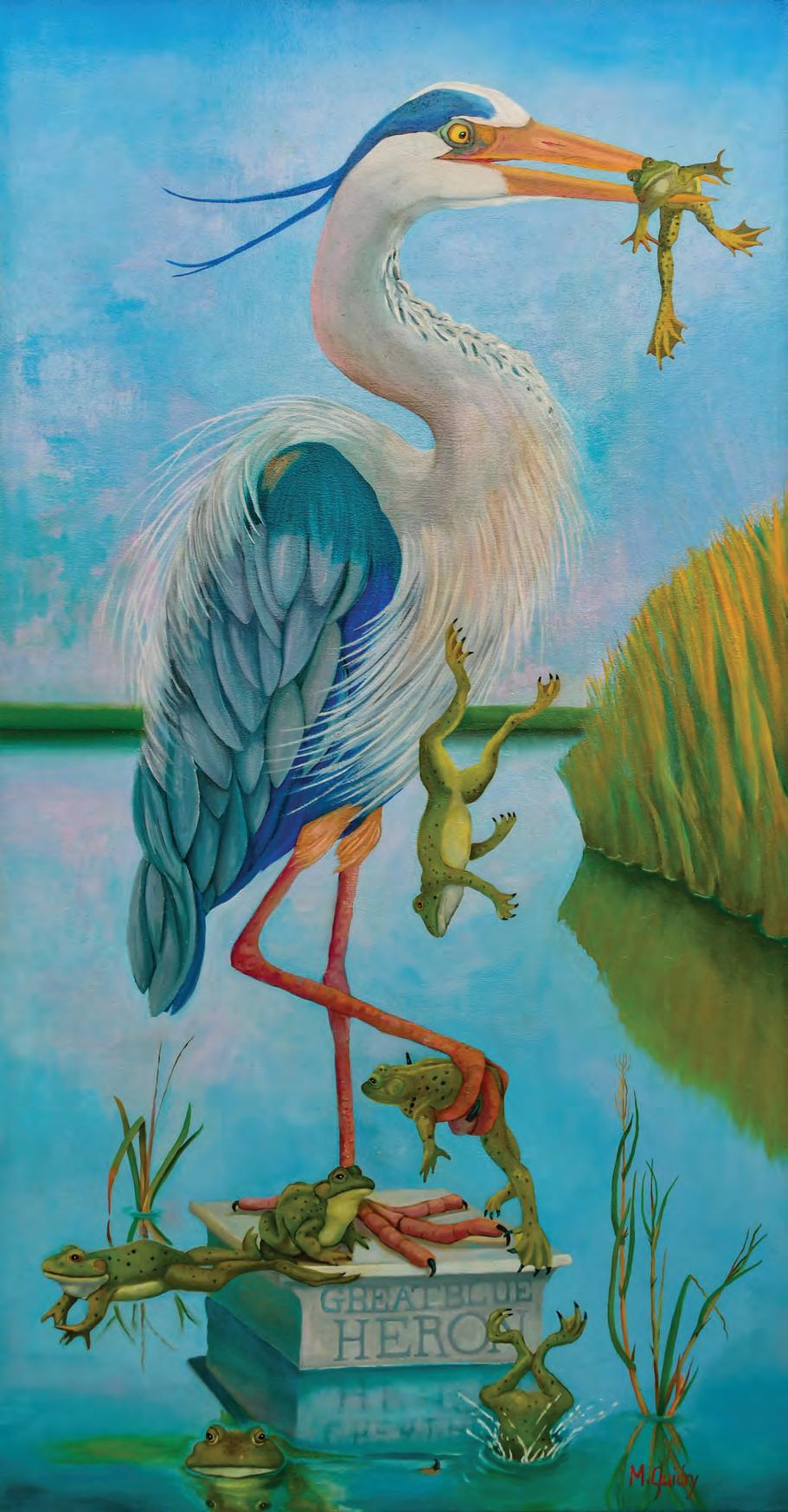
An example he uses is the origin of many of his birds-in-flight scenes. “I was just cruising down this little windy bayou, and I turned this corner, and disturbed a rookery. And like five different species of birds just started taking off and flying, and it was like in slow motion, because I was kind of going the same speed that they were.” He said that he didn’t think much of it in the moment, didn’t think ‘Oh, I should paint that,’ or anything. And months later, a painting emerged, triggering the memory. “Like . . . that has to be where this came from,” he said. The birds had lived in his subconscious, altogether, always in flight, waiting to arrive on the canvas. •
michaelguidrystudio.com
JUN 23 // COUNTRYROADSMAG.COM 54
Michael Guidry. “Jeu de Grenouille.”

// JUN 23 55










 Christiansen
Christiansen






























































































 By Christopher Staudinger
By Christopher Staudinger




























































































































